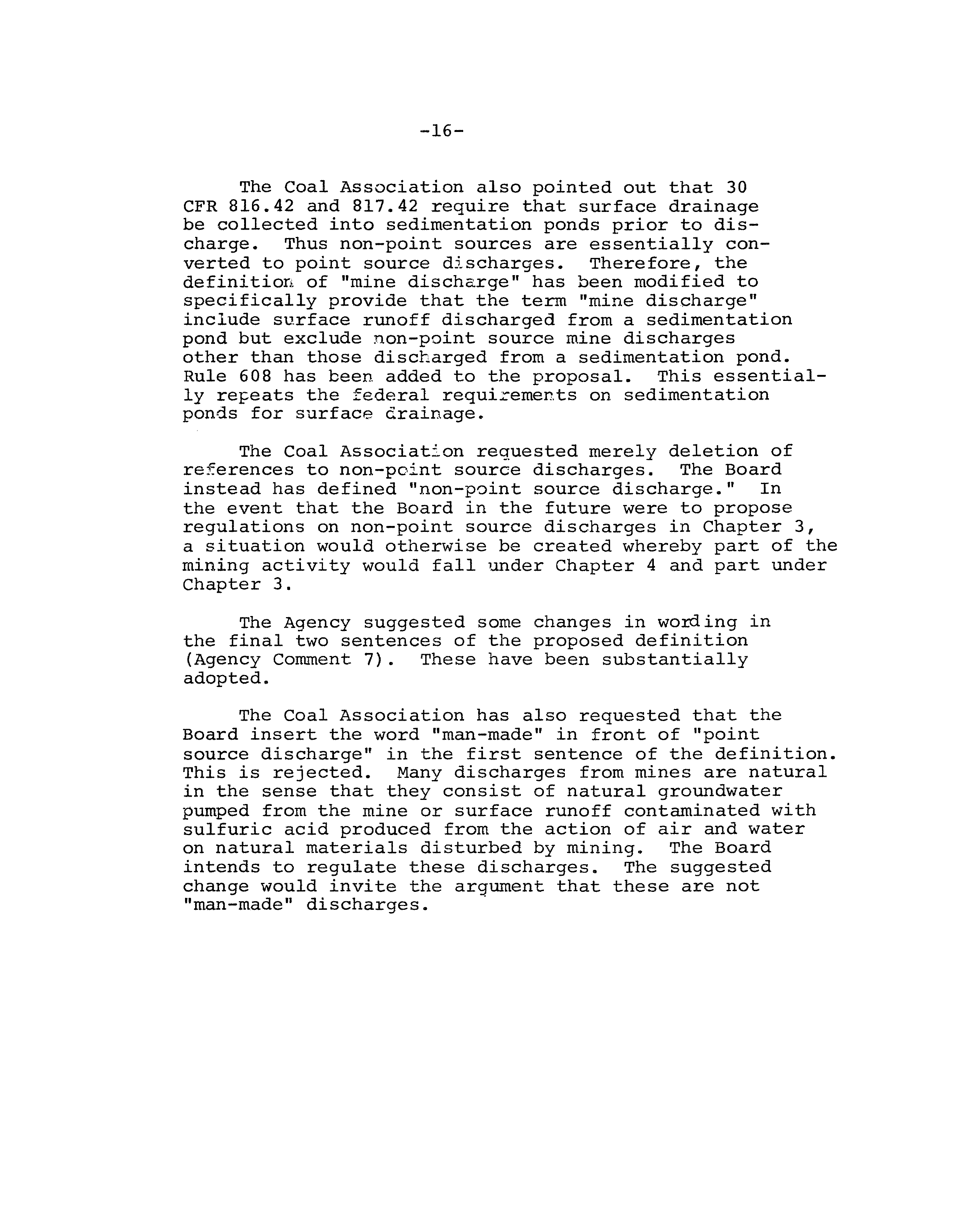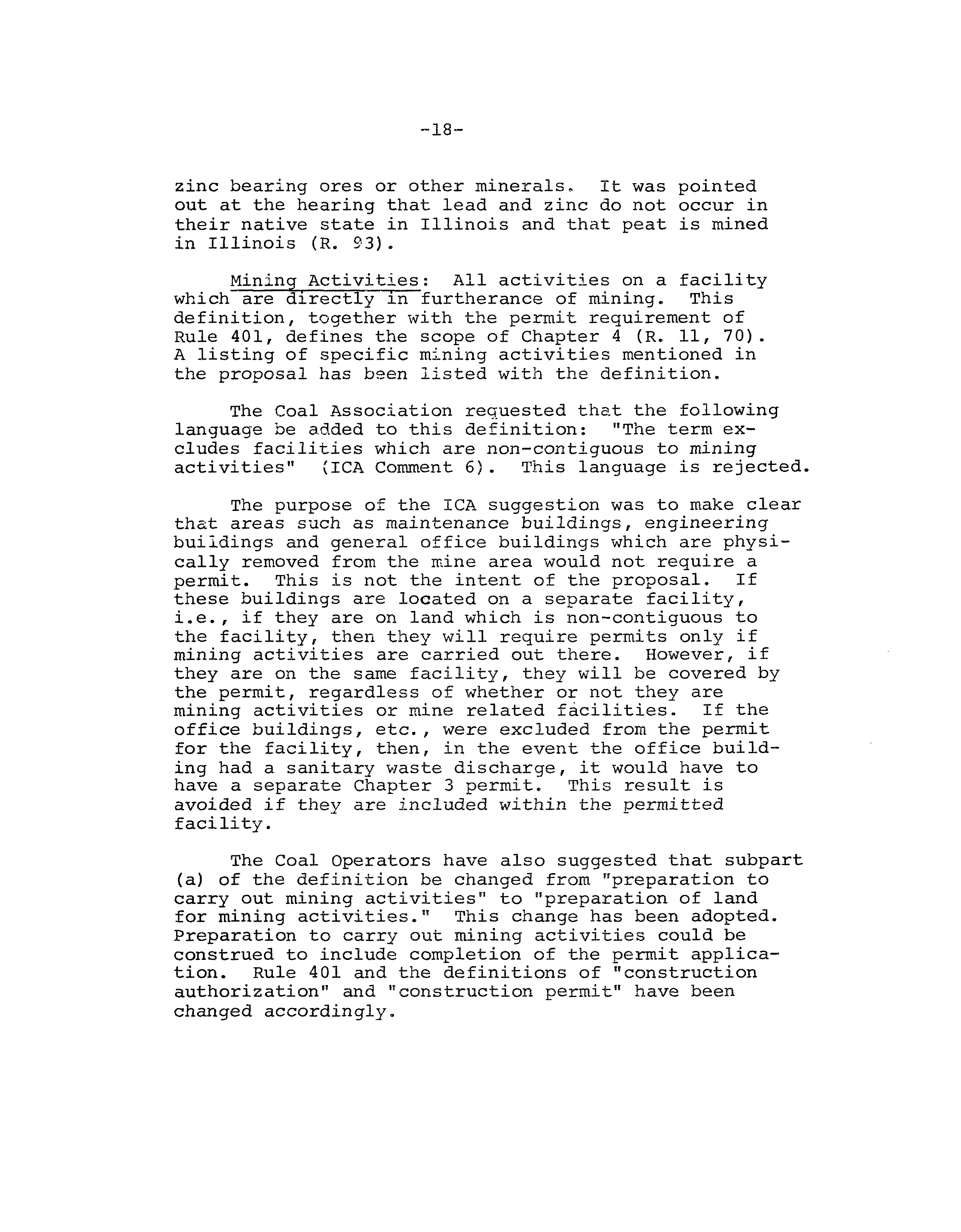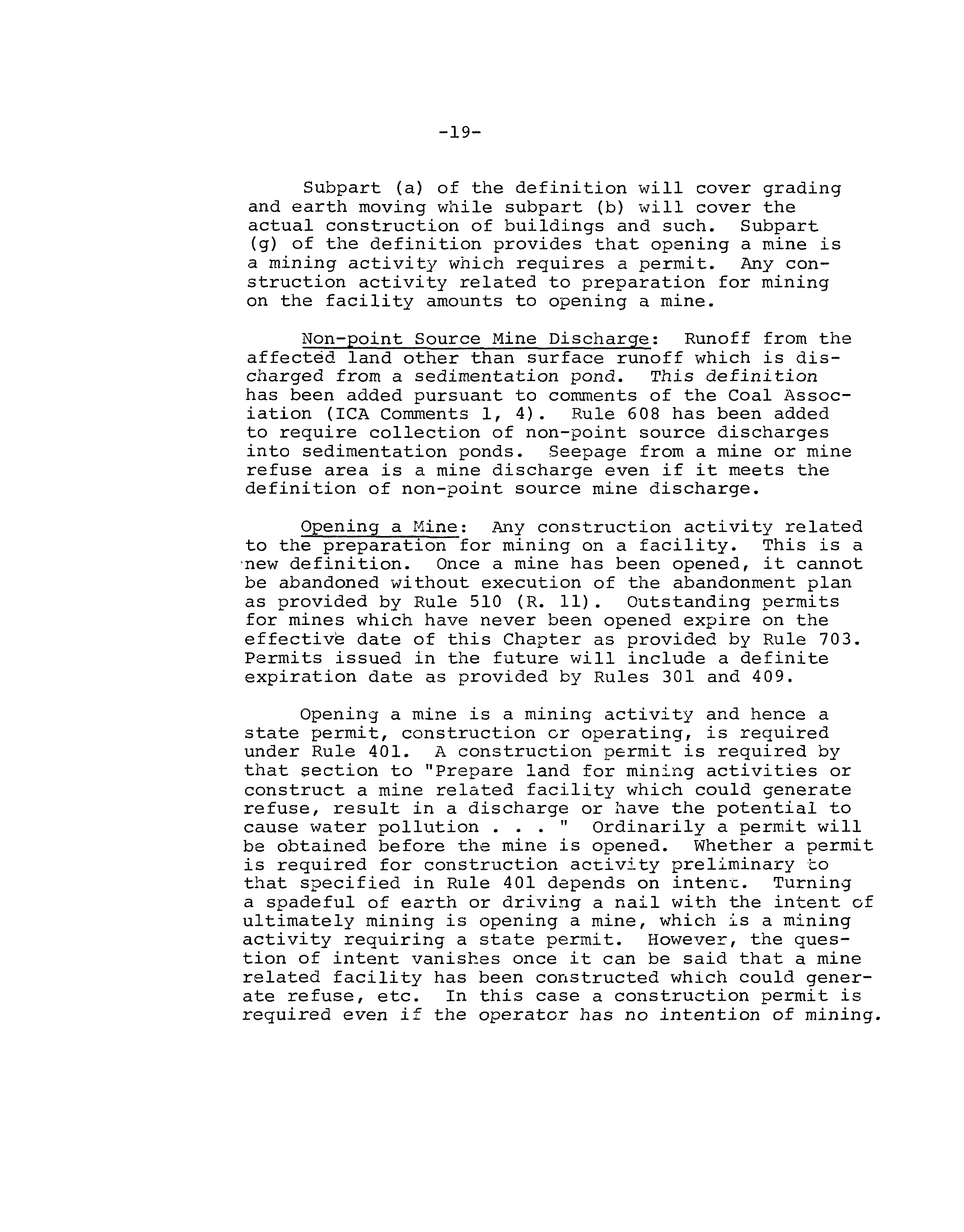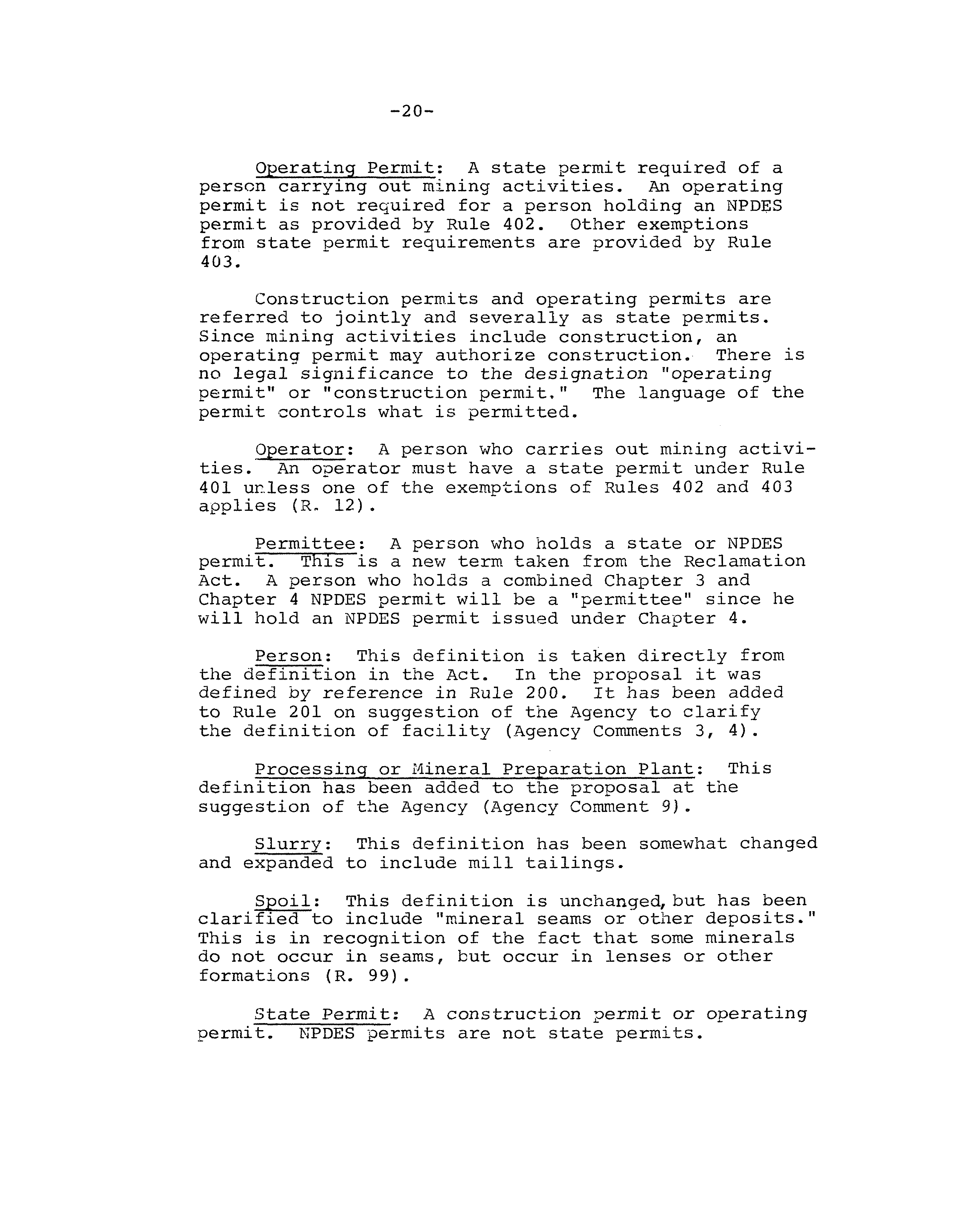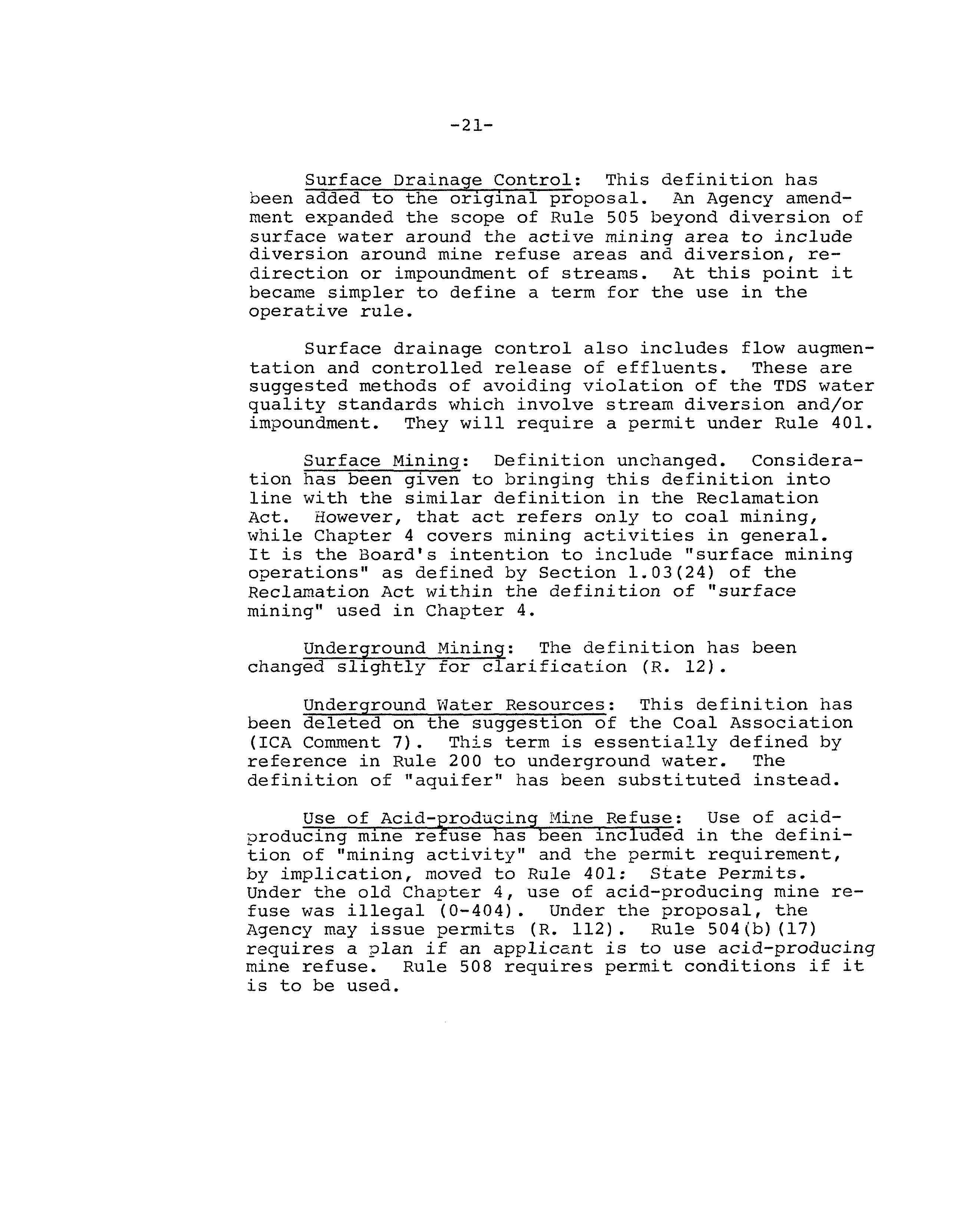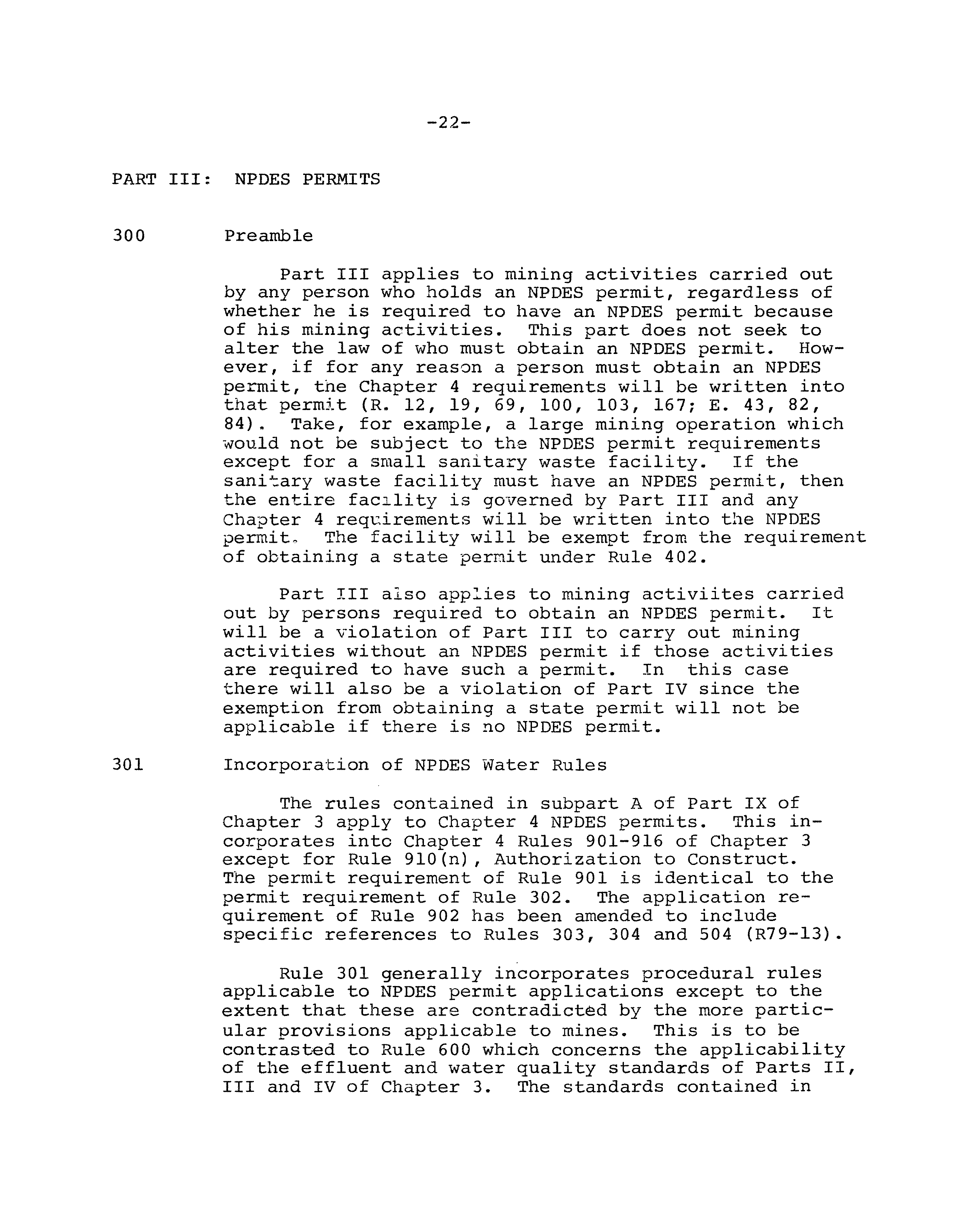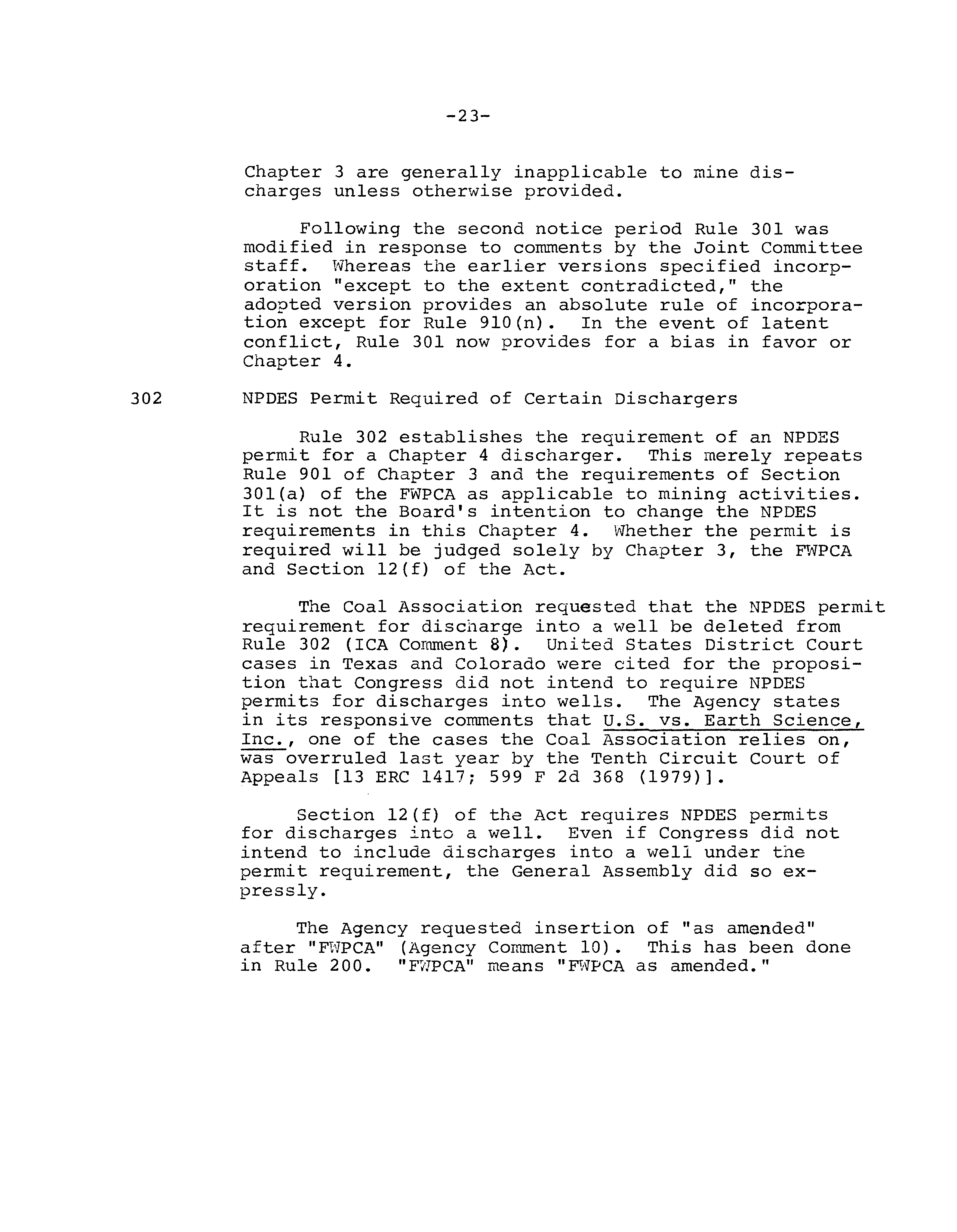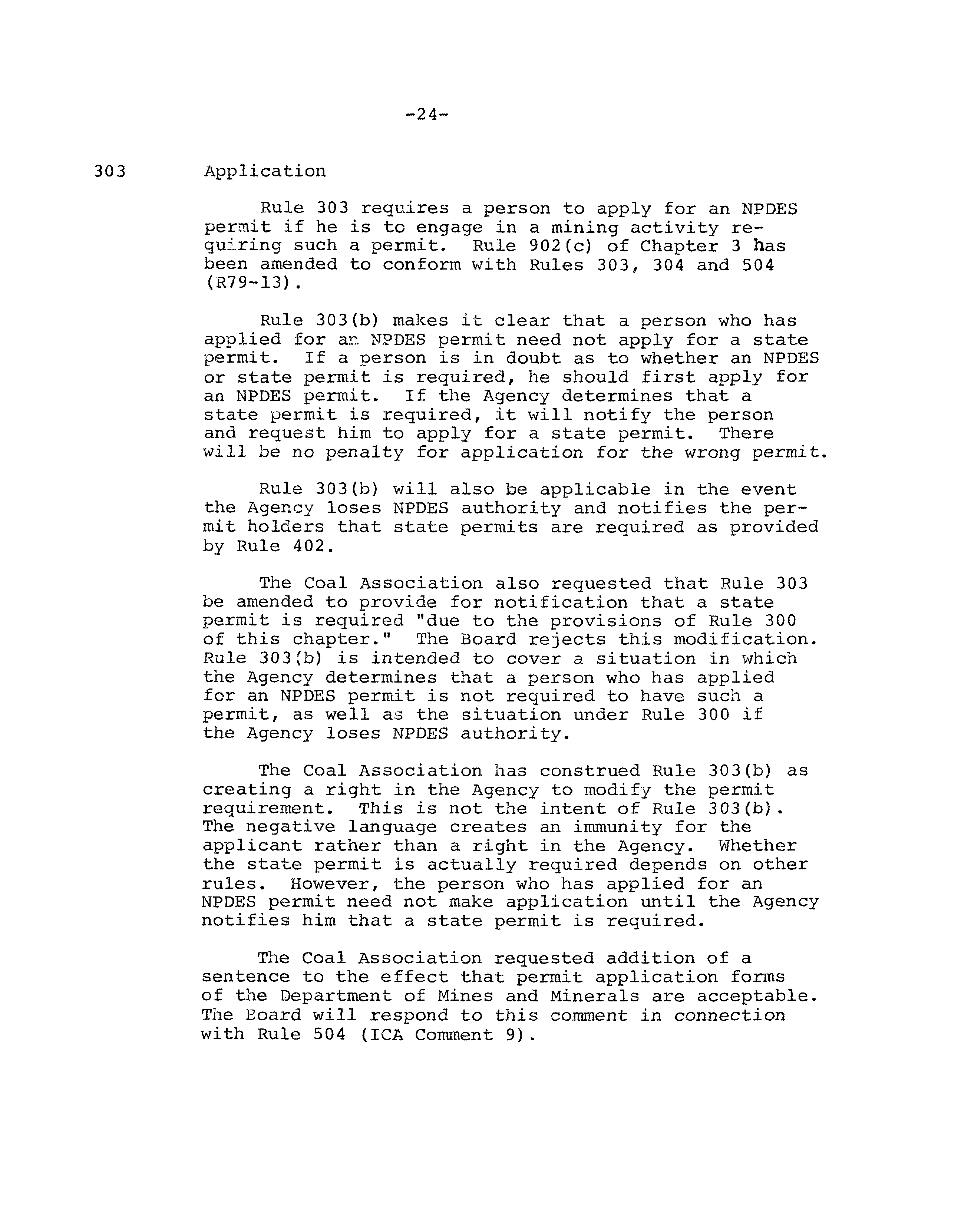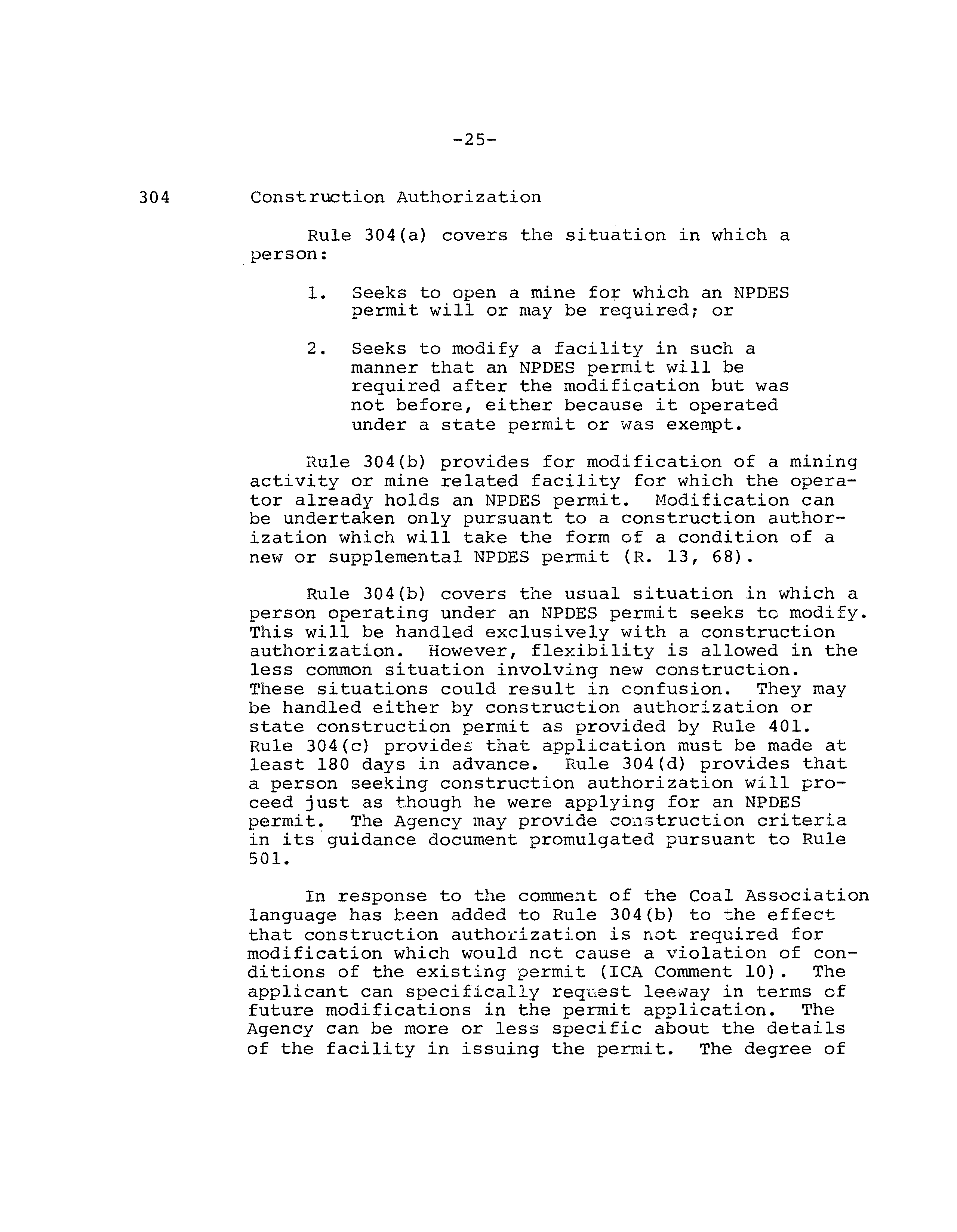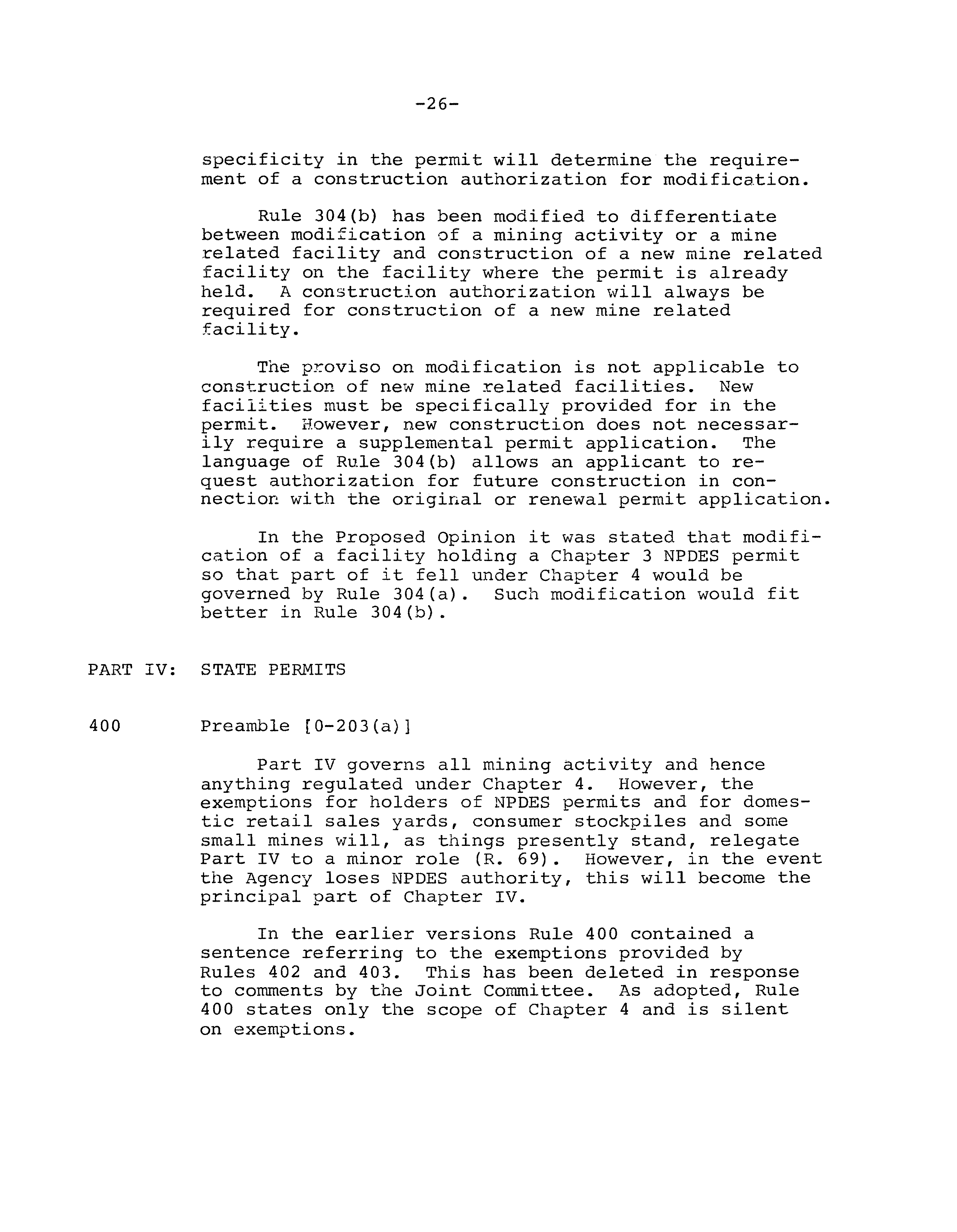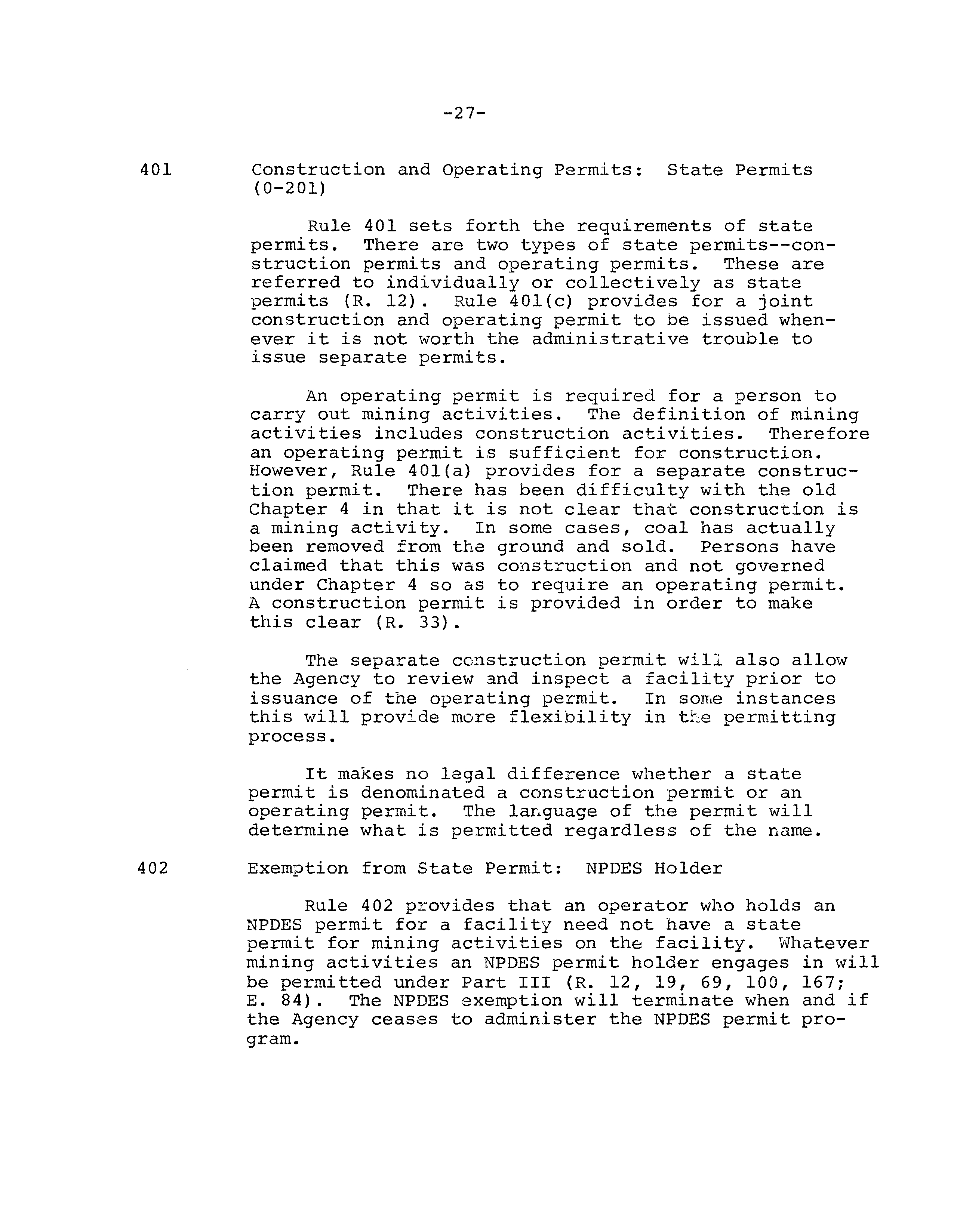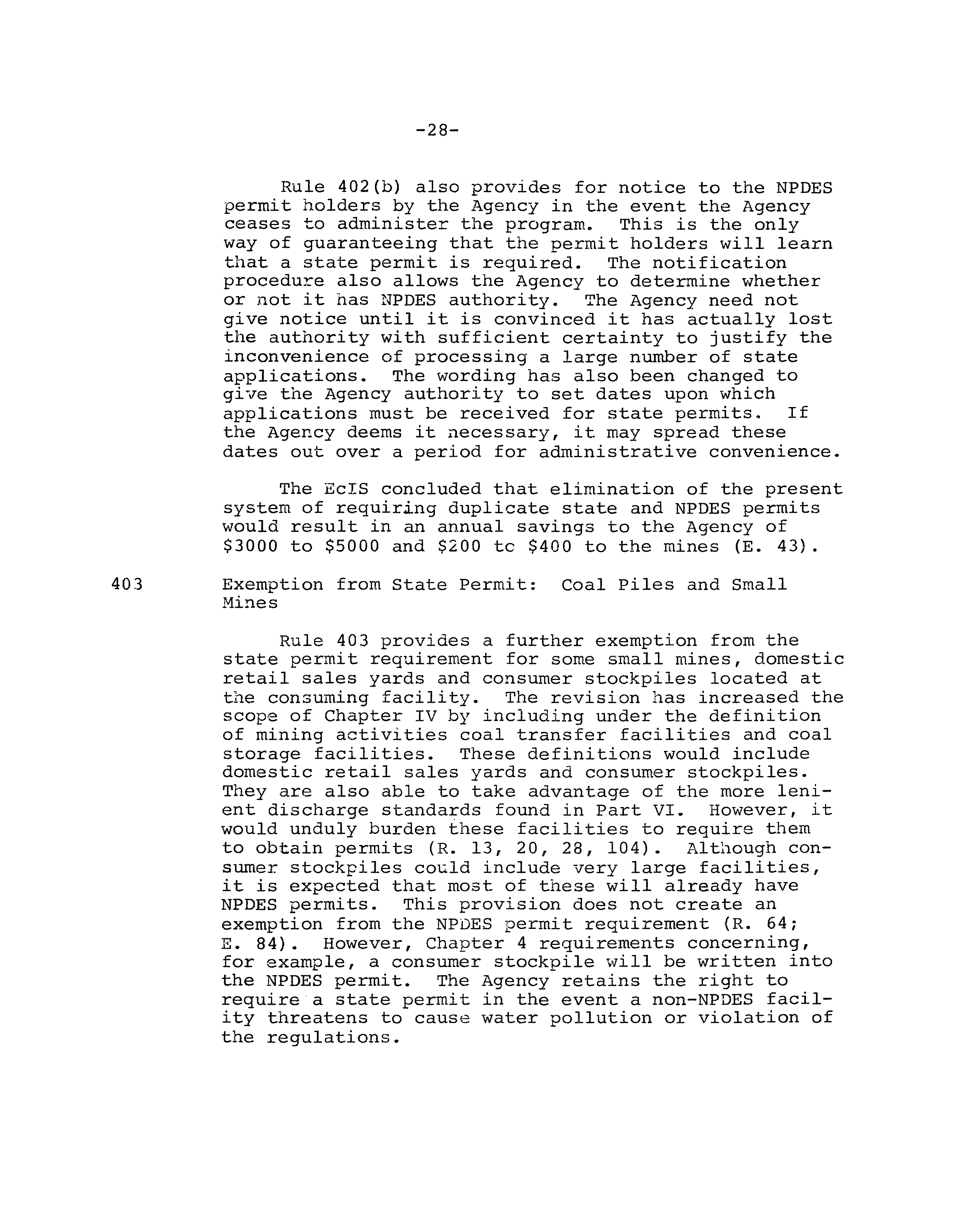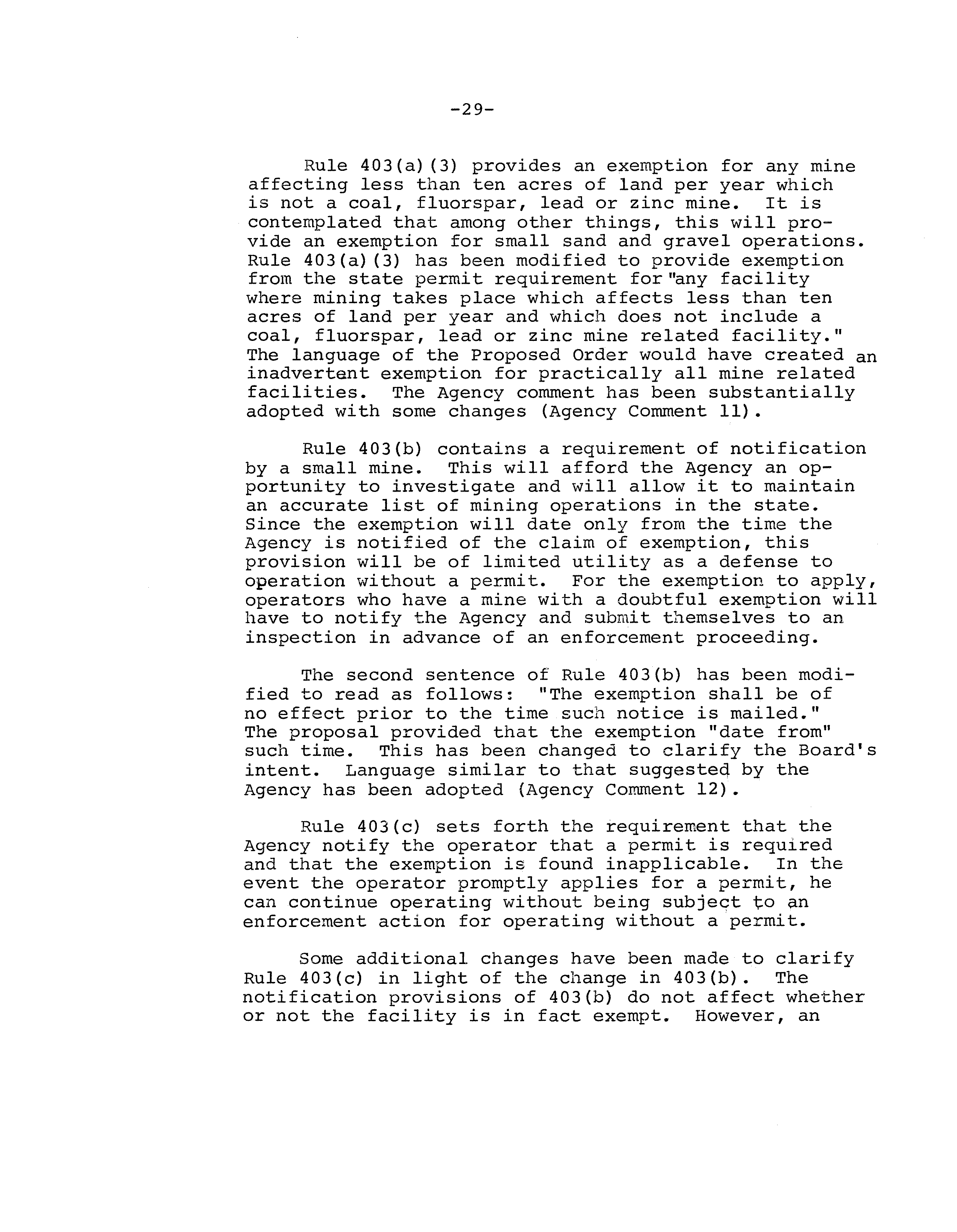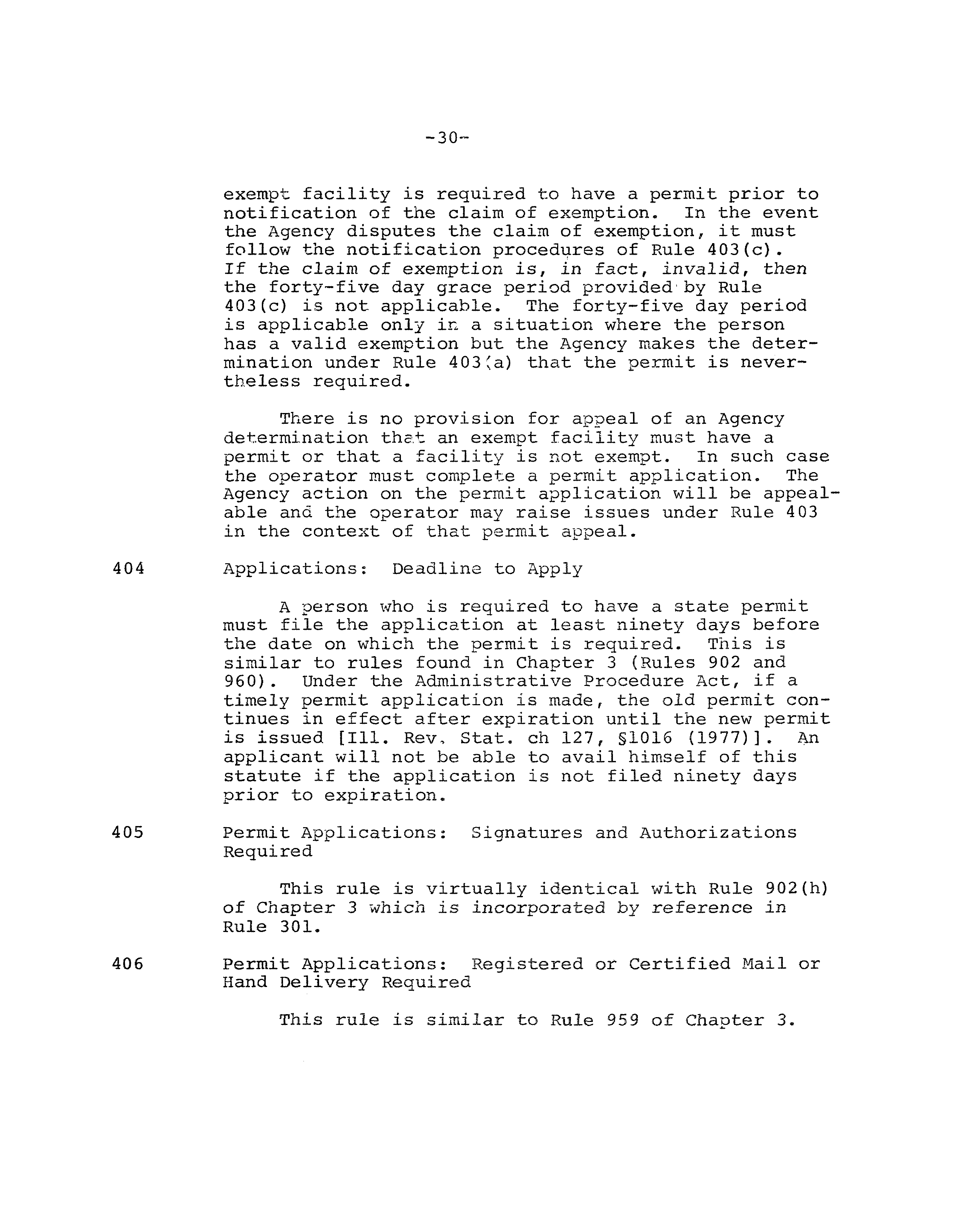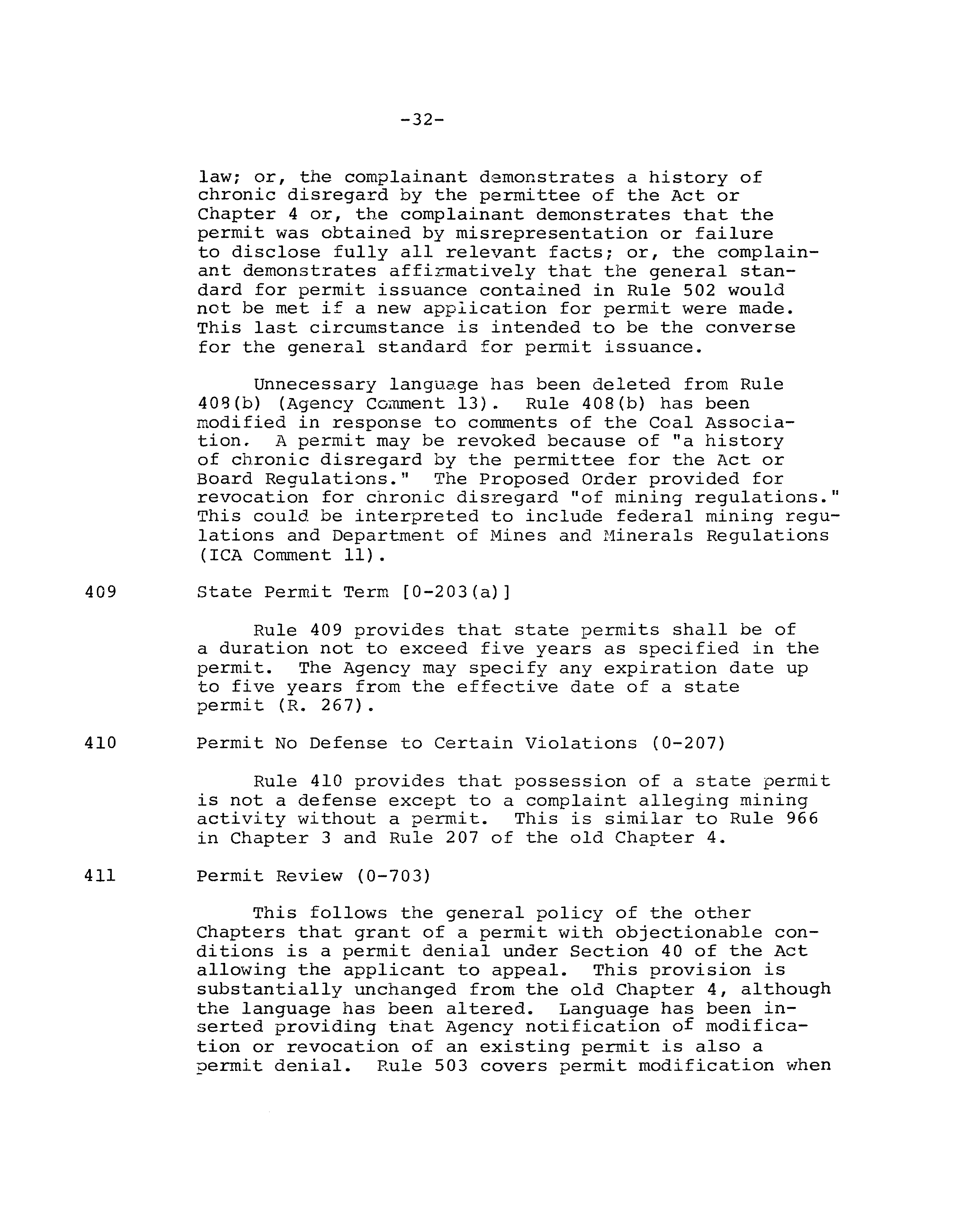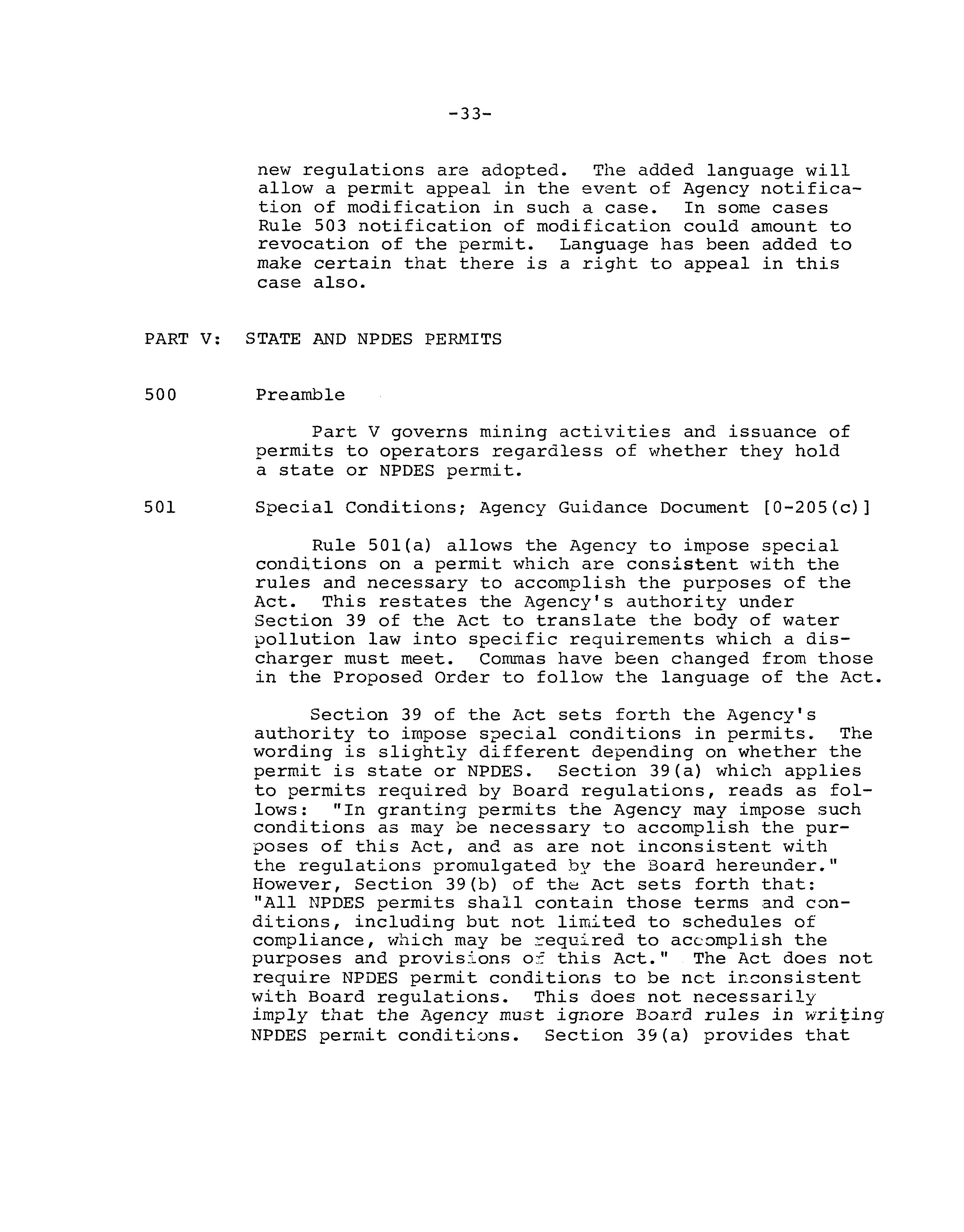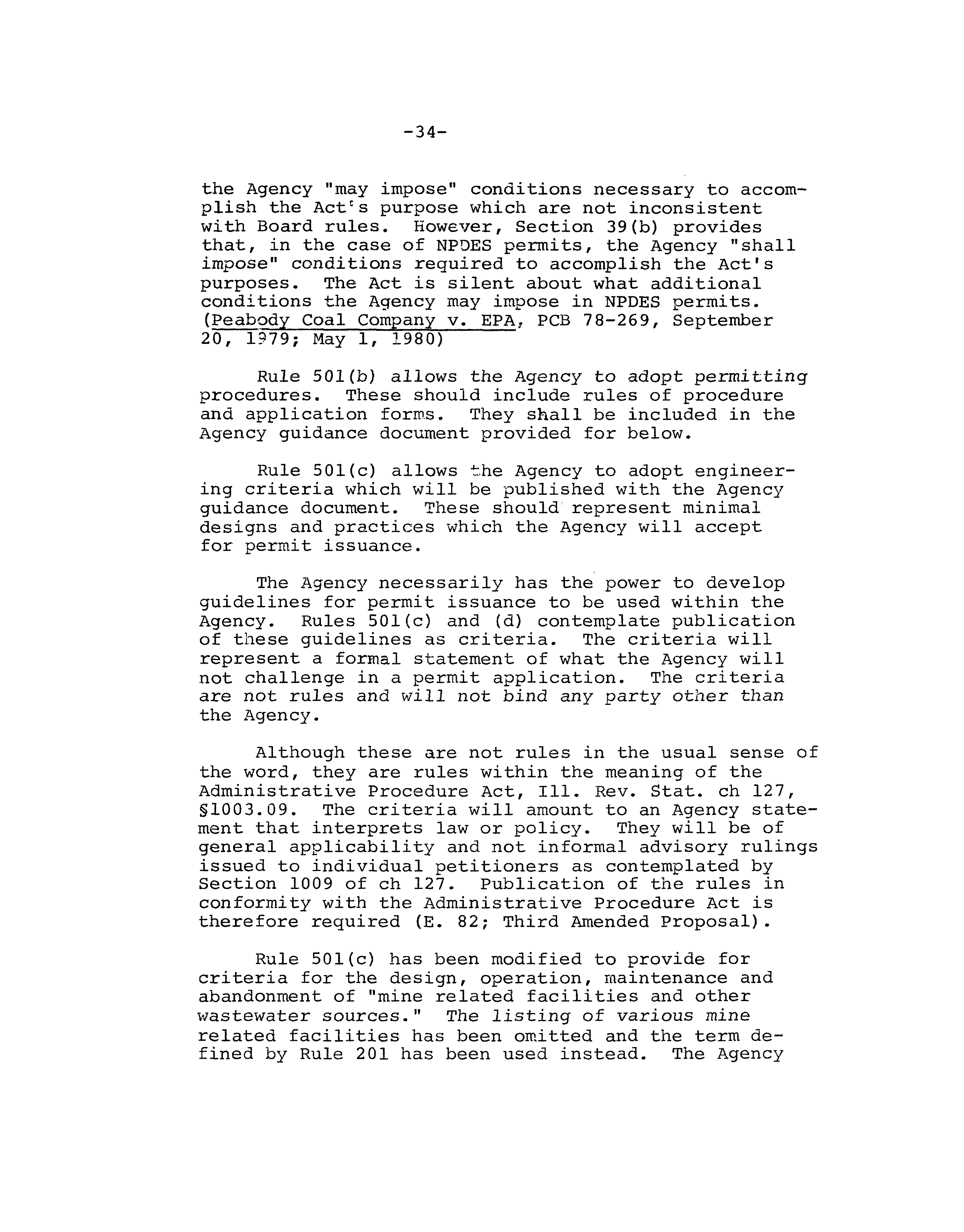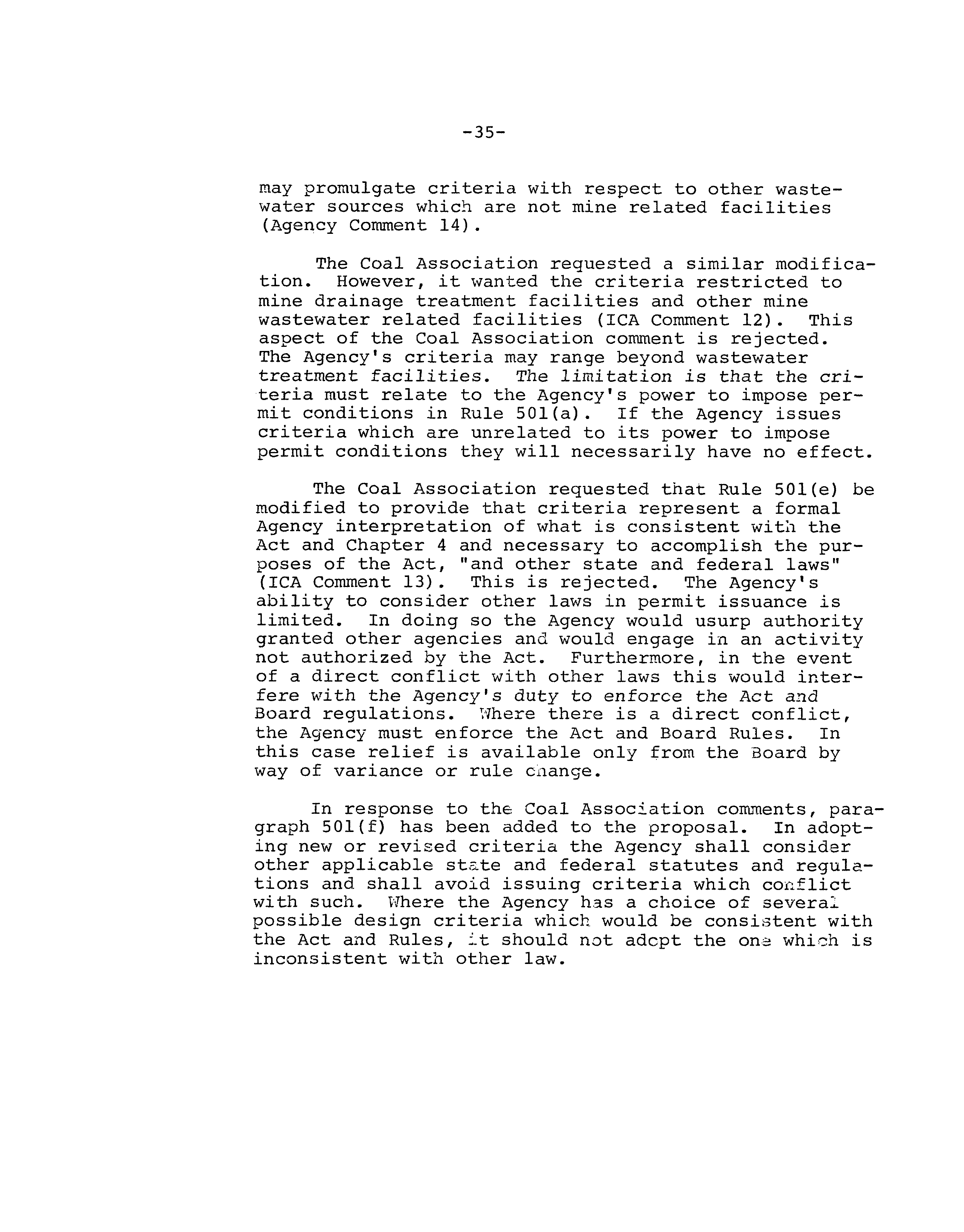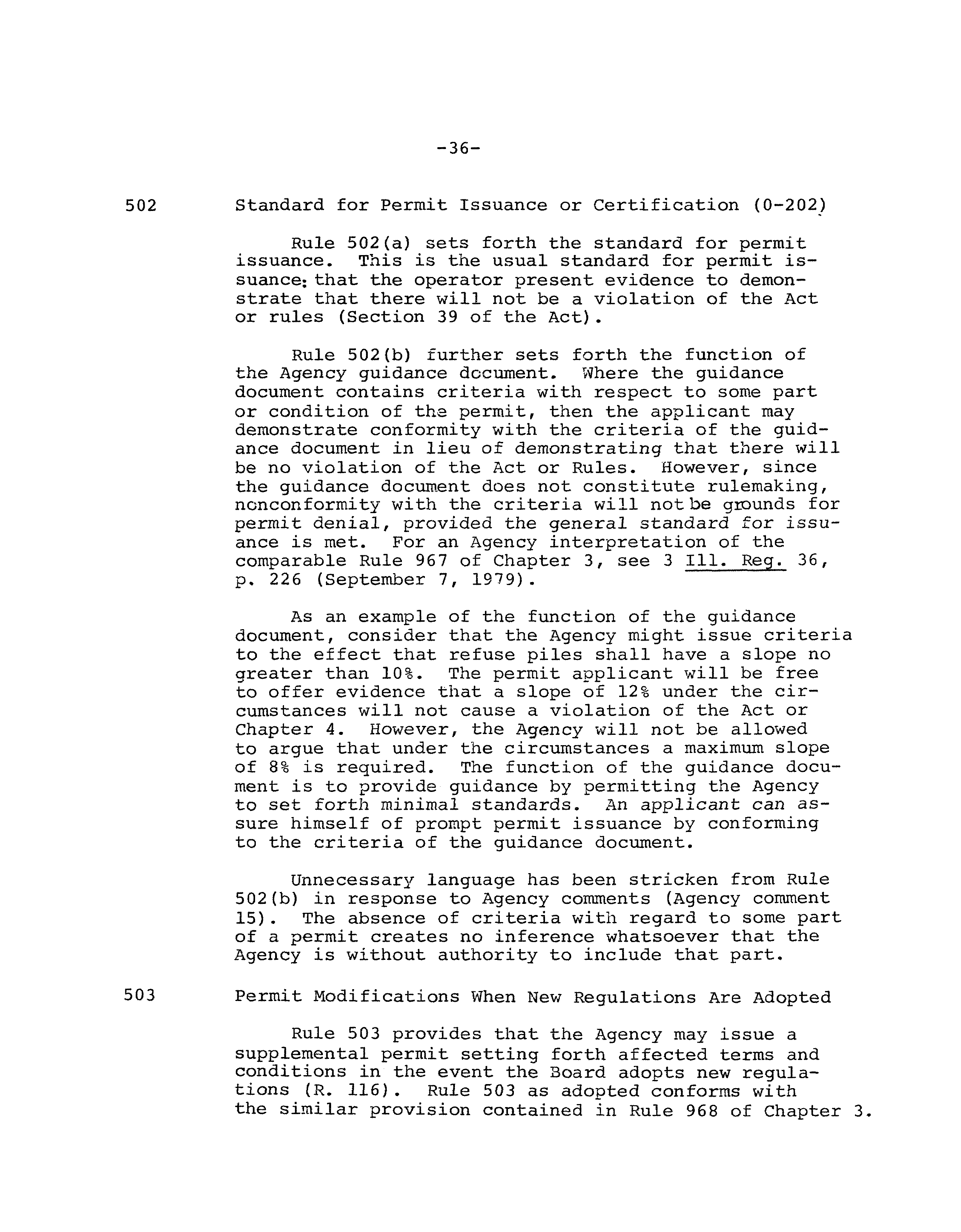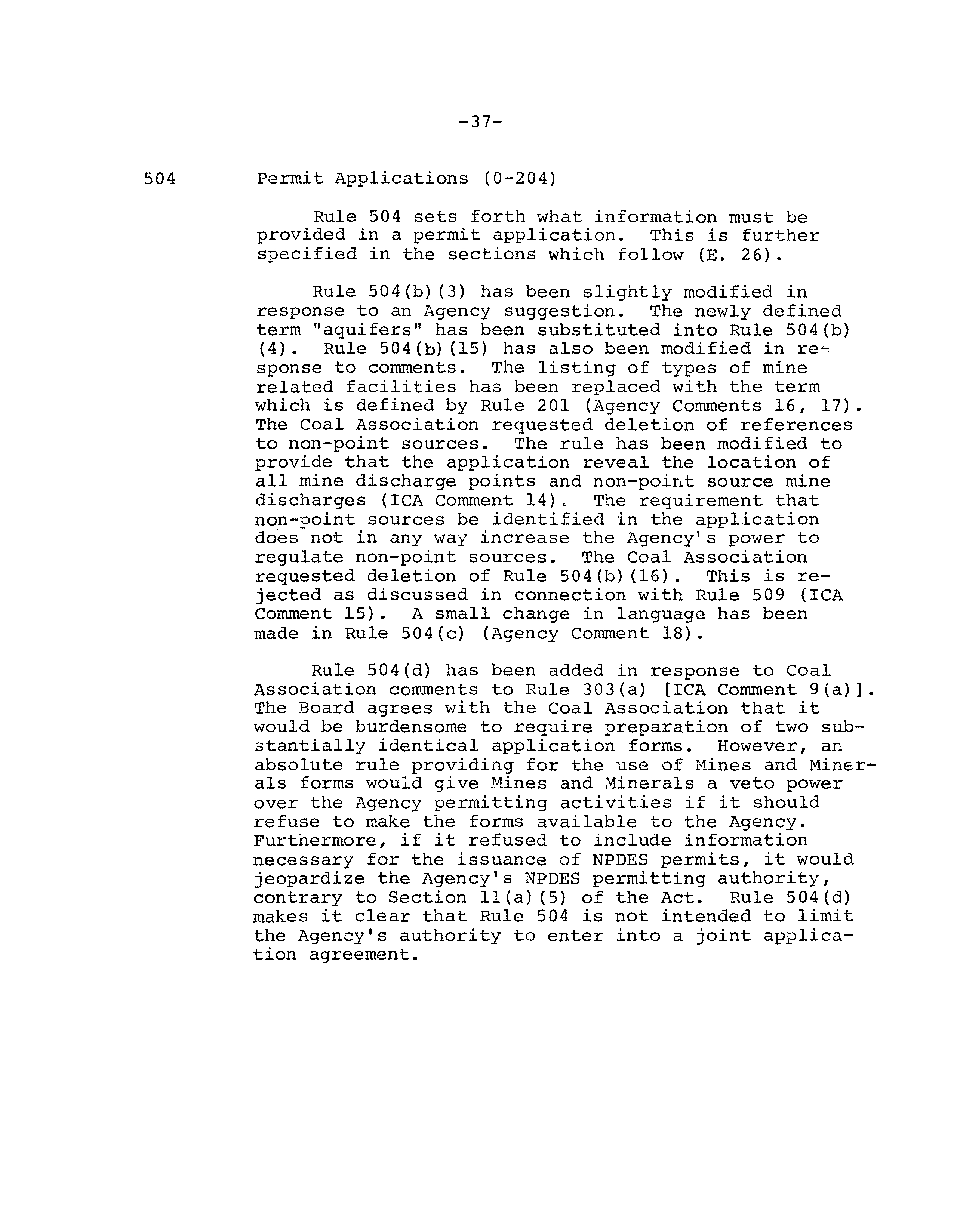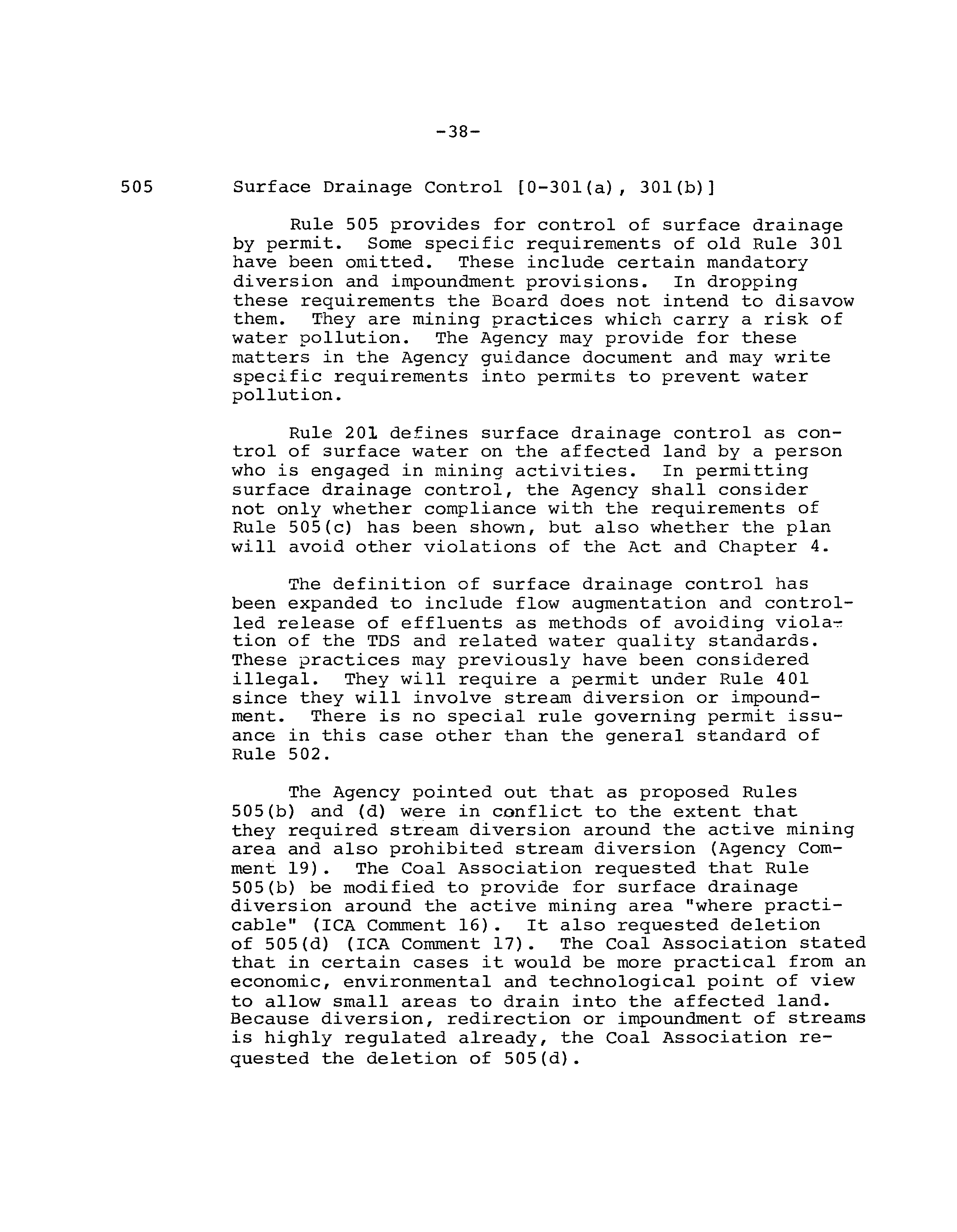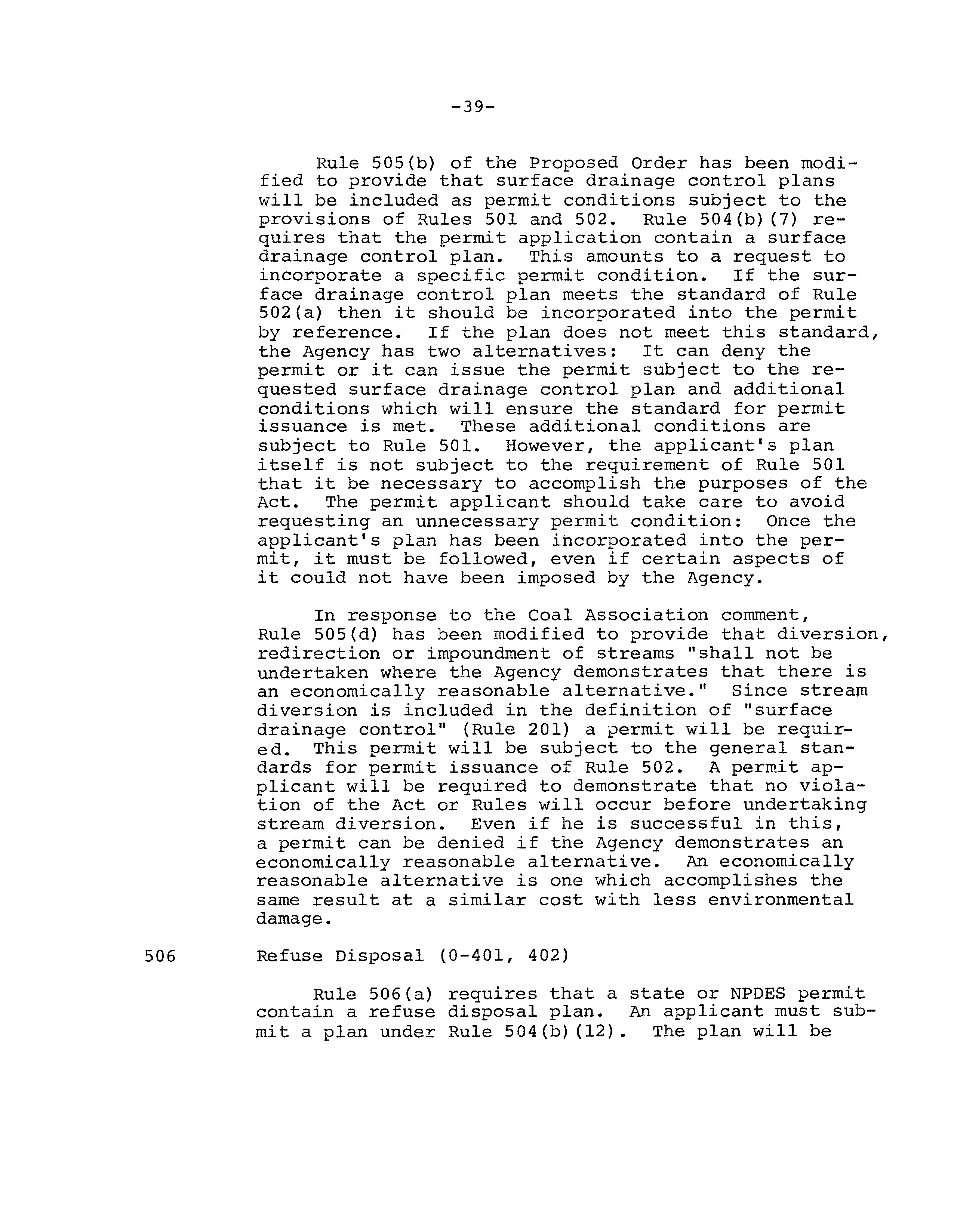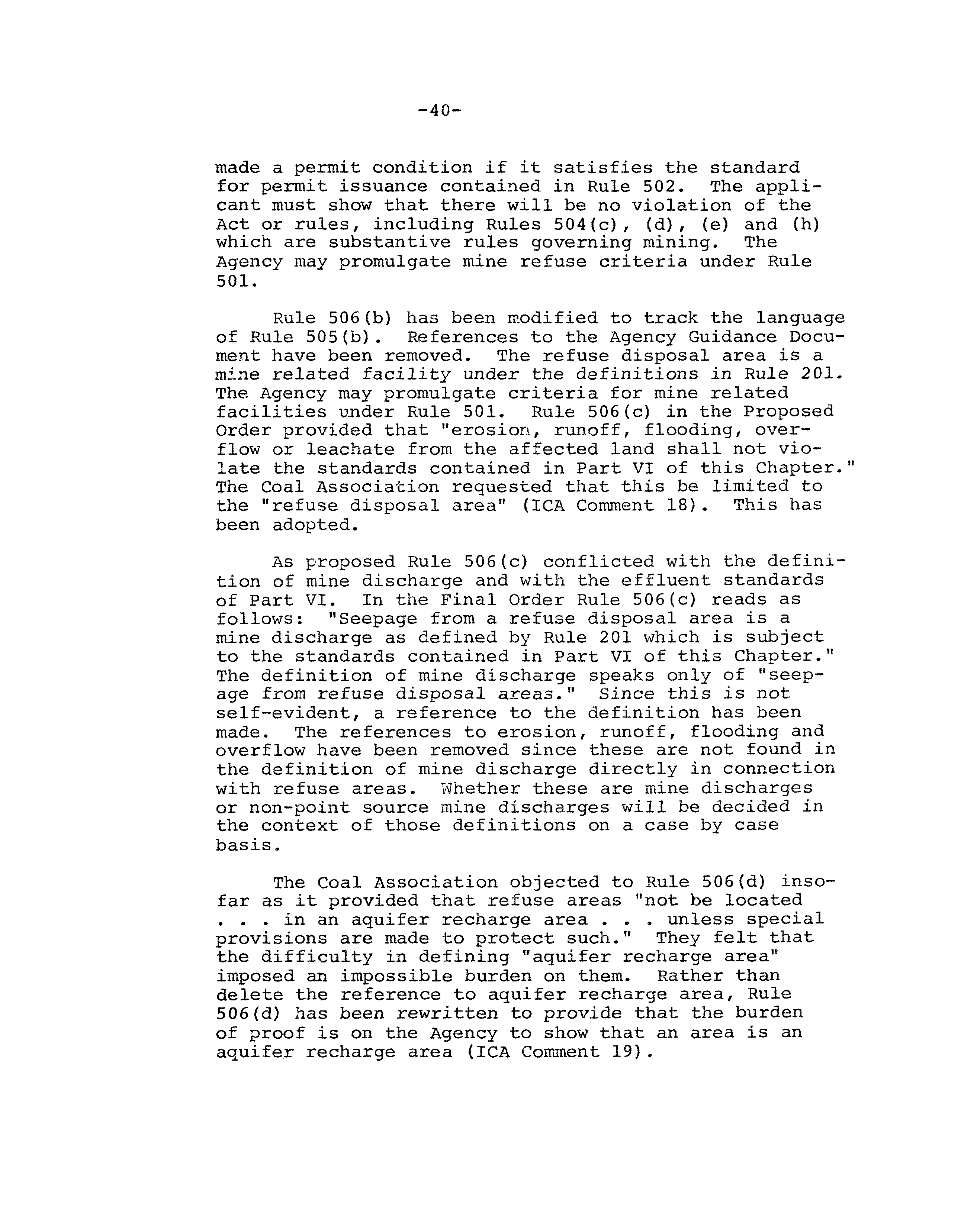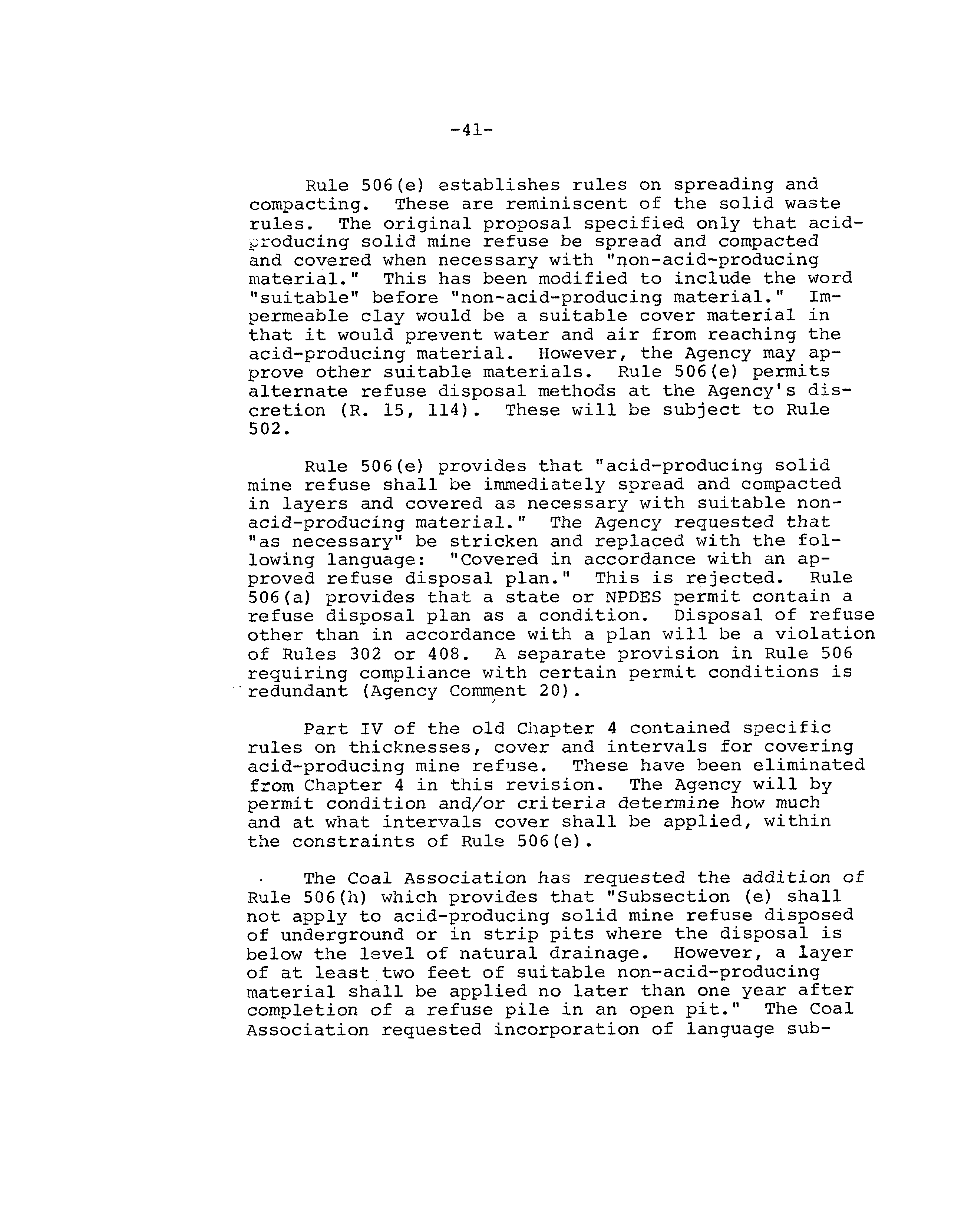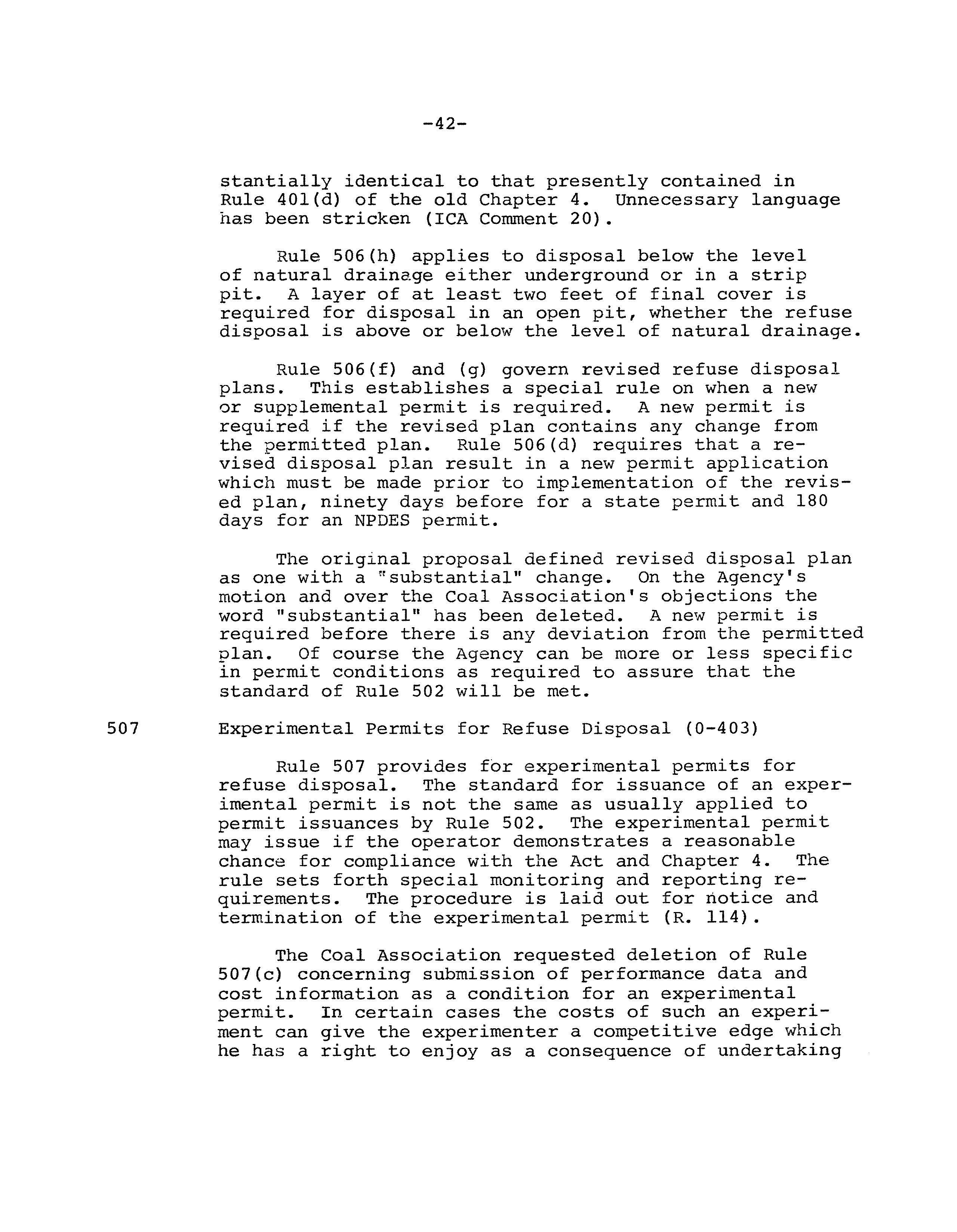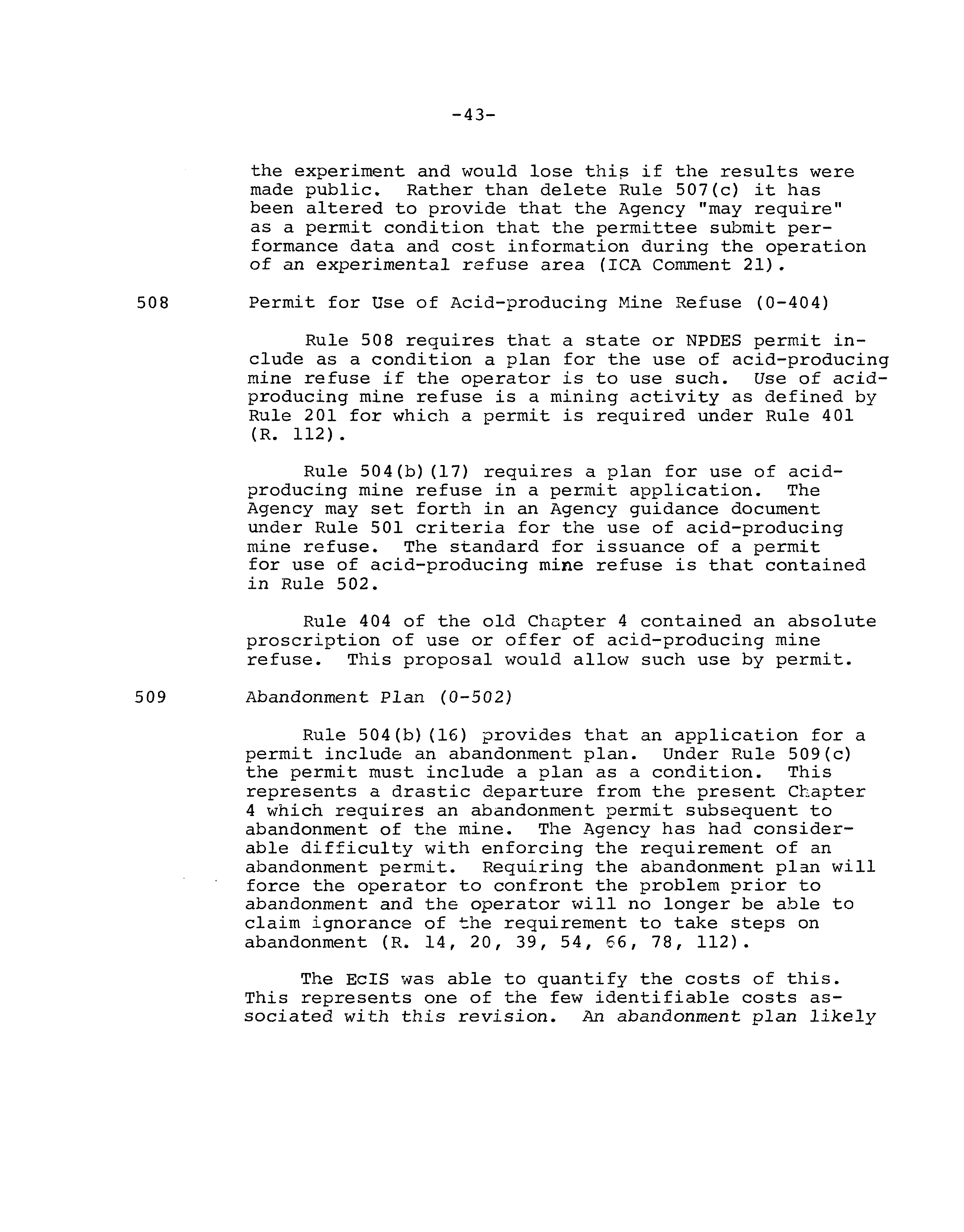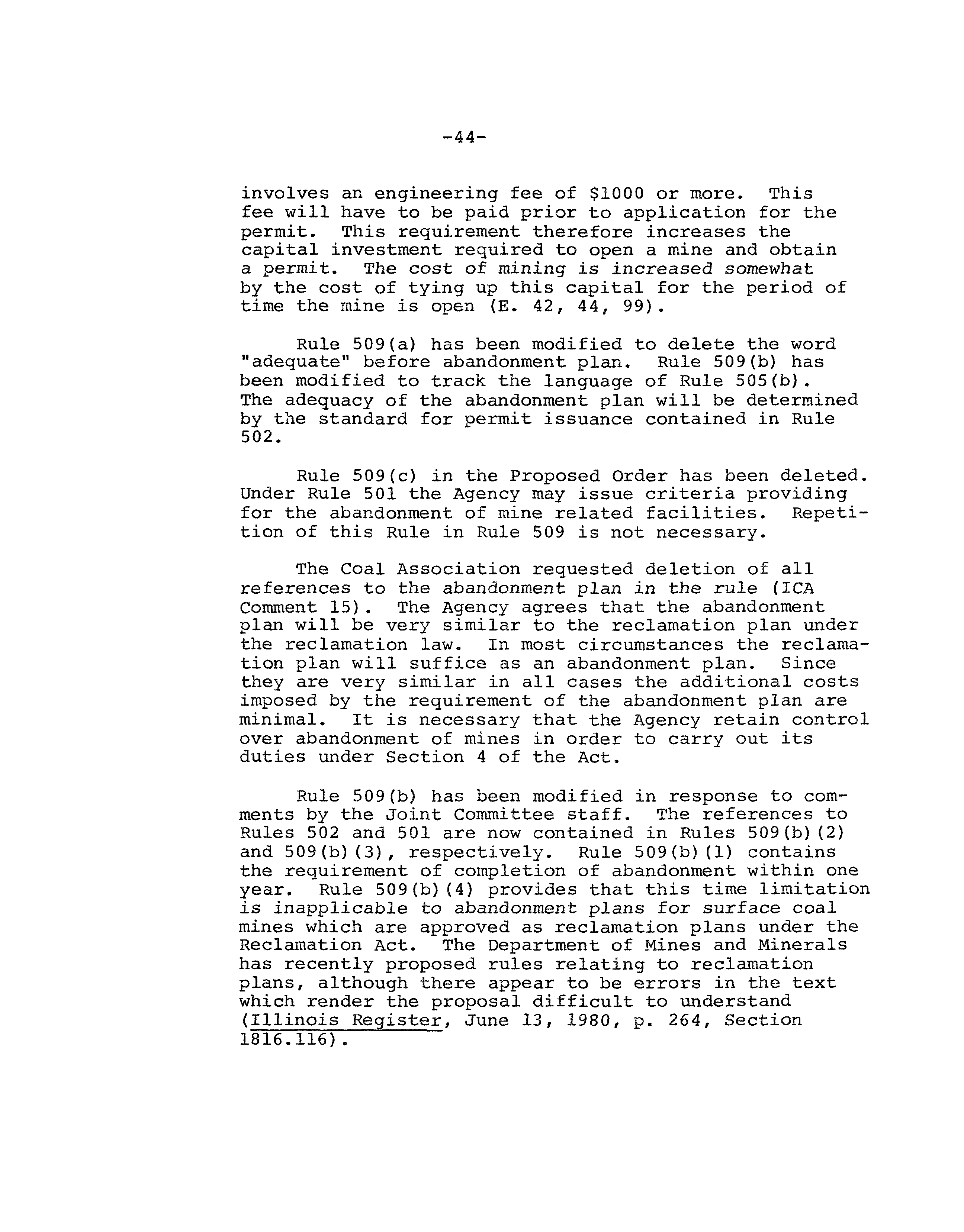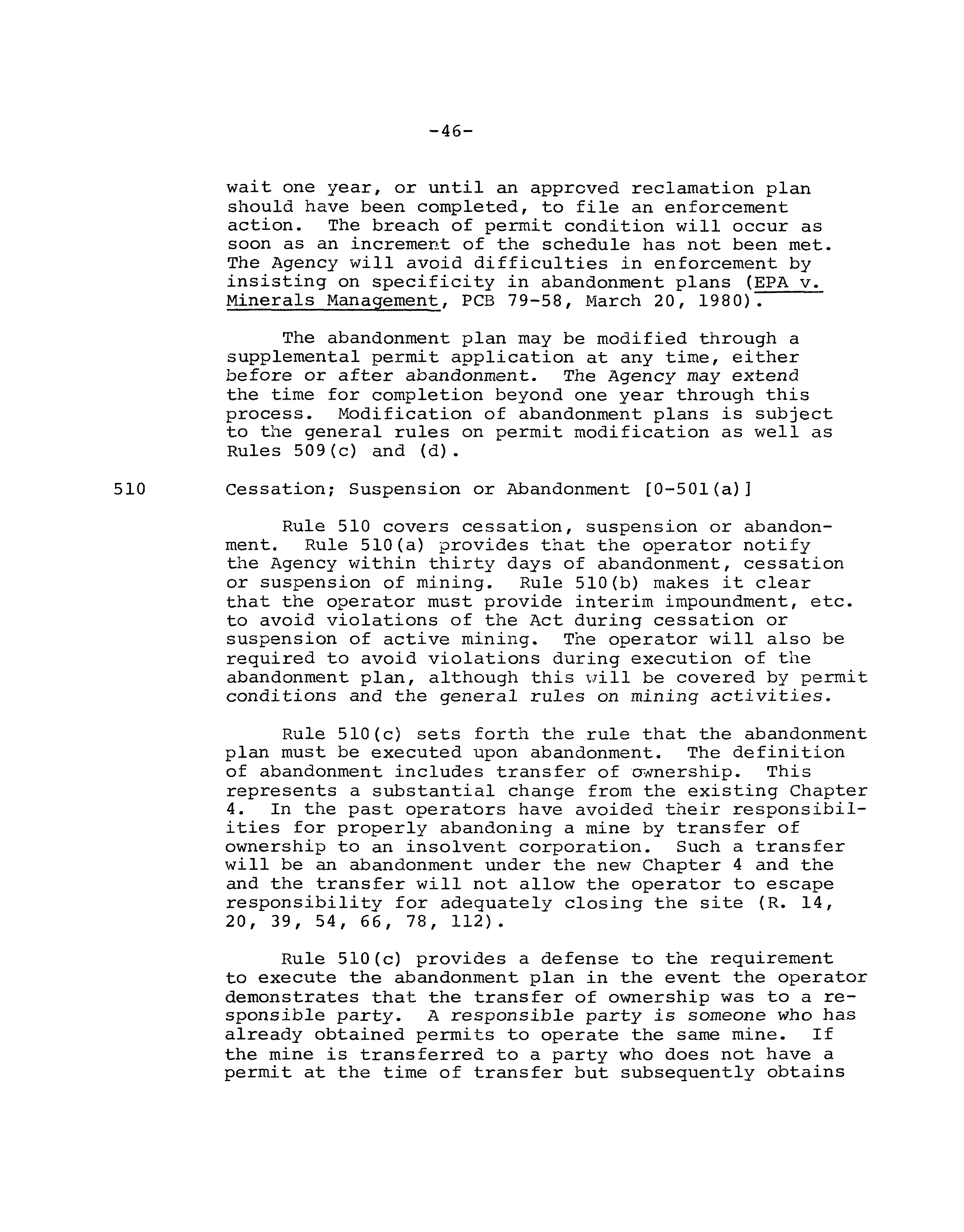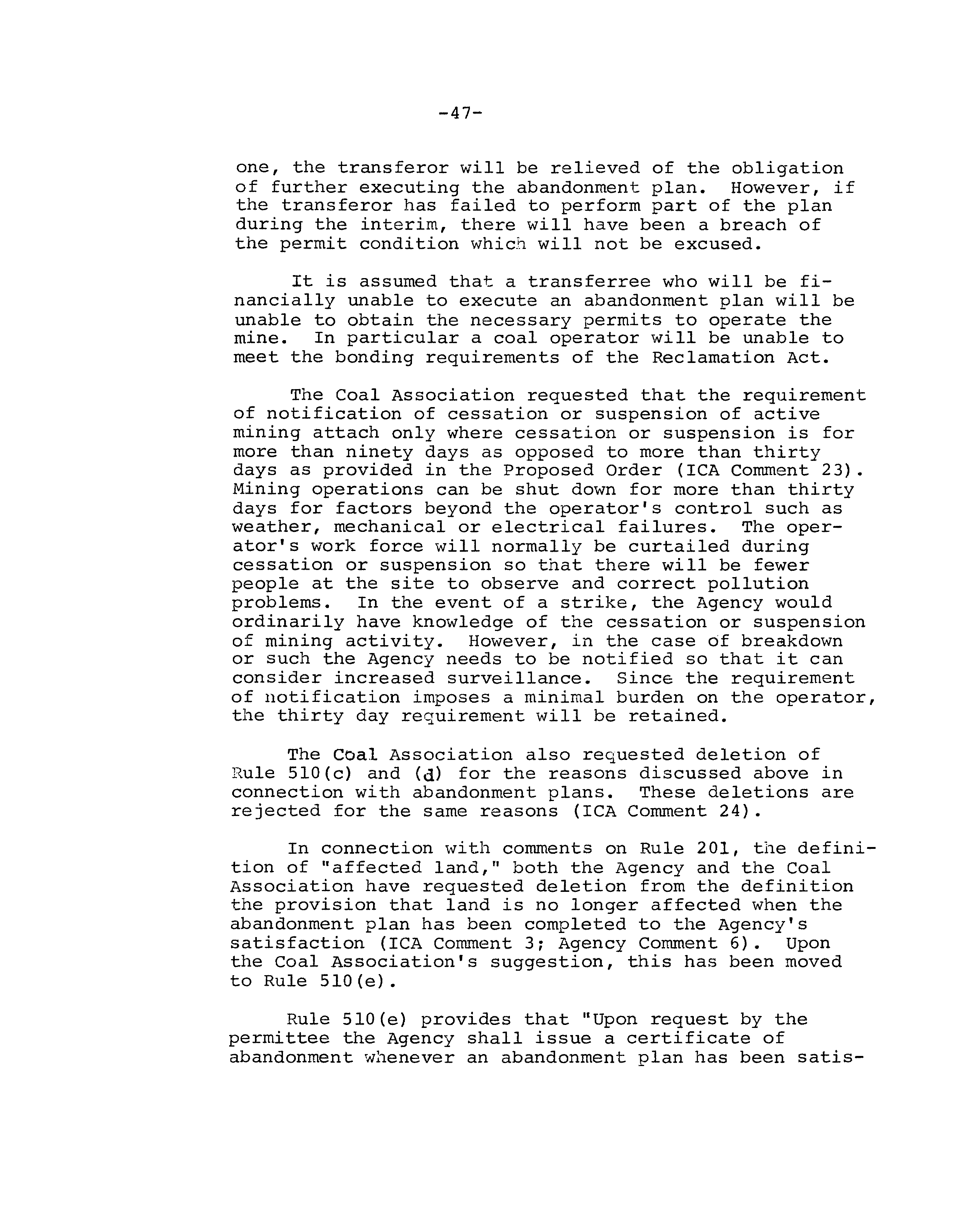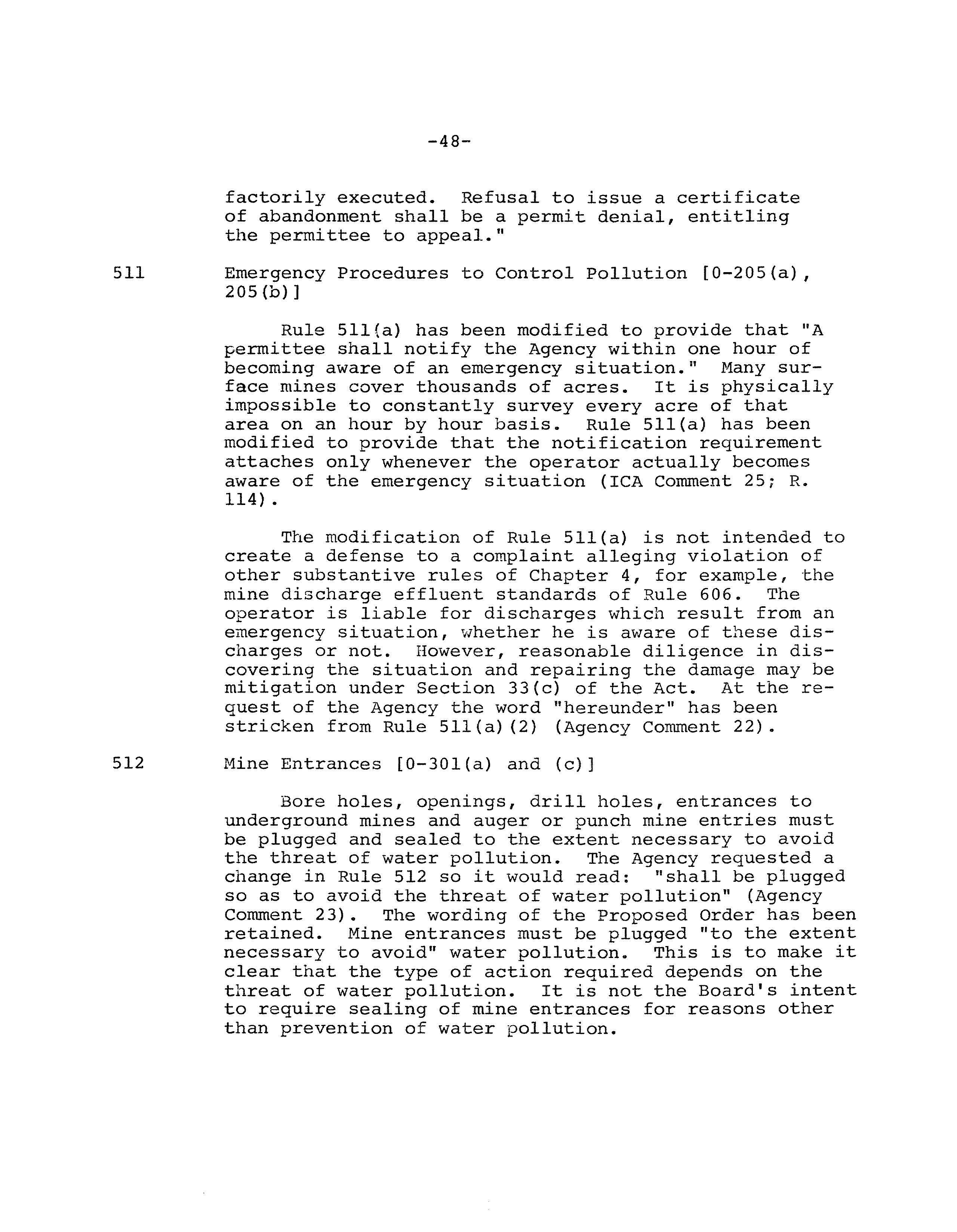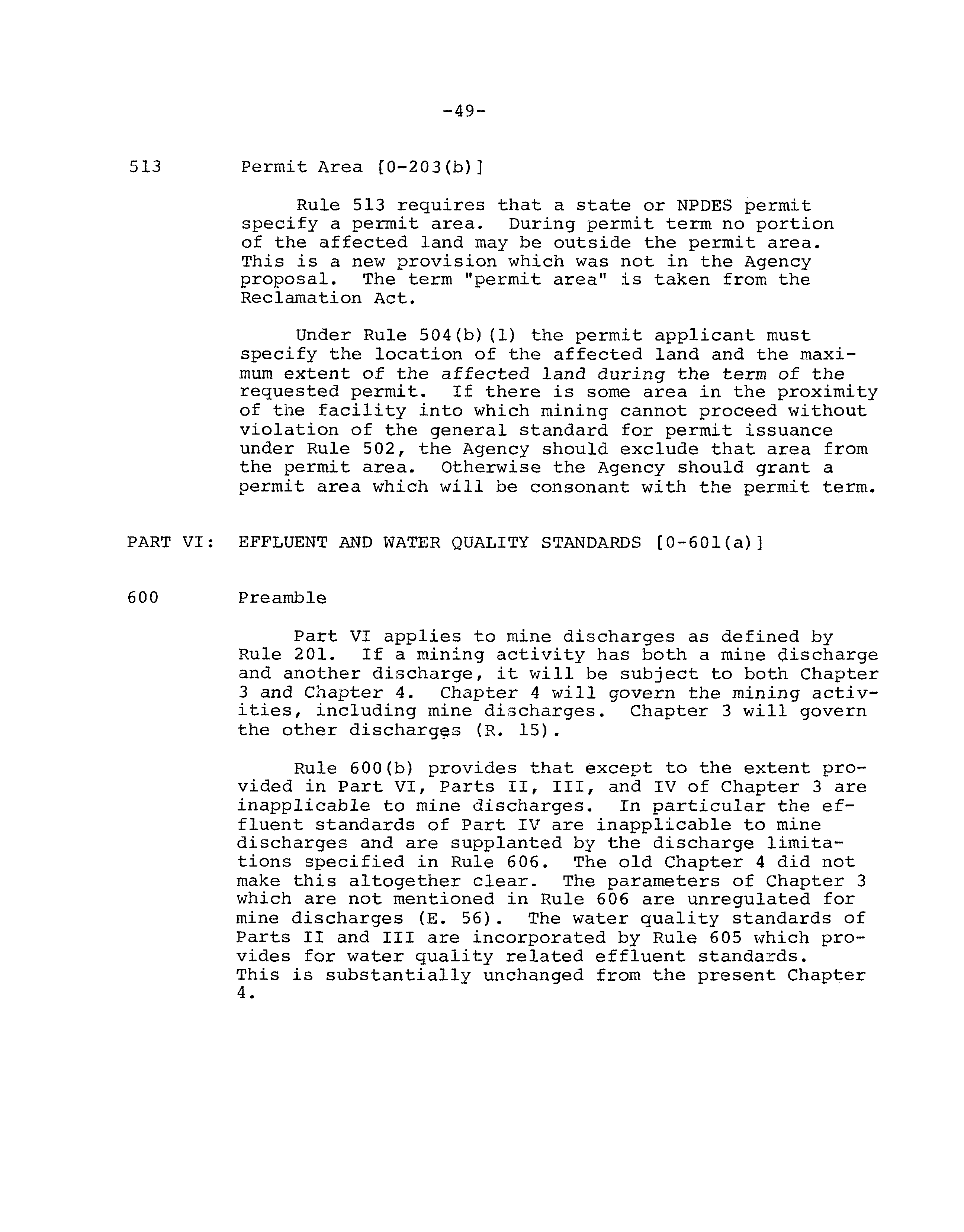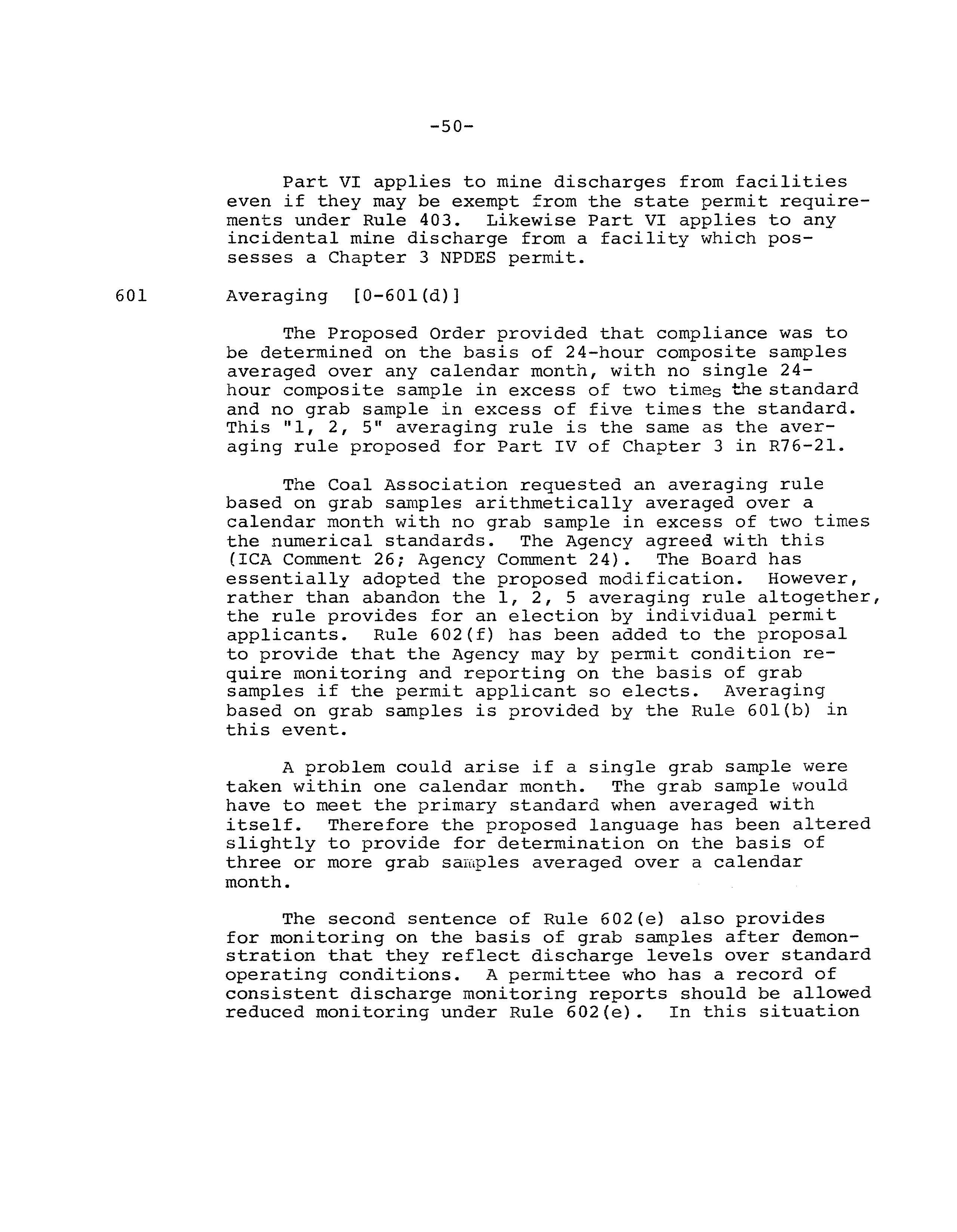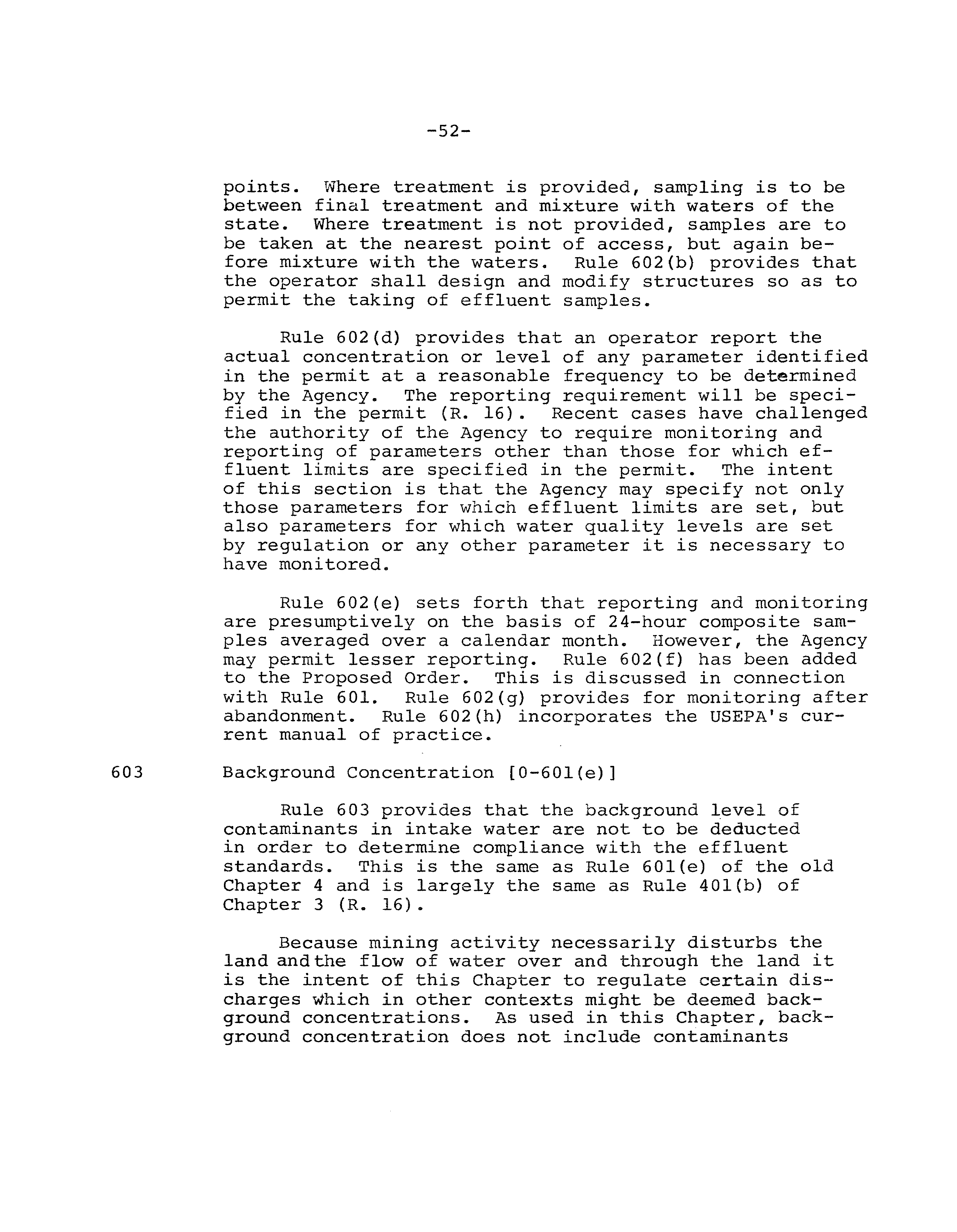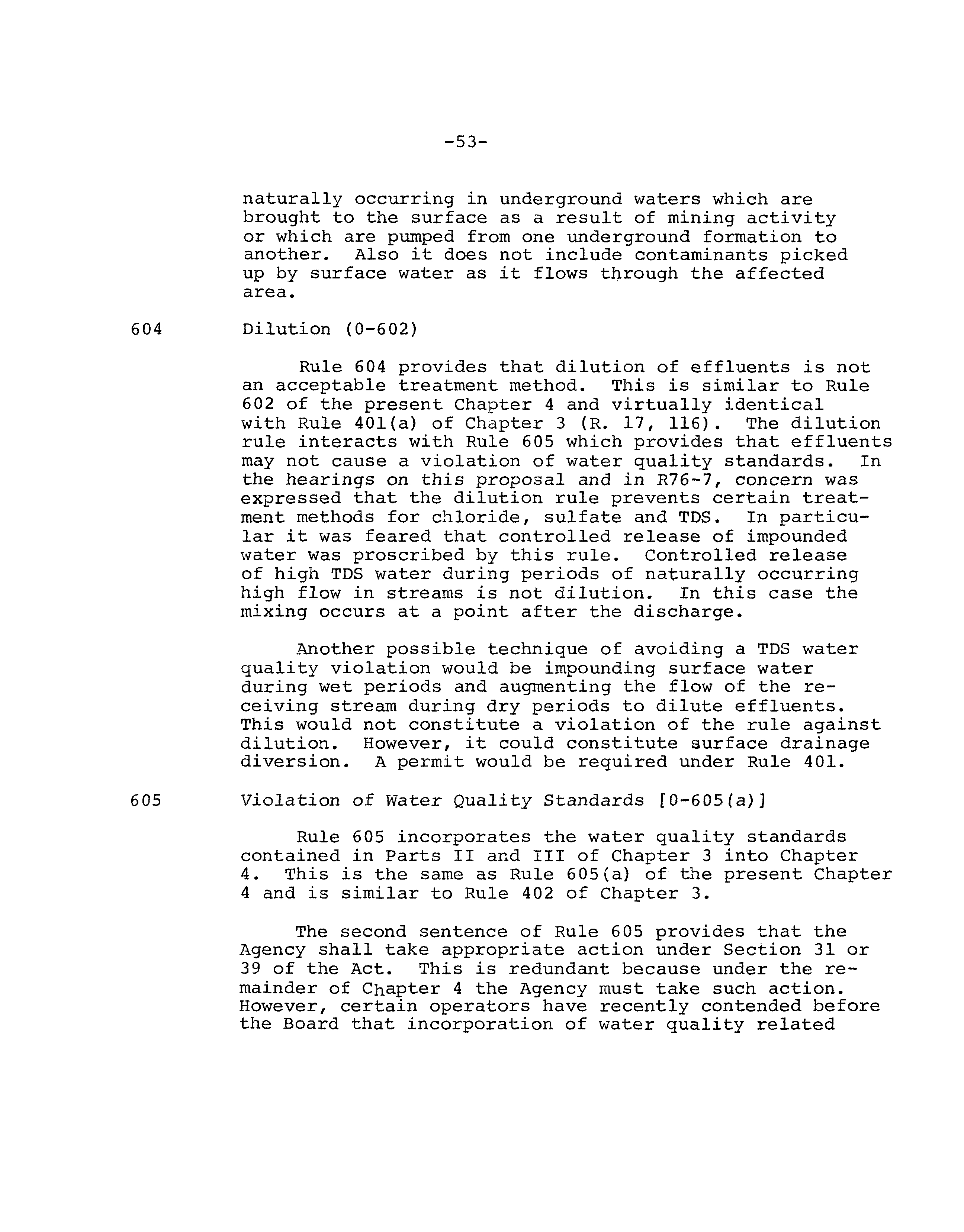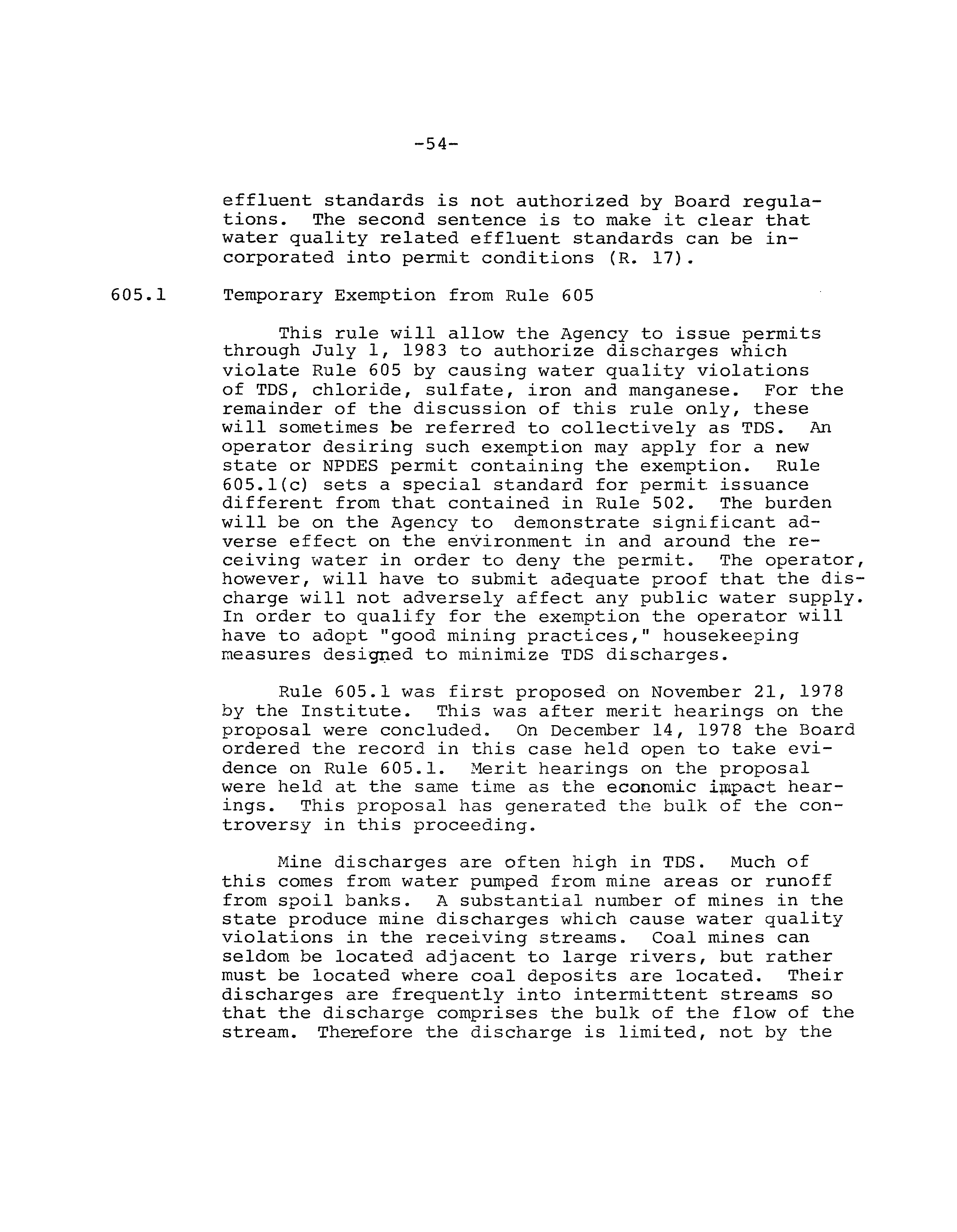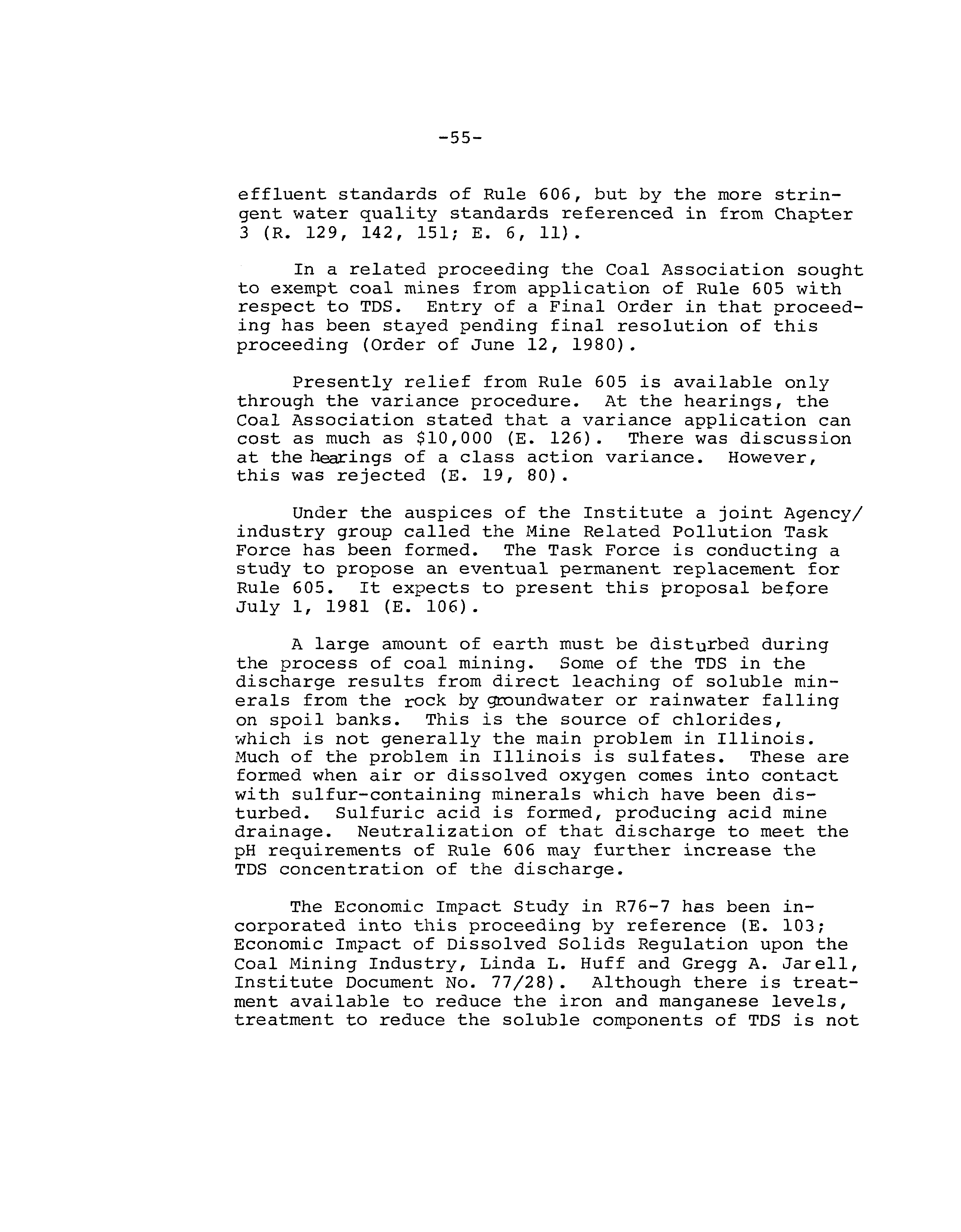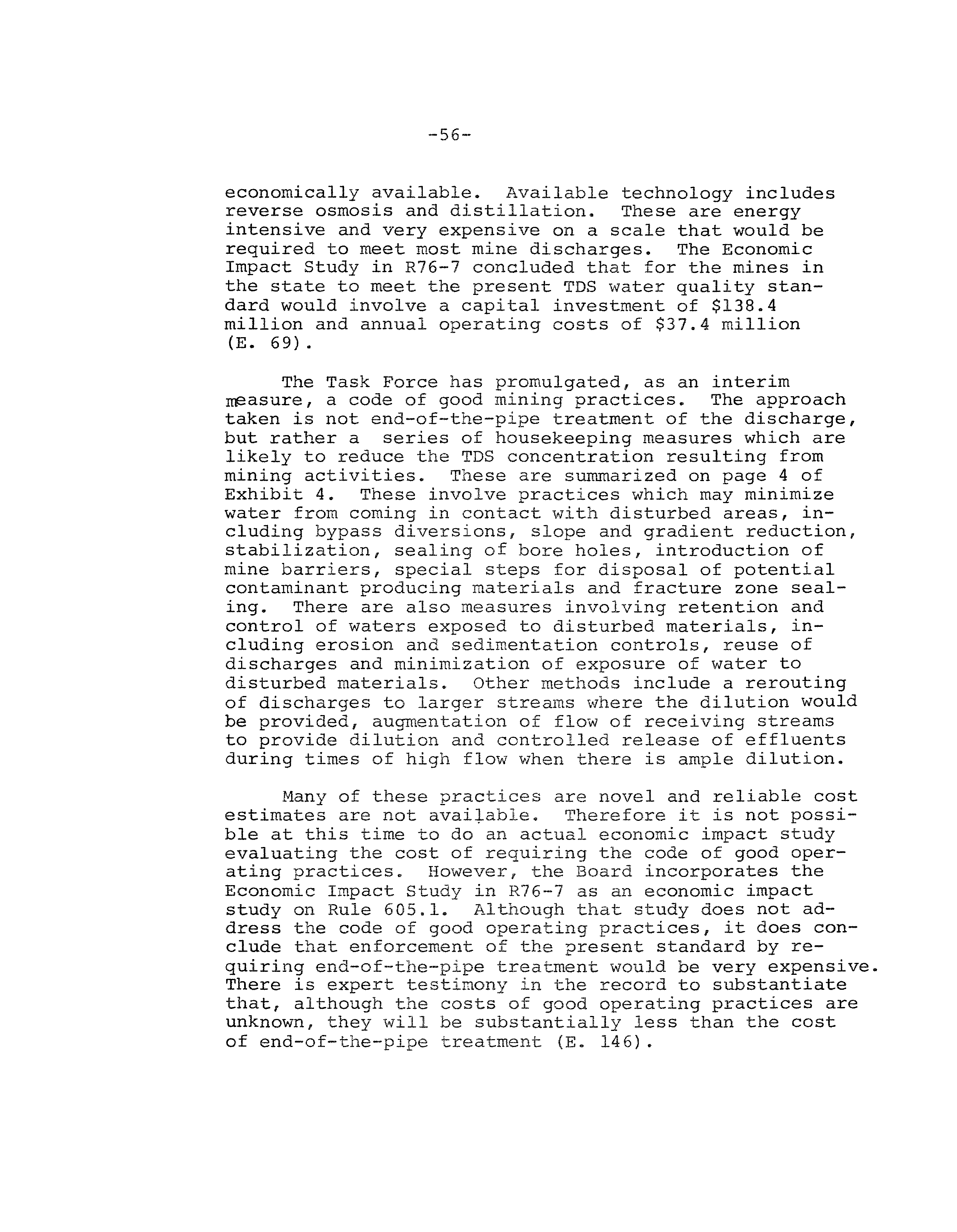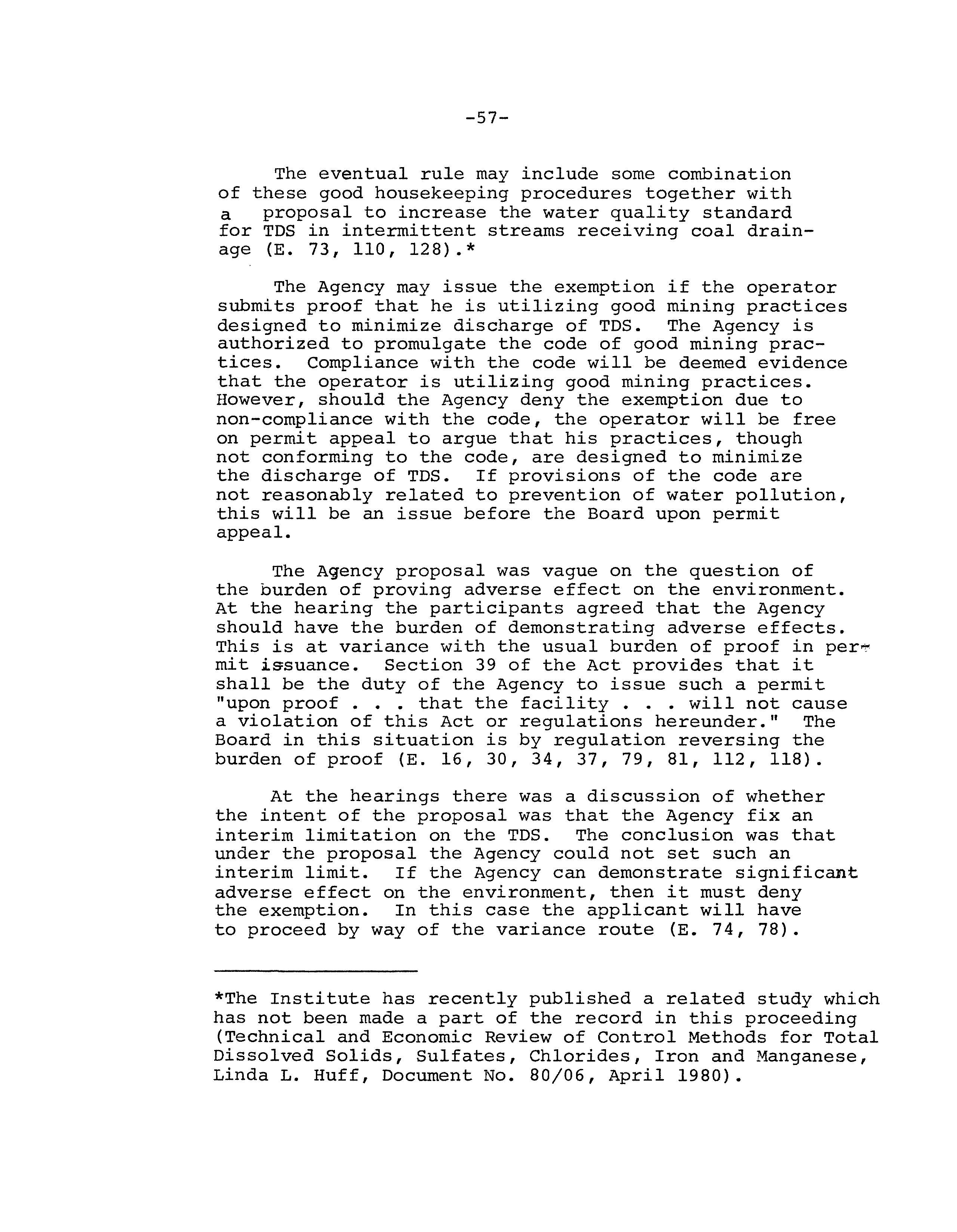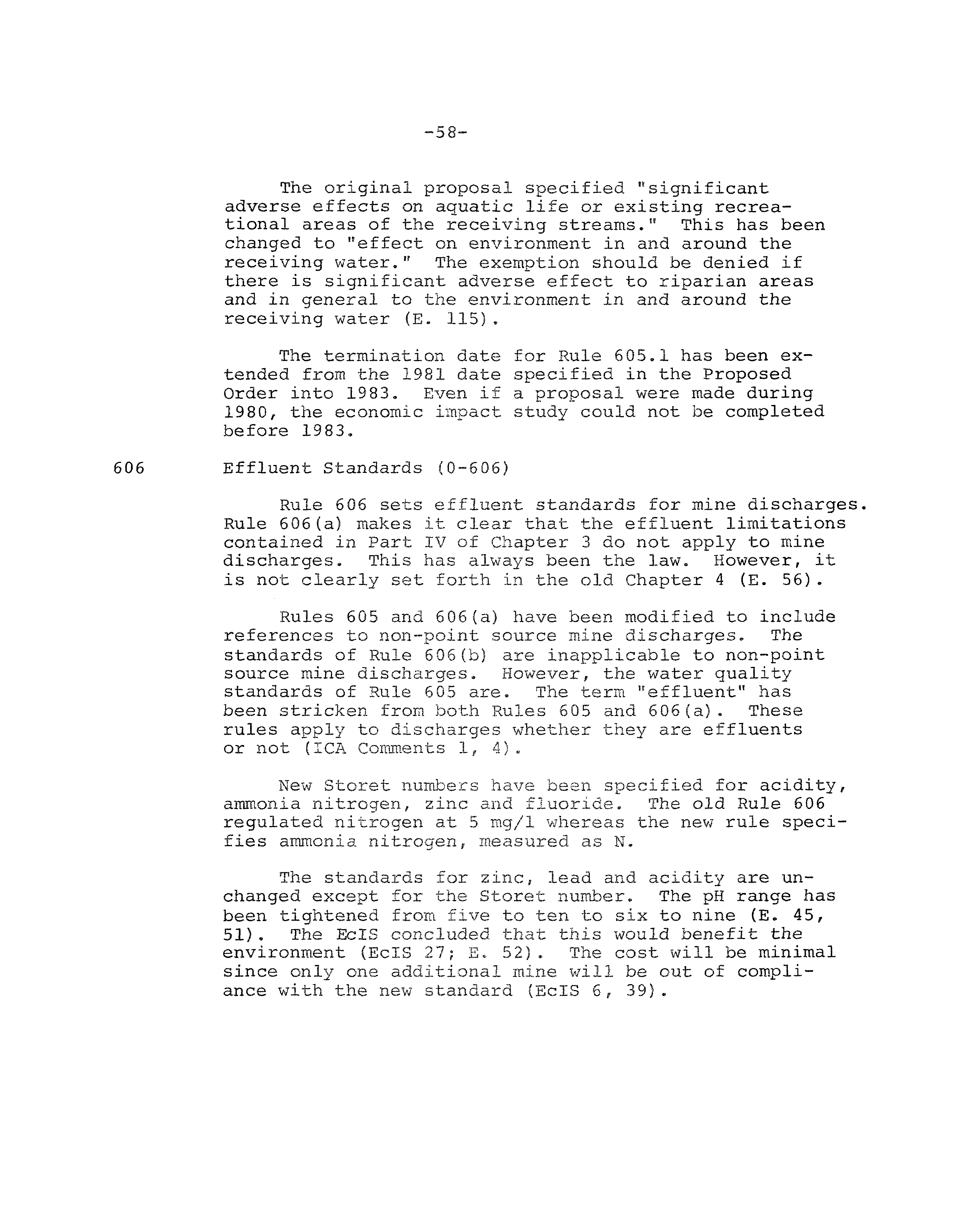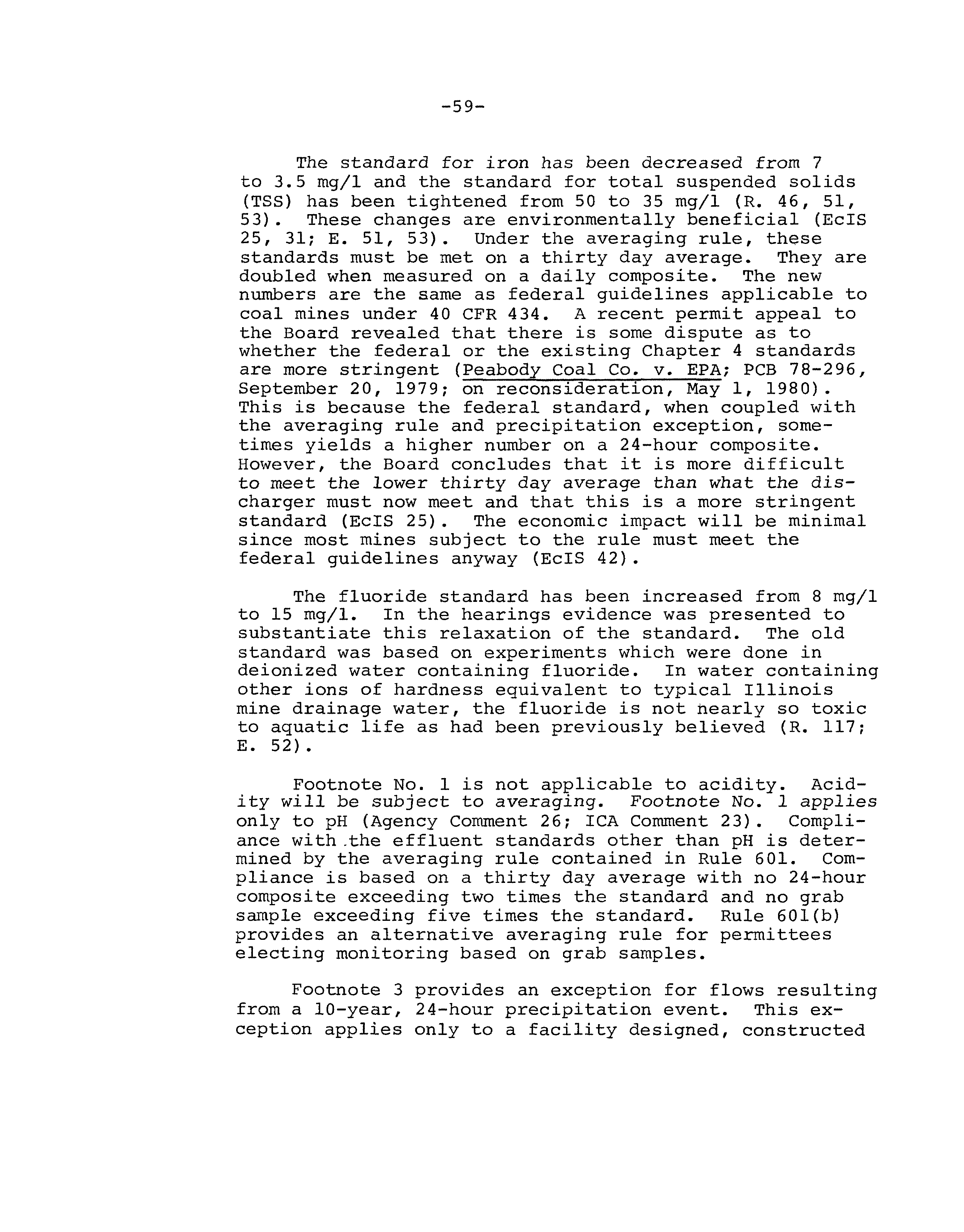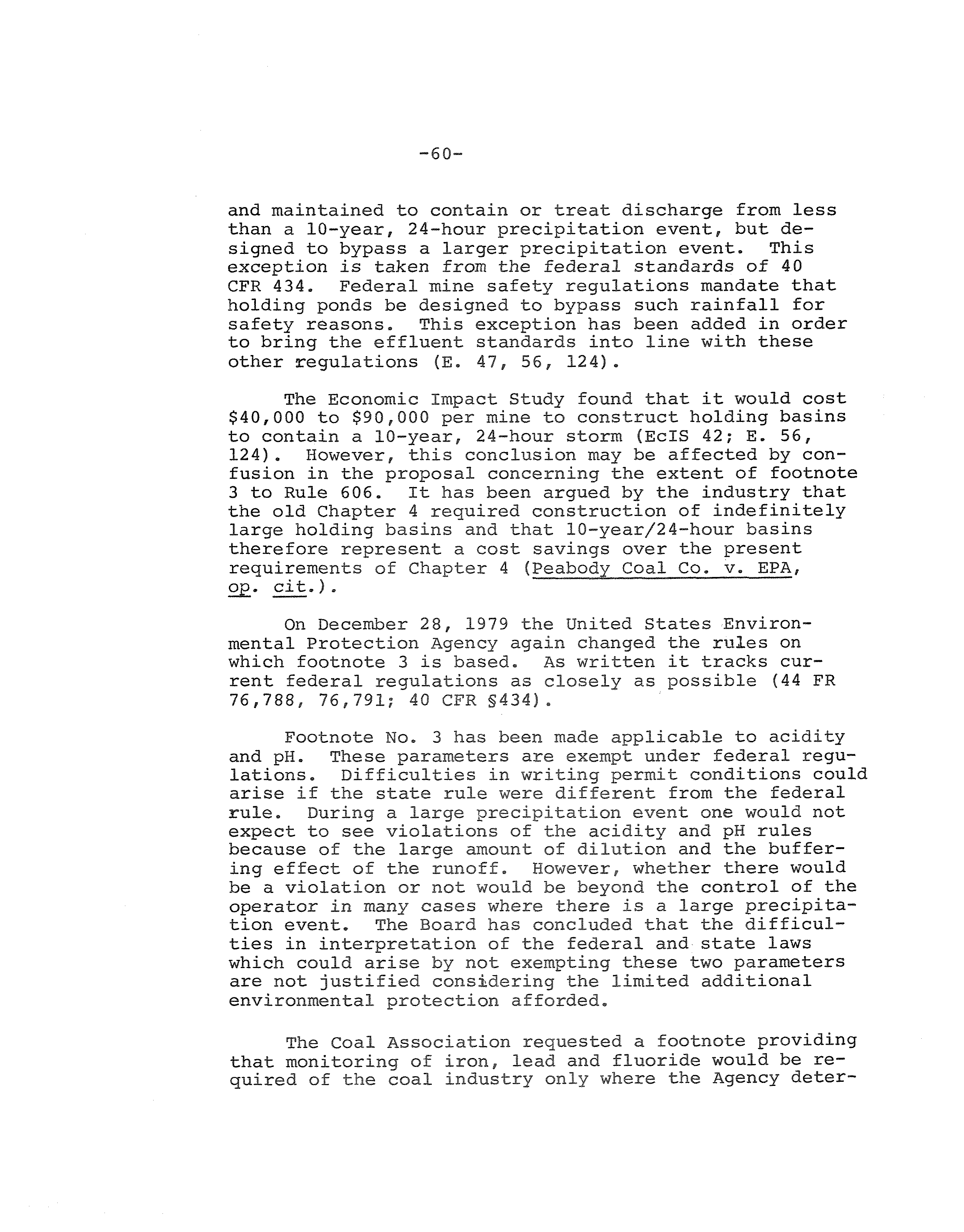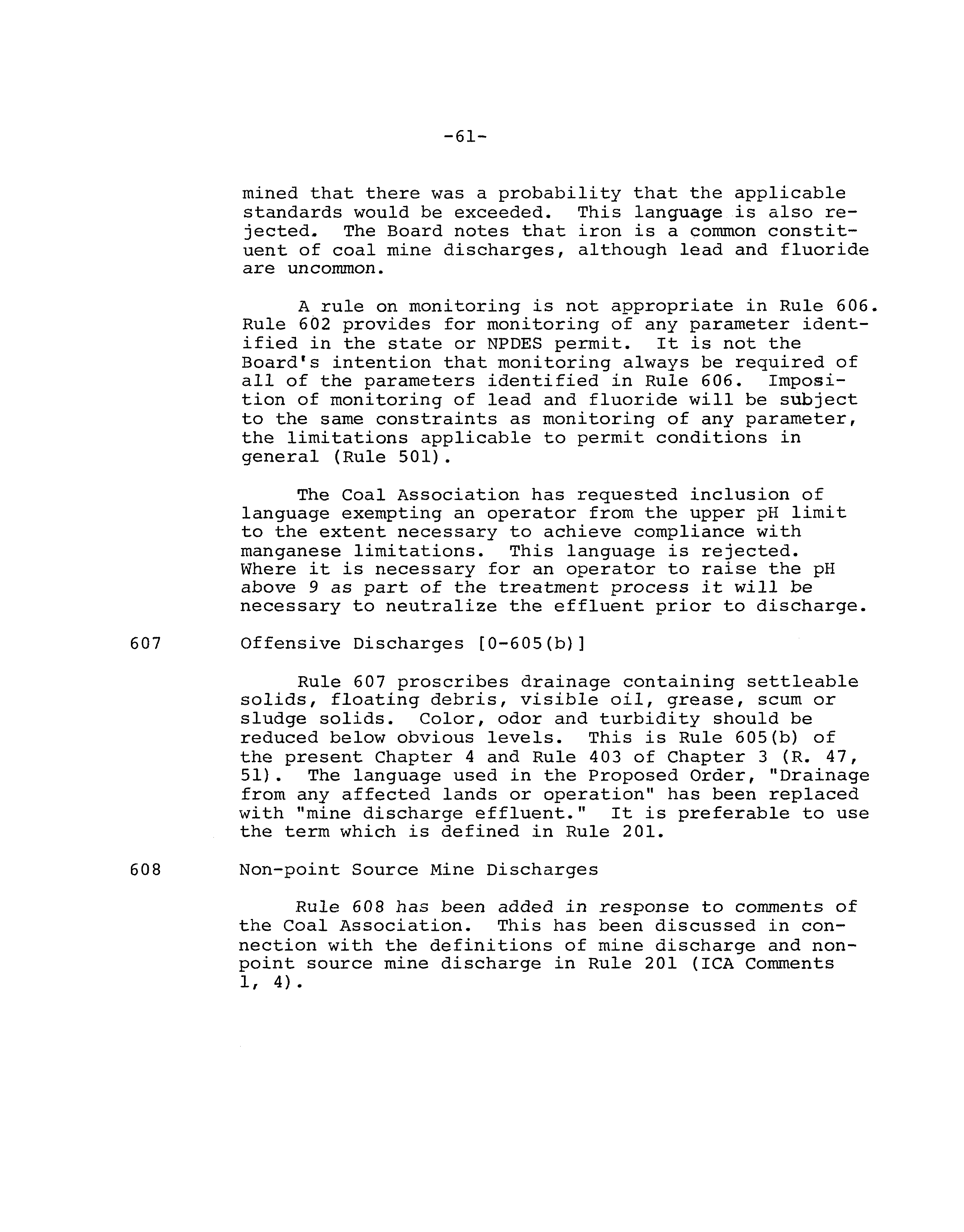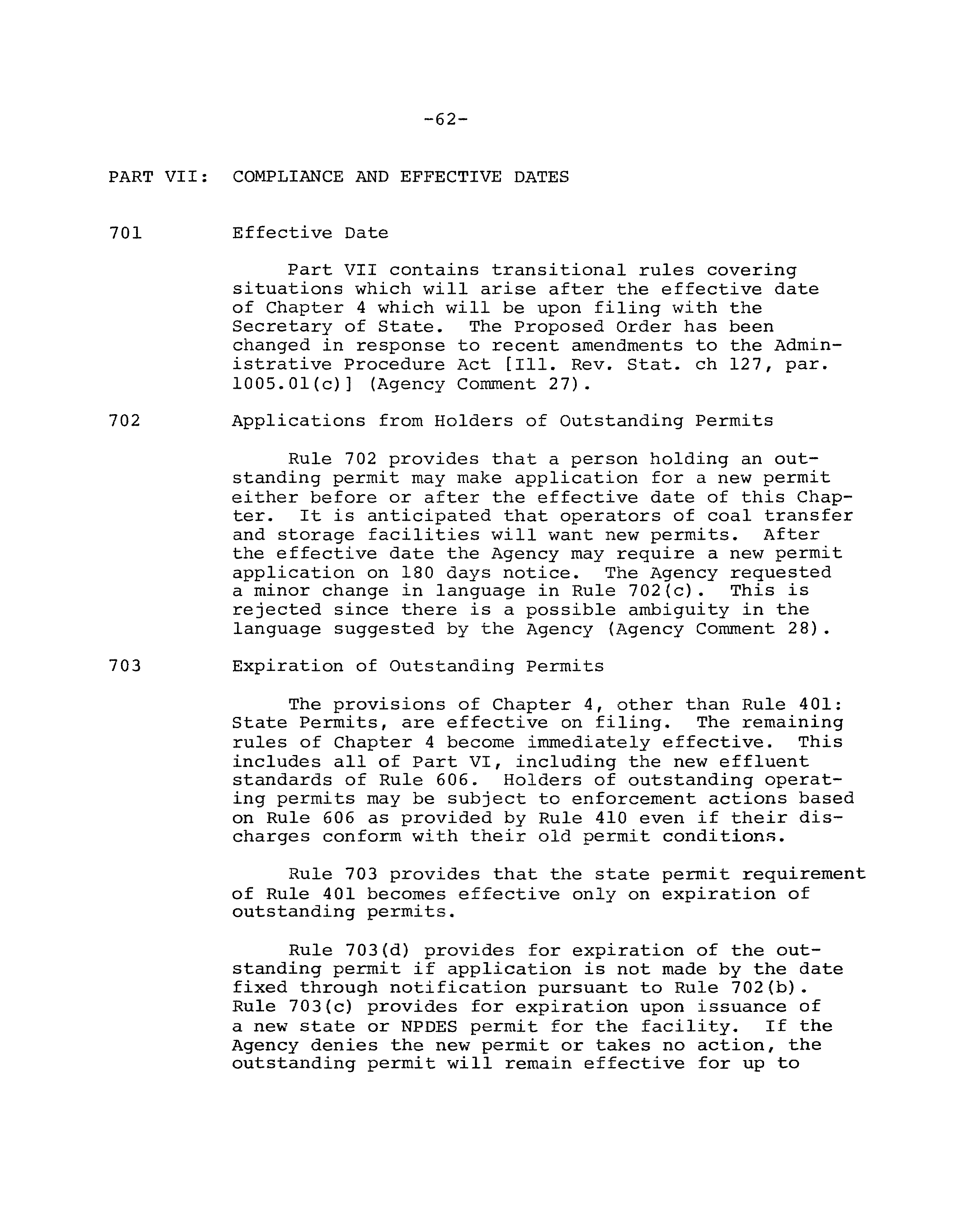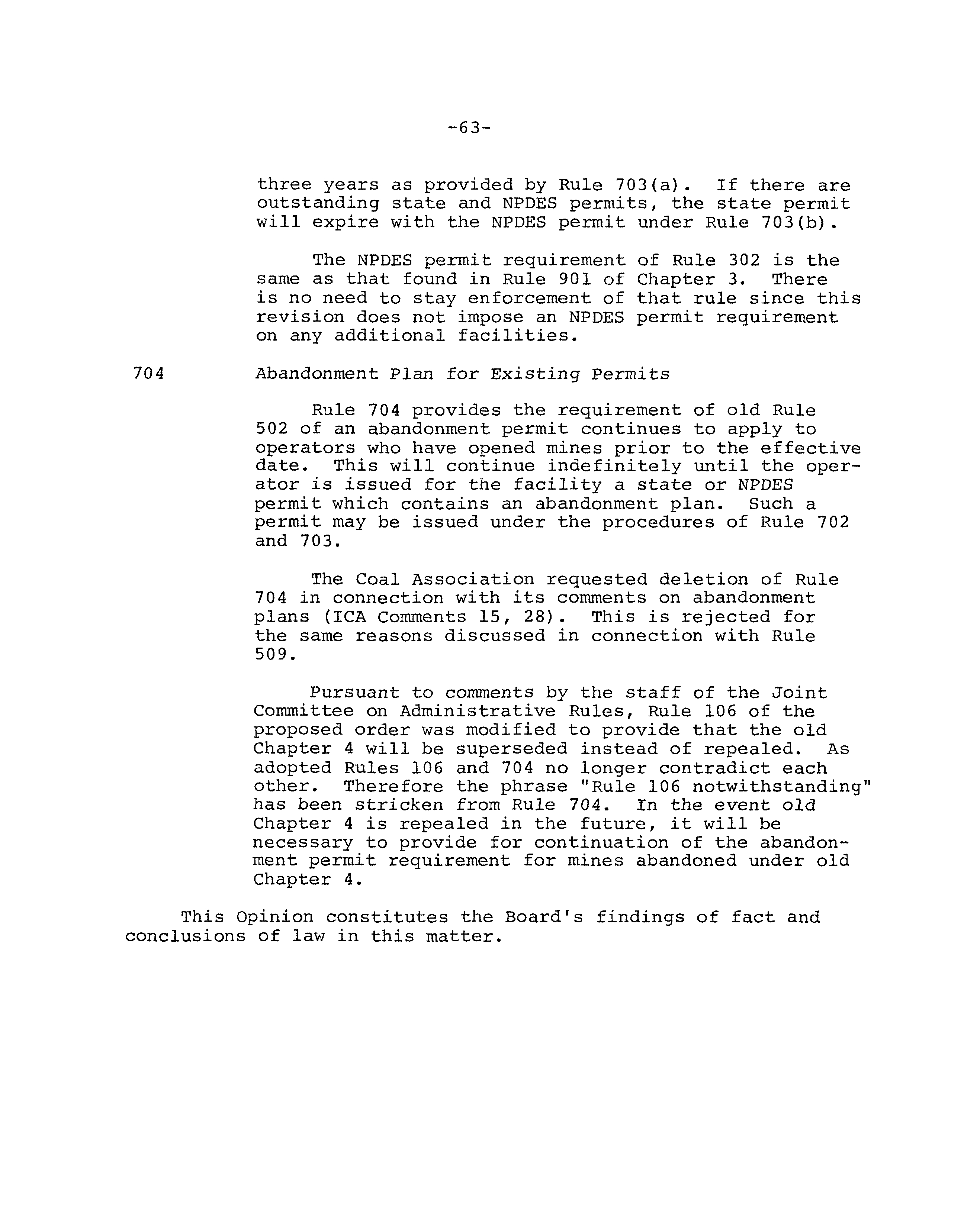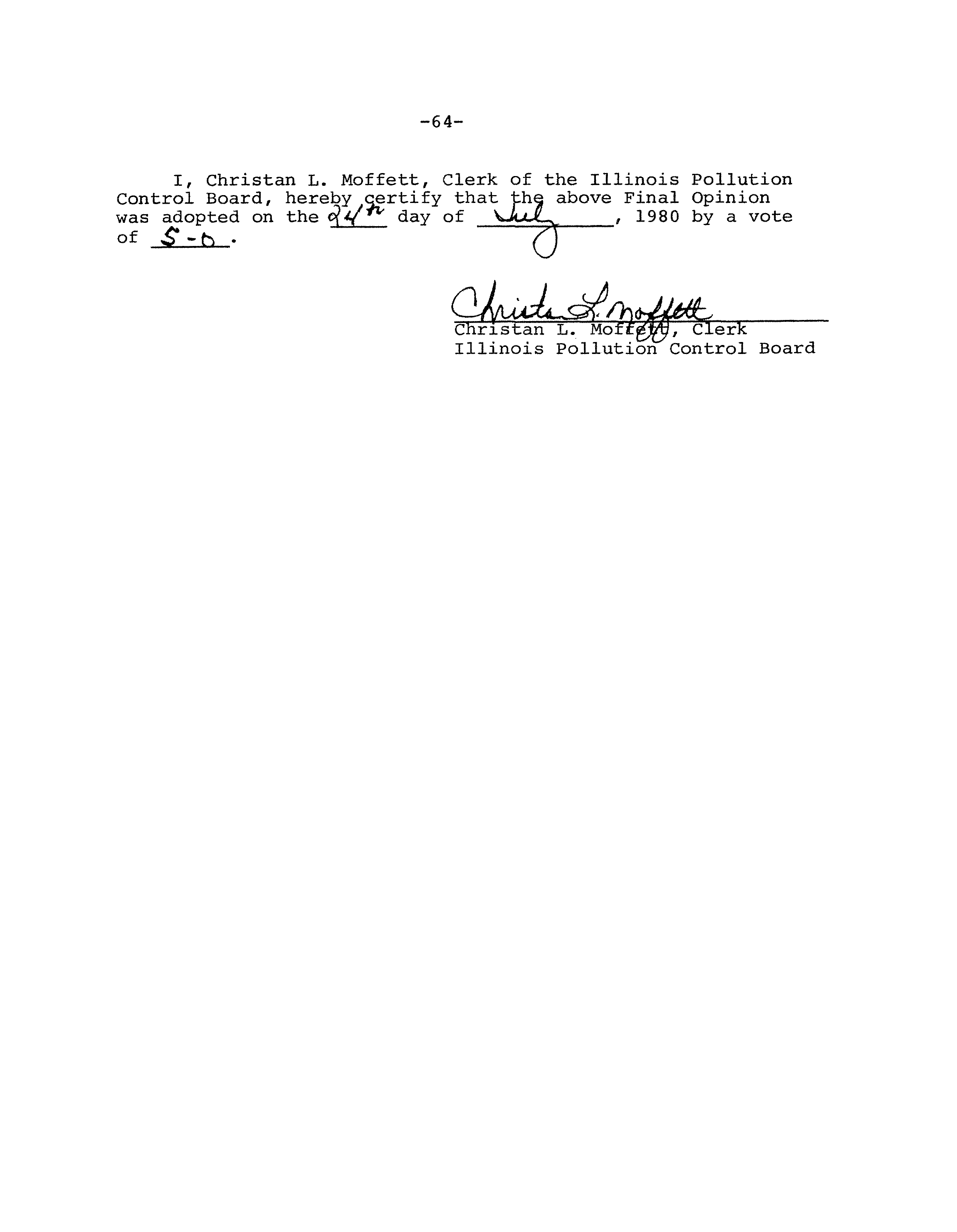ILLINOIS POLLUTION CONTROL BOARD
July 24,
1980
IN THE
MATTER
OF:
PROPOSED AMENDMENTS TO CHAPTER 4
)
R76-20
OF THE REGULATIONS
OF THE
)
R77-10
ILLINOIS POLLUTION CONTROL BOARD.
)
FINAL OPINION OF THE
BOARD
(by D.
Satche11~:
This matter comes before the Board upon two proposals for
regulatory change.
On September 21,
1976 Ohio Power Company
filed a petition
for
a change in the definition of mine storage
facility, docketed R76—20.
On April 20,
1977 the Environmental
Protection Agency
(Agency)
filed a petition proposing to repeal
Chapter
4:
Mine Related Pollution and substitute a new version,
docketed R77-l0.
On August 18,
1977 the proceedings were con-
solidated on motion of Ohio Power Company.
The proposal in
R76-20 was published in Environmental Register Number 135 on
August 15,
1976.
R77-lO was published in Environmental Register
Number
146 on May 2,
1977.
Public hearings on the proposal were
held in Springfield on October 31,
1977 and in Carbondale on
November
2
and
3,
1977.
During the course of these hearings,
two amended proposals were presented by the Agency.
On November 21,
1978 the Institute of Natural Resources
(Institute), pursuant to suggestion made by the Illinois Coal
Association
(Coal Association or ICA) at the merit hearings,
filed with the Board a proposal for interim regulations
(R.
141).
On December 14, 1978 the Board ordered the record in
this proceeding held open to take evidence on the proposal for
an interim regulation concerning total dissolved solids
in mine
discharges
(Rule 605;
32 PCB 321).
An Economic Impact Study
(EcIS) was prepared by the Insti-
tute.
Public hearings on the EcIS were held in Springfield on
July
31
and
in Carbondale on August
2,
1979.
At these hearings
evidence was also taken on the merits of the Institut&s interim
proposal.
On September 5,
1979 the Agency filed
a third amended
proposal.
On December 11, 1979 the Board entered a Proposed Order in
this
matter
(Proposed
Rule,
First
Notice).
On
December
24,
1979
the
prOposal
appeared
in
Environmental
Register
Number
207 and
The Board acknowledges the contributions of Mr. Morton F.
Dorothy,
Administrative Assistant to the Board and Hearing Officer in this
proceeding.
—2—
on January 11,
1980 in Illinois Register.
On January 24, 1980
the Board entered a Proposed Opinion.
On May 15, 1980 the Board
entered an Order modifying the proposal in response to comments
received during the first notice period
(Proposed Rule, Second
Notice).
On June 17,
1980 the Joint Committee on Administrative
Rules
(Joint Committee)
indicated that no objection would issue.
Subsequently the Board modified the proposal in response to
comments from the Joint Committee staff
(Adopted Rule, Final
Order, July 24,
1980).
SUMMARY
OF
CHANGES
FROM
OLD
CHAPTER
4
The
Chapter 4 revisions are largely to accommodate the
NPDES permit requirement.
Currently mines require two environ-
mental permits in Illinois:
they must have a Chapter
4 state
permit,
and, in most cases, an NPDES Permit under Chapter
3.
The new Chapter 4 provides specifically for Chapter
4 NPDES Per-
mits.
The Agency regards the old permit requirement
as essential-
ly duplicative.
The new Chapter
4 will exempt from the state
permit requirement those mines which hold an NPDES Permit
(Rule
402),
The Proposal also contains
a significant expansion of the
scope of Chapter 4 to include coal transfer stations.
This was
the proposal of Ohio Power Company which was denominated R76-20
and consolidated with the Agency~sproposal.
This will allow
coal transfer and similar facilities to take advantage of the
more lenient effluent standards contained in Part VI of Chapter
4
(Rule 201:
“Mining Activities”).
Since the inc1us~Lonof coal
transfer facilities under Chapter
4 would represent
a significant
expansion of the permit requirement, there are also provided ex-
emptions from the permit requirement for smaller facilities
(Rule 403),
The effluent limitations contained in Chapter 4 have been
revised to more closely follow the federal guidelines.
The
averaging rule has also been changed to be similar to that found
in federal guidelines and in the proposal in R76-2l
(Rules 601,
606)
The present Chapter 4 requires an abandonment permit before
a mine is abandoned,
The Agency has
found these provisions to be
unworkable.
The new Chapter
4 will provide for an abandonment
plan which is filed with the permit application and incorporated
into the permit as a condition
(Rule 509),
—3—
Most of the technical rules governing coal mining have been
removed from Chapter
4.
The remaining document is largely pro-
cedural.
There is, however, provision for publication of an
Agency guidance document which would contain design criteria for
coal mines and treatment works
(Rule
501).
There is a similar
provision in Chapter
3:
Water Pollution
(Rule
967).
Most of the controversy has centered around Rule 605 which
is unchanged from the old Chapter 4.
This rule requires that
coal mine effluents not cause violation of the water quality
standards contained in Chapter
3.
Apparently most of the coal
mines
in
the state cause such water quality violations with
respect to total dissolved solids
(TDS), chloride and sulfate.
Late in the proceeding the Institute and the Agency proposed a
temporary rule to exempt coal mines from Rule 605 into the year
1981, at which time the Institute intends to propose an alter-
native to Rule 605
(32 PCB 321).
In the interim,
compliance will
be required with good .housekeeping practices contained in a code
of good mining practices promulgated by a joint government-indus-
try task force.
PUBLIC COMMENTS
Prior to entry of the Order of December 11, 1980 (Proposed
Rule, First Notice)
the Board received a number of public comments.
These are discussed in the Proposed Opinion of January
24, 1980.
Discussion of these comments has been omitted from this Final
Opinion, along with discussion of modifications in the Agency
proposal made prior to entry of the Proposed Rule, First Notice
Order, except where the discussion
is particularly helpful in
understanding the language adopted.
The Final Opinion consists
of
a general summary of the rule, differences between the old
Chapter
4 and the adopted rule,
changes made in response to com-
ments made during the first notice period and changes made in
response to Joint Committee staff comments during the second
notice period.
The Coal Association and the Agency each filed twenty-eight
specific comments
(ICA Comments and Agency Comments).
These will
be discussed in connection with the affected rules.
The Agency’s
general comments will also be discussed with the rules most
closely affected.
The Coal Association in its general comment requested that the
Board hold informational hearings to determine whether Board regu-
lation of the coal industry is necessary considering the regulatory
—4—
scheme being adopted under the Surface Mining Land Conservation
and Reclamation Act (Reclamation Act).
The Coal Association has
a right under Section 28 of the Act to propose regulations before
the Board.
The Board will consider any proposal which conforms
with the Act and Procedural Rules
203 and 204.
The Board also received a comment signed by Mr. and Mrs.
William A. Brown, Mr and Mrs. Tom Grampp, Mr.
and Mrs. Fred
Noyes and Mr.
and Mrs.
A.
J.
Van Hook,
R.
R.
7, Bloomington,
Illinois 61701.
The citizen commenters requested modification
of Chapter 4 to provide for notification of neighboring land-
owners when a Chapter
4 permit application is received.
This com-
ment was also deemed a new proposal for regulations and was docket-
ed as R80-3
(Orders February 21,
1980 and March 20,
1980).
The
Board declines to make this substantial change in the proposal at
this stage in this proceeding.
The following is
a summary of the major changes made in
response to comments during the first notice period:
1.
“Non—point source mine discharge”
is now defined and
Rules
506, 600,
605,
606,
607 and 608 have been
modified to reflect this change.
2.
Definition of “mining activities” and the standard
for issuance of construction permits
(Rules
304,
401)
have been modified.
3.
Department of Mines and Minerals permit applications
have been referenced into Rule 504(d),
4.
Rules on incorporation of drainage control plans,
etc.
into permits have been modified
(Rules 505(b),
506(b)
and 509(b).
5.
Compliance may be determined by grab samples where the
permit applicant chooses exemption from monitoring by
composite samples
Rules
601(b)
and 602(f).
6.
Acidity has been made subject to averaging; pH and
acidity have been brought under the 10-year, 24-hour
precipitation event exception
(Rule 606).
—5—
SECOND NOTICE PERIOD
In response to Joint Committee staff comments the Board in
its Final Order, Adopted Rules, modified the May 15, 1980 Order
(Proposed Rules, Second Notice).
Major revisions are summarized
as follows:
1.
Rules 106
and
704 have been modified to provide that
the old Chapter 4
is superseded but not repealed.
2.
Rule 301 has been modified to specify what portions of
Subpart A of Part IX of Chapter
3 are to be incorporated
into Chapter
4.
3.
Rule 509 has been modified to provide that the Agency
may disregard the one year limitation on abandonment
plans when considered with reclamation plans approved
under the Reclamation Act.
STATE OR NPDES PERMIT
Although elimination of duplicate permits and provisions for
exemption from the state permit requirements will result in dollar
savings to the Agency and to the industry,
it adds considerable
complexity to Chapter 4.
A facility carrying out mining activi-
ties may fall into one of the following categories:
1.
Combined Chapter
3 and Chapter
4 NPDES permit:
2.
Chapter 4 NPDES permit;
3.
State permit; or
4.
Exempt from state permit (and not required to have an
NPDES permit).
The following outline determines into which permit category
a facility will fall:
1.
Does the applicant already possess a Chapter
4 state or
NPDES permit for the facility?
--If so,
is permit modification required under Rules
304(b)
or 407?
2.
If not, does the applicant propose to carry out “mining
activities” within the meaning of Rule 201?
—6—
--If the applicant does not propose to carry out
mining activities a Chapter 4 permit is not required
under Rule
401.
3.
If the application proposes mining activities,
then does
the applicant already possess
a Chapter
3 NPDES permit
for the facility
Rule
402(a)?
--If
so,
then the Chapter 4 requirements will be written
into the Chapter
3 NPDES permit
(Rule
302).
4.
If the applicant has no NPDES permit, then does the
application propose a discharge from a point source
into navigable waters within the meaning of the FWPCA
(Rule 402)?
--If so, then under Rules
300(a)
and 302 the require-
ments
of Chapter
3 and Chapter 4 will be written into
one NPDES permit for the facility subject to the
standard for permit issuance contained in Rule 502.
5.
If an NPDES permit is neither held nor required, then
does the facility qualify for an exemption from the
state permit requirement under Rule 403?
--If not,
a state permit is required under Rule 401.
6.
If so,
has the Agency notified the facility that a
state permit is nevertheless required under Rule
403(c)?
--If
so,
a state permit will be written pursuant to
Rule 401, subject to the general standard for permit
issuance contained in Rule 502; otherwise,
a Chapter
4 permit is not required, provided the operator has
notified the Agency of the location of the facility
and claims exemption prior to the filing of an
enforcement action
Rule
302(b),
There are also construction permits
(Rule
401)
and construc-
tion authorizations
(Rule 304).
These are special,
limited state
and NPDES permits,
respectively.
In the case of a facility which
already has a Chapter
4 permit, their issuance will amount to a
permit modification in the above outline.
In the case of a new
Chapter 4 facility, the state or NPDES permit first issued will
ordinarily be
a construction permit or authorization, although
there is flexibility on this point.
—7—
ECONOMIC IMPACT STUDY
The Economic Impact Study was prepared for the Institute by
Dr. William C.
Hood and Dr. Donald W.
Lybecker.
The study found
few identifiable costs and benefits and concluded that the econ-
omic impact of proposed changes would be minimal.
The specific
findings will be discussed with the individual sections which
were found to have an economic impact.
The transcripts of the two sets of hearings are not numbered
sequentially.
It is therefore necess.ary to distinguish page
numbers.
“E” refers to a page number in the economic impact
hearings, while “R” refers to a page number in the merit hearings.
To aid in cross referencing the Opinion and Order with the old
Chapter
4,
the comparable section numbers have been listed in
parentheses after the heading of each rule in this Opinion.
For
example,
“0-605”
is Rule 605 in the old Chapter
4.
—8—
PART I:
GENERAL
PROVISIONS
101
Authority
(0—101)
Rule 101 sets forth the Board’s authority under
the Act to regulate mine related pollution pursuant
to Sections 12 and 13 which concern water pollution.
The old Chapter 4 also listed Sections
9,
21 and 22
which relate to air pollution, land pollution and
refuse disposal.
These have been omitted from the
revision.
Mining activities are subject to these
provisions of the Act and to the Board regulations
adopted under them--Chapter 2:
Air Pollution Control
Regulations and Chapter 7:
Solid Waste Rules and
Regulations,
as well as other Board regulations
(R.
43)
Mine refuse disposal
is regulated by Chapter
4
pursuant to Section 12(d)
of the Act which concerns
depositing contaminants upon the land so as to create
a water pollution hazard.
Any
solid or dissolved
material from any facility subject to the Federal
Surface Mining Control and Reclamation Act of 1977 is
exempted from the definition of “waste” in Section
3
of the Act.
It is arguable that other mine refuse is
also “refuse” or “waste” within the meaning of Sections
3, 21 and 22.
However,
it is not
the
Board’s intention
that
disposal of mine refuse on a permitted Chapter
4
facility be subject to Chapter
7
as well as Chapter
4
(Agency Comment 30).
Since Chapter
3 and Chapter
4 both govern water
pollution there must be special rules establishing the
respective jurisdictions.
Chapter
4 governs mining
activities which include mine related facilities as
defined by Rule 201.
Part VI establishes effluent
limits for mine discharges
(Rule 606).
Other dis-
charges and facilities are regulated under Chapter
3.
Rule 101 has been modified to include a specific
reference to amendments to the Federal Water Pollution
Control Act.
Substantial amendments were adopted in
1977.
Chapter
4 is intended to conform to the FWPCA
as amended prior to the day of the adoption of a Final
Order in this proceeding
(Agency Comment 1).
—9--
102
Policy
(0—102)
This is largely unchanged from the old Chapter 4.
The wording has been changed to include the defined
terms
“mining
activities”
and
“mine
related
facility”
(R.
201)
103
Purpose
(0—102)
This has been largely unchanged from the second
paragraph of old Rule 102.
Minor changes
in
language
have been adopted.
The permit system
is established
to “control the multitude of contaminating point and
non-point source discharges.”
In order to ensure that
mining activities meet environmental standards, water
quality and effluent standards are established
(Agency
Comment 2).
The Coal Association requested deletion of the
reference to non—point source discharges
in Rule 103
(ICA Comment 1).
However, “non—point source mine
discharge” has been defined in Rule 201.
The effluent
standards of Rule 606 have been made inapplicable to
non-point source mine discharges, but the water quality
standards of Rule 605 are applicable.
104
Compliance with Other Laws Required
(0-701)
This has been changed to indicate required compli-
ance with “The Surface Coal Mining Land Conservat4on
and Reclamation Act.”
The title of the law passed in
1979 differs slightly from the old title
(R.
43, 58,
67)
The Coal Asscciation requested modification of
Rule 104 to provide that nothing in Chapter
4 is intended
to be inconsistent with or impair the obligation to com-
ply with any other state “or federal laws”affecting the
duties of an operator
(ICA Comment 2).
The change in
language requested by the Coal Association has been
adopted in the Final Order, Adopted Rules.
The Board
does not intend to adopt anything in Chapter
4 which
is
inconsistent with federal mining regulations.
The Coal
Association’s comment
states that,
“it is
imperative that an operator not be held in violation of
—10—
R77-lO when he
is attempting to comply with regulations
under PL 95-87.”
This interpretation that Rule 104
creates a defense to Chapter
4 through compliance with
the Reclamation Act is incorrect.
Rule 104 serves two
functions in Chapter
4.
First, it is
a statement of
purpose:
If there is an inconsistency with,
for in-
stance,
the Reclamation Act then Chapter 4 is to be
construed consistently with it if possible.
Second,
Rule 104 makes it clear that compliance with Chapter
4
is not a defense to non—compliance with the Reclamation
Act and other laws.
If there is an irreconcilable in-
consistency with other law, then this may be offered in
mitigation in an enforcement case under Section 33(c)
of the Act or it may be the basis of a variance or
regulatory proposal.
However, compliance with other
state
or
federal
laws
is
not
a
defense.
105
Validity Not Affected (0—702)
This is unchanged.
106
Repealer
Rule
106 has been modified in response to comments
by the staff of the Joint Committee on Administrative
Rules.
The Board will not at this time repeal the old
Chapter
4.
Instead, Rule 106 has been modified to
provide that it is superseded.
In the event the new
Chapter 4 is stricken or its enforcement stayed, the
old Chapter
4 will thereby automatically come into
effect.
PART II:
DEFINITIONS
200
Terms Defined Elsewhere
This
contains
a
listing
of
terms
used
in
Chapter
4
which
are
defined
in
the
Act,
Chapter
3
or
the
FWPCA.
“As amended” has been added after the reference to the
Federal Water Pollution Control Act here and in Rule 101.
“Person” has been removed from Rule 200 and is now de-
fined in Rule 201
(Agency Comment 3).
“Point Source
Discharge” has been added to the list of terms defined
elsewhere.
—11—
201
Definitions
Abandon:
The definition of abandon has been en-
larged to include “transfer of ownership.”
An operator
who sells
a mine may be obliged to execute an abandon-
ment plan under Rule 509.
Under the old Chapter
4
persons attempted to evade their responsibilities for
properly closing a site by transfer to a party with
insufficient resources to close the site.
This change
seeks to remedy this
(R.
9;
E.
41).
Acid-producing Material:
The definition has been
changed slightly to clarify the relationship between
pyrite, iron and sulfur.
Pyritic compounds include
pyrite, marcasite and other compounds of iron and sulfur.
These are acid—producing.
Other compounds of sulfur in-
clude sulfates and organic sulfur.
Sulfates are totally
oxidized and hence do not, as such, produce acid.
Or-
ganic and elemental sulfur do not occur in large amounts
in Illinois coal, but are acid-producing.
The defini-
tion has also been changed slightly to specify considera-
tion of the “quality of drainage produced by mining on
sites with similar soils.”
This is in recognition of
the fact that little mining actually occurs in the soil
itself
(R.
84).
Affected Land:
The definition has been expanded
to include all land owned, controlled or used by the
operator in connection with mining activities with the
exception of the surface area above underground mines.
The old definition included only the actual mined area,
refuse area, etc.
Under Rule 513 the affected land
cannot be outside the permit area during the permit term.
The final sentence which related to reclaimed and
abandoned affected land nas been deleted pursuant to
the Coal Association’s comments
(ICA Comment 3).
Rule
510(e)
has been modified to provide that the Agency can
remove satisfactorily reclaimed land from the category
of affected land by issuing a certificate of abandonment
(Agency Comment
6;
R.
10).
Aquifer:
“A zone,
stratum or group of strata which
can store and transmit water in sufficient quantities
for a specific use.”
This definition has been added on
the suggestion of the Coal Association.
The definition
—12—
of “underground water resources” in the Proposed
Order has been deleted.
This definition is drawn
from 30 C.F.R.
§701.5
(ICA Comment 7).
Coal Transfer Facilities or Coal Storag~eYard:
This
is
a new definition.
Transfer and storage facili-
ties have been included in the definitions of mining
activities and mine related facilities and have thus
been brought under Chapter
4 regulation.
These facil-
ities have much in common with coal mines and often are
larger than small mines and pose a similar pollution
threat.
Effluents
from these facilities will now be
regulated
under
Part
VI
rather
than
under
Chapter
3.
Facilities
which
have
NPDES
permits
will
now
fall
under
Part III rather than the permitting provisions of Chapter
3.
Facilities which are not required to have NPDES per-
mits may be required to obtain
a state permit under Part
IV
(R.
10,
19,
60;
E.
41,
45,
49,
61,
101).
This modification potentially represents a large
expansion of the permit requirement.
However, Rule
403 provides exemptions from the state permit require-
ments
for domestic retail sales yards and consumer
stockpiles.
Larger facilities are probably already
required to have an NPDES permit, in which event Chapter
4 provisions will be written into the Chapter
3 permit.
The Economic Impact Study concluded that inclusion
of coal transfer facilities and storage
Yards under
Chapter 4 would result both in costs and benefits to the
industry.
They
would
have
to
prepare
an
abandonment
plan
at
a
cost
of
a
few
hundred
to
a
few
thousand
dol-
lars.
On the other hand,
they will not have to invest
as much to construct larger treatment facilities
to meet
the more stringent effluent standards of Chapter 3
(EcIS
35;
E.
41,
45,
61).
The looser effluent standards would
have some negative effect on the environment.
However,
most of these facilities are located near major rivers
where ample dilution is available
(EcIS
17;
E.
49,
101).
Construction Authorization:
Authorization under
Rule 304 to prepare land for mining activities or to
construct mine related facilities.
Construction author-
ization is issued to a person who holds or is required
to have an NPDES permit
(R.
11).
—13—
Construction Permit:
A permit under Rule 401
allowing the operator to prepare land for mining
activities or to construct mine related facilities
(R.
11).
A construction permit is a state permit
issued to an operator who does not hold an NPDES
permit.
Under Rule 304
it is possible to issue a
construction permit to a person who may be required
to apply for an NPDES permit.
This will not affect
the requirement to obtain an NPDES permit for operation,
but may simplify administration in case there
is doubt
as to which type of permit is required.
Construction of mine related facilities
is a mining
activity.
Construction may therefore be permitted by an
operating permit as well as
a construction permit.
The
question is not what the title of the permit
is but what
the language of the permit allows.
The construction
permit is
a special type of operating permit which will
usually be issued for a short period of time to allow
the operator to undertake something out of the ordinary
routine of mining.
The construction permit contemplates
eventual application for an operating permit before
daily operation is begun.
Domestic Retail Sales Yard:
A coal stockpile which
supplies only homeowners, businesses or small industries
or other institutions for individual consumption.
This
does not include
a sales yard located at
a mine.
On the
Agency’s motion,
a specific exclusior. for sales yards
which supply large industrial operations has been ex-
cluded from the proposal.
The word “small” has been
inserted in front of industries
in the first half of
the definition.
This does not change the meaning
(R.
11,
28;
E.
43).
Domestic retail sales yards
are excluded from the
state permit requirement by Rule 403.
This does not,
however, exempt such a facility from the requirement
of obtaining an NPDES permit if the facility is other-
wise required to obtain such a permit,
in which case
the coal pile will be permitted under Part III of
Chapter 4
(E.
84).
Drainage Course:
Definition unchanged.
—14—
Facility:
A facility is a contiguous area of
land,
including all structures above or below ground,
which is owned or controlled by one person.
Two
permits are required if there are either two isolated
pieces of land with one operator or adjacent tracts
with two operators.
The facility may be larger than
the affected land.
It may include undisturbed land and
contain within it facilities which are regulated under
Chapter
3 as well as mine related facilities.
The
permit area must be contained within one facility, but
the permit area may be less than the entire facility.
It is the Board’s intention that a site under
control of one operator but bisected by a roadway or
other easement should be one facility.
In the event
there are two closely related, but noncontiguous
facilities under the control of one operator, the
Agency may allow a combined permit application and
issue combined permits, if it is convenient to do so.
In the event there are separate surface installations
serving a single mine,
there will be one facility.
The phrase
“owned or controlled”
does not require
permits of both the owner of record title and, for
instance,
a lessee.
However,
in the event control of
mining activities is in dispute, the owner may be re-
quired to obtain a permit also.
Otherwise the permit
will be required of the person
in control of the mining
activities.
The
fact that two or more persons may be
in control of part of the facility is irrelevant so
long as only one controls mining activities;
e.g.,
utility easements or farm leases have no effect on
“control” for the purpose of determining the extent of
the facility.
During the hearings the Agency sought to amend the
proposed definition of “operator” to specifically in-
clude co-op preparation plants
(R.
12,
29; Agency Amend-
ment).
The argument had been made that,
since there was
no one operator, Chapter
4 was not applicable to the co-
op.
However,
“operator” has been redefined to include
any person who carries out mining activities.
The ques-
tion centers not on the legal character of the person,
but on whether he carries out mining activities.
Even
if a co—op falls under no other characterization in the
definition of “person” in the Act, then it will probably
be
a partnership within the meaning of Chapter 106½, ~6,
—15—
Illinois Revised Statutes.
If the facility is
physically separated, then multiple permits may be
required.
However, if one site is operated by several
persons,
the Agency may require them to enter into a
formal agreement fixing control prior to permit issu-
ance.
The Proposed Order contained a reference
to Rule
200.
This has been deleted and the definition of
“person” removed from the list contained in Rule 200.
“Person” is now defined in Rule 201.
If the definition
of “person” is not clearly set forth in Rule 201, the
definition of “facility” could be construed
as a limita-
tion on the right of partnerships to engage in mining
activities
(Agency Comment 5).
Mine Area or Mined Area:
Although the definition
is largely unchanged,
it has been altered to exclude
the unmined surface land directly above underground
mine workings that is not otherwise disturbed by mining
activities
(R.
91)
Mine Discharge:
Part VI regulates mine discharges.
The production of a mine discharge is
a mining activity.
Other point source discharges, sanitary sewers and dis-
charges from facilities and activities which are not
directly related to mining activities are regulated
under Chapter
3.
If
a facility with an NPDES permit
has both mine discharges and other discharges, they
will be regulated by Chapter
4 or Chapter 3 respectively,
although there will be one permit only
(Rule
302)
(R.
15, 51).
A mine discharge is a point source discharge from
a mine related facility.
The listing of sources of
mine discharges in the first sentence has been eliminated.
The omitted facilities are now included in the definition
of “mine related facility.
Reference to non-point source discharges has been
removed from the definition of “mine discharge.”
A
definition of “non—point source mine discharge” has
been added to the proposal.
The Coal Association ob-
jected to the inclusion of non-point source discharges
in the definition of “mine discharge”
(ICA Comments
1,
4)
—16—
The Coal Association also pointed out that 30
CFR 816.42 and 817.42 require that surface drainage
be collected into sedimentation ponds prior to dis-
charge.
Thus non—point sources are essentially con-
verted to point source discharges.
Therefore,
the
definitior~of “mine discharge” has been modified to
specifically provide that the term “mine discharge”
include surface runoff discharged from a sedimentation
pond but exclude non-point source mine discharges
other than those discharged from a sedimentation pond.
Rule 608 has been added to the proposal.
This essential-
ly repeats the federal requirements on sedimentation
ponds for surface drainage.
The Coal Association requested merely deletion of
references to non—point source discharges.
The Board
instead
has
defined
“non-point
source
discharge.”
In
the
event
that
the
Board
in
the
future
were
to
propose
regulations
on
non-point
source
discharges
in
Chapter
3,
a
situation
would
otherwise
be
created
whereby
part
of
the
mining activity would fall under Chapter 4 and part under
Chapter 3.
The Agency suggested some changes in wording
in
the final two sentences of the proposed definition
(Agency Comment 7).
These have been substantially
adopted.
The
Coal
Association
has
also
requested
that
the
Board insert the word “man-made”
in front of “point
source discharge” in the first sentence of the definition.
This
is rejected.
Many discharges from mines are natural
in the sense that they consist of natural groundwater
pumped
from
the
mine
or surface runoff contaminated with
sulfuric
acid
produced
from
the
action
of
air
and
water
on natural materials disturbed by mining.
The Board
intends to regulate these discharges.
The suggested
change would invite the argument that these are not
“man—made” discharges.
-17—
Mine Refuse:
Definition unchanged
(R.
48).
The
Coal Association requested deletion of mill tailings
and slurry from the definition of “mine refuse”
(ICA
Comment 5).
The contention
is that this is a special
category of refuse which is not covered by Rule 506.
Although that rule contains special provisions for
acid—producing solid mine refuse,
it is intended also
to apply to other categories of mine refuse.
These
are to be covered in the refuse disposal plan.
Approval
of the plan with respect to mill tailings and slurry is
dependent on the general rules of permit issuance in
Rules
501 and 502.
Mine Refuse Area:
Definition unchanged from the
old Chapter
4 except that “and” has been changed to
“or”
to clearly state the intent of the definition.
Mine Refuse Pile:
Definition unchanged.
Mine Related Facility:
A portion of a facility
which is related to mining activities.
This
is a new
definition taken from the Agency’s amended proposal,
the rule on construction authorization
(Rule
304).
That amendment required
a construction permit for “any
facilities related to mining activities.”
This has
been shortened to “mine related facility” and used
throughout.
There may be several mine related facili-
ties within a facility.
There may also be other
facilities,
including facilities regulated under
Chapter
3.
Mining:
The
Agency
proposal
contained
an
exception
from
the
definition
of
mining
for
“dredging
operations
contained solely in natural bodies of water.”
In a
letter to the Board dated September 26,
1977 the Illi-
nois Department of Conservation objected to this ex-
emption.
At the hearings the Agency was unable to
explain why this was excluded from the definition of
mining
(R.
97).
This excepticn has therefore been
deleted
from
the
proposal.
These
operations may, how-
ever, be exempt from the state permit requirement under
Rule 403.
The wording of the definition has been somewhat
changed to include the surface and underground extrac-
tion or processing of natural deposits of coal,
clay,
fluorspar,
gravel,
lead bearing ores,
sand,
stone, peat,
-18-
zinc bearing ores or other minerals.
It was pointed
out at the hearing that lead and zinc do not occur
in
their native state
in Illinois and that peat is mined
in Illinois
(R.
93).
Mining Activities:
All activities on a facility
which
are direct1~Tinfurtherance of mining.
This
definition, together with the permit requirement of
Rule 401, defines the scope of Chapter 4
(R.
11, 70).
A listing of specific mining activities mentioned in
the proposal has been listed with the definition.
The Coal Association requested that the following
language be added to this definition:
“The term ex-
cludes facilities which are non—contiguous to mining
activities”
(ICA
Comment
6).
This
language
is
rejected.
The purpose of the ICA suggestion was to make clear
that areas such as maintenance buildings,
engineering
buildings and general office buildings which are physi-
cally removed from the mine area would not require
a
permit.
This
is not the intent of the proposal.
If
these buildings are located on a separate facility,
i.e., if they are on land which is non-contiguous to
the facility,
then they will require permits only if
mining activities are carried out there.
However, if
they are on the same facility, they will be covered by
the permit, regardless of whether or not they are
mining activities
or mine related facilities.
If the
office buildings,
etc.,
were excluded from the permit
for the facility,
then, in the event the office build-
ing had a sanitary waste discharge, it would have to
have
a separate Chapter
3 permit,
This result is
avoided if they are included within the permitted
facility.
The Coal Operators have also suggested that subpart
(a)
of the definition be changed from “preparation to
carry out mining activities” to “preparation of land
for mining activities.”
This change has been adopted.
Preparation to carry out mining activities could be
construed to include completion of the permit applica-
tion.
Rule 401 and the definitions of “construction
authorization” and “construction permit” have been
changed accordingly.
—19—
Subpart
(a)
of the definition will cover grading
and earth moving while subpart
(b) will cover the
actual construction of buildings and such.
Subpart
(g)
of the definition provides that opening a mine is
a mining activity which requires
a permit.
Any
con-
struction activity related to preparation for mining
on the facility amounts
to opening a mine.
Non—point Source Mine Discharge:
Runoff from the
affected land other than surface runoff which
is dis-
charged from a sedimentation pond.
This
definition
has been added pursuant to comments of the Coal Assoc-
iation
(ICA Comments
1,
4).
Rule 608 has been added
to require collection of non—point source discharges
into
sedimentation
ponds.
Seepage
from
a
mine or mine
refuse
area
is
a
mine
discharge
even
if
it
meets
the
definition of non-point source mine discharge.
Opening a Mine:
Any
construction activity related
to the preparation for mining on a facility.
This
is a
new definition.
Once a mine has been opened,
it cannot
be abandoned without execution of the abandonment plan
as provided by Rule 510
(R.
11).
Outstanding permits
for mines which have never been opened expire on the
effective date of this Chapter as provided by Rule 703.
Permits
issued
in
the
future
will include
a definite
expiration date
as provided by Rules
301 and 409.
Opening a mine is
a mining activity and hence a
state permit, construction or operating,
is required
under Rule 401.
A construction permit is required by
that section to “Prepare land for mining activities or
construct a mine related facility which could generate
refuse, result in a discharge or have the potential to
cause water pollution
.
.
.
“
Ordinarily a permit will
be obtained before the mine is opened.
Whether a permit
is required for construction activity preliminary to
that specified in Rule 401 depends on intent.
Turning
a spadeful of earth or driving a nail with the intent of
ultimately mining is opening a mine, which is
a mining
activity requiring a state permit.
However, the ques-
tion of intent vanishes once it can be said that a mine
related
facility
has been constructed which could gener-
ate refuse,
etc.
In this case a construction permit is
required even if the operator has no intention of mining.
—20—
Operating
Permit:
A
state
permit
required
of
a
person carrying out mining activities.
An operating
permit is not required for a person holding an NPDES
permit as provided by Rule 402.
Other exemptions
from state permit requirements are provided by Rule
403.
Construction permits and operating permits are
referred to jointly and severally as state permits.
Since mining activities include construction, an
operating
permit
may
authorize
construction.
There
is
no
legal
significance
to the designation “operating
permit”
or
“construction
permit.”
The
language
of
the
permit controls what is permitted.
Qperator:
A person who carries out mining activi-
ties.
An operator must have a state permit under Rule
401 unless one of the exemptions of Rules 402 and 403
applies
(R.
12)
Permittee:
A person who holds a state or NPDES
permit.
This
is a new term taken from the Reclamation
Act.
A person who holds
a combined Chapter
3 and
Chapter
4 NPDES permit will be
a “permittee”
since he
will hold an NPDES permit issued under Chapter
4.
Person:
This definition is taken directly from
the definition in the Act.
In the proposal
it was
defined by reference in Rule 200.
It has been added
to Rule 201 on suggestion of the Agency to clarify
the definition of facility
(Agency Comments
3,
4).
Processing or Mineral Preparation Plant:
This
definition has been added to the proposal at the
suggestion
of the Agency (Agency Comment 9).
Slurry:
This definition has been somewhat changed
and expanded to include mill tailings.
Spoil:
This
definition
is
unchanged,
but
has
been
clarified to include “mineral seams or other deposits.”
This
is
in recognition of the fact that some minerals
do not occur in seams, but occur in lenses or other
formations
(R.
99).
State Permit:
A construction permit or operating
permit.
NPDES
permits
are
not
state
permits.
—21—
Surface Drainage Control:
This definition has
been added to the original proposal.
An Agency amend-
ment expanded the scope of Rule 505 beyond diversion of
surface water around the active mining area to include
diversion
around
mine
refuse
areas
and
diversion,
re-
direction or impoundment of streams.
At this point it
became
simpler
to
define
a
term
for
the
use
in
the
operative rule.
Surface drainage control also includes flow augmen-
tation and controlled release of effluents.
These are
suggested methods of avoiding violation of the TDS water
quality standards which involve stream diversion and/or
impoundment.
They will require a permit under Rule
401.
Surface
Mining:
Definition
unchanged.
Considera-
tion has been given to bringing this definition into
line
with
the
similar
definition
in
the
Reclamation
Act.
However,
that
act
refers
only
to
coal
mining,
while Chapter
4 covers mining activities
in general.
It is the Board’s intention to include “surface mining
operations”
as defined by Section 1.03(24)
of the
Reclamation Act within the definition of “surface
mining” used in Chapter
4.
Underground Minin~g:
The definition has been
changed slightly for clarification
(R.
12).
Underground
Water
Resources:
This
definition
has
been deleted on the suggestion of the Coal Association
(ICA Comment 7).
This term is essentially defined by
reference in Rule 200 to underground water.
The
definition of “aquifer” has been substituted instead.
Use of Acid-producing Mine Refuse:
Use of acid-
producing
mine
refuse
has
been
included
in
the
defini-
tion
of
“mining
activity” and the permit requirement,
by implication, moved to Rule 401:
State Permits.
Under the old Chapter
4, use of acid—producing mine re-
fuse was illegal
(0-404).
Under the proposal,
the
Agency may issue permits
(R.
112).
Rule
504(b) (17)
requires
a plan if an applicant is
to use acid—producing
mine
refuse.
Rule
508
requires
permit
conditions
if
it
is to be used.
—22—
PART III:
NPDES PERMITS
300
Preamble
Part III applies
to
mining
activities
carried
out
by
any
person
who
holds
an
NPDES
permit,
regardless
of
whether
he
is
required
to
have
an
NPDES
permit
because
of his mining activities.
This part does not seek to
alter the law of who must obtain an NPDES permit.
How-
ever,
if
for any reason a person must obtain
an NPDES
permit,
the Chapter 4 requirements will be written into
that
permit
(R.
12,
19,
69,
100,
103,
167;
E.
43,
82,
84).
Take,
for example,
a large mining operation which
would
not
be
subject
to
the
NPDES permit requirements
except
for
a
small sanitary waste facility.
If the
sanitary waste facility must have an NPDES permit,
then
the entire facility is governed by Part III and any
Chapter
4 requirements will be written into the NPDES
permit~ The facility will be exempt from the requirement
of obtaining a state permit under Rule 402.
Part III also applies to mining activiites carried
out by persons required to obtain an NPDES permit.
It
will be
a violation of Part III to carry out mining
activities
without
an
NPDES
permit
if
those
activities
are required to have such a permit.
In
this case
there will also be
a violation of Part IV since the
exemption from obtaining a state permit will not be
applicable
if
there
is
no
NPDES
permit.
301
Incorporation
of
NPDES
Water
Rules
The rules contained in subpart A of Part IX of
Chapter
3 apply to Chapter
4 NPDES permits.
This in-
corporates into Chapter
4 Rules 901-916 of Chapter
3
except for Rule 910(n), Authorization to Construct.
The
permit
requirement
of
Rule
901
is
identical to the
permit requirement of Rule
302.
The application re-
quirement of Rule 902 has been
amended
to
include
specific references
to Rules
303,
304 and 504
(R79-l3).
Rule 301 generally incorporates procedural rules
applicable to NPDES permit applications except to the
extent that these are contradicthd by the more partic-
ular provisions applicable to mines.
This is to be
contrasted to Rule 600 which concerns the applicability
of the effluent and water quality standards of Parts II,
III and IV of Chapter
3.
The standards contained in
—23—
Chapter
3 are generally inapplicable to mine dis-
charges unless otherwise provided.
Following the second notice period Rule 301 was
modified in response to comments by the Joint Committee
staff.
Whereas the earlier versions specified incorp-
oration “except to the extent contradicted,” the
adopted version provides
an absolute rule of incorpora-
tion except for Rule 910(n).
In the event of latent
conflict,
Rule 301 now provides for a bias in favor or
Chapter
4.
302
NPDES Permit Required of Certain Dischargers
Rule 302 establishes the requirement of an NPDES
permit for a Chapter
4 discharger.
This merely repeats
Rule 901 of Chapter
3 and the requirements of Section
301(a)
of the FWPCA as applicable to mining activities.
It
is
not
the
Board’s
intention
to
change
the
NPDES
requirements in this Chapter
4.
Whether the permit
is
required will be judged solely by Chapter 3,
the FWPCA
and Section
12(f)
of the Act.
The Coal Association requested that the NPDES permit
requirement for discharge into a well be deleted from
Rule 302
(ICA Comment 8).
United States District Court
cases
in Texas and Colorado were cited for the proposi-
tion that Congress did not
intend
to
require
NPDES
permits for discharges into wells.
The Agency states
in its responsive comments that U.S. vs. Earth Science,
Inc., one of the cases the Coal Association relies on,
was overruled last year by the Tenth Circuit Court of
Appeals
13
ERC 1417; 599 F 2d 368
(1979).
Section 12(f)
of the Act requires NPDES permits
for discharges into a well.
Even if Congress did not
intend to include discharges
into a well under the
permit requirement, the General Assembly did so ex-
pressly.
The Agency requested insertion of
“as amended”
after “FWPCA”
(Agency Comment 10).
This has been done
in Rule 200.
“F~’7PCA” means “FWPCA as
amended.”
—24—
303
Application
Rule 303 requires
a person to apply for an NPDES
permit if he is to engage in
a mining activity re-
quiring such a permit.
Rule 902(c)
of Chapter
3 has
been amended to conform with Rules
303,
304 and 504
(R79—l3)
Rule 303(b)
makes
it clear that
a person who has
applied for ar NPDES permit need not apply for a state
permit.
If a person is in doubt as to whether an NPDES
or state permit is required, he should first apply for
an NPDES permit.
If the Agency determines that a
state permit is required,
it will notify the person
and request him to apply for a state permit.
There
will be no penalty for application for the wrong permit.
Rule 303(b) will also be applicable in the event
the Agency loses NPDES authority and notifies the per-
mit holders that state permits are required as provided
by Rule
402.
The Coal Association also requested that Rule 303
be amended to provide for notification that a state
permit is required “due to the provisions of Rule 300
of this chapter.”
The Board rejects this modification.
Rule 303~b) is intended to cover a situation in which
the Agency determines that a person who has applied
for an NPDES permit is not required to have such a
permit,
as well as the situation under Rule 300
if
the Agency loses NPDES authority.
The Coal Association has construed Rule 303(b)
as
creating a right in the Agency to modify the permit
requirement.
This is not the intent of Rule 303(b).
The negative language creates an immunity for the
applicant rather than a right in the Agency.
Whether
the state permit is actually required depends on other
rules.
However,
the person who has applied for an
NPDES permit need not make application until the Agency
notifies him that
a state permit is required.
The Coal Association requested addition of a
sentence to the effect that permit application forms
of the Department of Mines and Minerals are acceptable.
The
Board
will
respond
to
this
comment
in
connection
with Rule 504
(ICA
Comment
9).
—25—
304
Construction Authorization
Rule 304(a)
covers the situation in which
a
person:
I.
Seeks
to open
a mine for which an NPDES
permit will or may be required; or
2.
Seeks
to modify a facility in such a
manner that an NPDES permit will be
required after the modification but was
not before, either because it operated
under a state permit or was exempt.
Rule 304(b)
provides for modification of a mining
activity or mine related facility for which the opera-
tor already holds
an NPDES permit.
Modification can
be undertaken only pursuant to a construction author-
ization which will take the form of a condition of a
new or supplemental NPDES permit
(R.
13,
68).
Rule 304(b)
covers the usual situation in which a
person operating under an NPDES permit seeks to modify.
This will be handled exclusively with a construction
authorization.
However,
flexibility is allowed in the
less common situation involving new construction.
These situations could result in confusion.
They may
be handled either by construction authorization or
state construction permit as provided by Rule 401.
Rule 304(c) provides that application must be made at
least 180 days in advance.
Rule 304(d)
provides that
a person seeking construction authorization will pro-
ceed just as though he were applying for an NPDES
permit.
The Agency may provide construction criteria
in its guidance document promulgated pursuant to Rule
501.
In response to the comment of the Coal Association
language has been added to Rule 304(b)
to the effect
that construction authorization is not required for
modification which would not cause
a violation of con-
ditions of the existing permit (ICA Comment 10).
The
applicant can specifically request leeway in terms of
future modifications in the permit application.
The
Agency can be more or less specific about the details
of the facility in issuing the permit.
The degree of
—26—
specificity in the permit will determine the require-
ment of a construction authorization for modification.
Rule 304(b)
has been modified to differentiate
between modification of a mining activity or
a mine
related facility and construction of a new mine related
facility on the facility where the permit is already
held.
A construction authorization will always be
required for construction of
a new mine related
facility.
The
proviso on modification is not applicable to
construction of new mine related facilities.
New
facilities must be specifically provided for in the
permit.
However, new construction does not necessar-
ily require a supplemental permit application.
The
language of Rule 304(b)
allows an applicant to re-
quest authorization for future construction in con-
nection with the original or renewal permit application.
In the Proposed Opinion it was stated that modifi-
cation of a facility holding a Chapter
3 NPDES permit
so that part of
it
fell
under
Chapter
4
would
be
governed by Rule 304(a).
Such modification would fit
better in Rule 304(b).
PART IV:
STATE PERMITS
400
Preamble
0—203(a)J
Part IV governs all mining activity and hence
anything regulated under Chapter
4.
However,
the
exemptions for holders of NPDES permits and for domes-
tic retail sales yards, consumer stockpiles and some
small mines will,
as things presently stand, relegate
Part IV to a minor role
(R.
69)
.
However,
in the event
the
Agency
loses
NPDES
authority,
this will become the
principal part of Chapter IV.
In
the
earlier
versions
Rule
400
contained
a
sentence referring to the exemptions provided by
Rules
402
and
403.
This
has
been
deleted
in
response
to
comments
by
the
Joint
Committee.
As
adopted,
Rule
400 states only the scope of Chapter
4 and is silent
on exemptions.
—27—
401
Construction and Operating Permits:
State Permits
(0—201)
Rule 401 sets forth the requirements of state
permits.
There are two types of state permits-—con-
struction permits and operating permits.
These are
referred to individually or collectively as state
permits
(R. 12).
Rule 401(c) provides for a joint
construction and operating permit to be issued when-
ever it is not worth the administrative trouble to
issue separate permits.
An operating permit is required for a person to
carry out mining activities.
The definition of mining
activities includes construction activities.
Therefore
an operating permit is sufficient for construction.
However, Rule 401(a)
provides for a separate construc-
tion permit.
There has been difficulty with the old
Chapter 4 in that it is not clear that construction is
a mining activity.
In some cases,
coal has actually
been removed from the ground and sold.
Persons have
claimed that this was construction and not governed
under Chapter
4 so as to require an operating permit.
A
construction
permit
is
provided
in
order
to
make
this
clear
(R.
33).
The separate construction permit will also allow
the Agency to review and inspect a facility prior to
issuance of the operating permit.
In some instances
this
will
provide more flexibility
in the permitting
process.
It makes no legal difference whether
a state
permit
is denominated
a construction permit or an
operating permit.
The language of the permit will
determine what is permitted regardless of the name.
402
Exemption from State Permit:
NPDES Holder
Rule
402
provides
that an operator
who
holds
an
NPDES
permit
for
a
facility
need
not
have
a state
permit for mining activities on the facility.
Whatever
mining activities an NPDES permit holder engages in will
be permitted under Part III
(R.
12,
19,
69,
100,
167;
E.
84).
The
NPDES
exemption
will
terminate
when
and
if
the Agency ceases to administer the NPDES permit pro-
gram.
—28—
Rule 402(b)
also provides for notice to the NPDES
permit holders by the Agency in the event the Agency
ceases to administer the program.
This
is the only
way of guaranteeing that the permit holders will learn
that a state permit is required.
The notification
procedure also allows the Agency to determine whether
or not it has NPDES authority.
The Agency need not
give notice until it is convinced it has actually lost
the authority with sufficient certainty to justify the
inconvenience of processing a large number of state
applications.
The wording has also been changed to
give the Agency authority to set dates upon which
applications must be received for state permits.
If
the Agency deems
it necessary,
it may spread these
dates out over a period for administrative convenience.
The EcIS concluded that elimination of the present
system of requiring duplicate state and NPDES permits
would result in an annual savings to the Agency of
$3000 to $5000 and $200 to $400 to the mines
(E.
43)
403
Exemption from State Permit:
Coal Piles and Small
Mines
Rule 403 provides
a further exemption from the
state permit requirement for some small mines, domestic
retail sales yards and consumer stockpiles located at
the consuming facility.
The revision has increased the
scope of Chapter IV by including under the definition
of mining activities coal transfer facilities and coal
storage facilities.
These definitions would include
domestic retail sales yards and consumer stockpiles.
They are also able to take advantage of the more leni-
ent discharge standards found in Part VI.
However,
it
would unduly burden these facilities to require them
to obtain permits
(R.
13,
20,
28,
104).
Although con-
sumer stockpiles could include very large facilities,
it is expected that most of these will already have
NPDES permits.
This provision does not create an
exemption from the NPDES permit requirement
(R.
64;
E.
84).
However, Chapter
4 requirements concerning,
for example,
a consumer stockpile will be written into
the NPDES permit.
The Agency retains the right to
require
a state permit in the event a non-NPDES facil-
ity threatens
to cause water pollution or violation of
the regulations.
—29—
Rule 403(a) (3)
provides an exemption for any mine
affecting less than ten acres of land per year which
is not a coal,
fluorspar, lead or zinc mine.
It is
contemplated that among other things,
this will pro-
vide an exemption for small sand and gravel operations.
Rule 403(a) (3)
has been modified to provide exemption
from the state permit requirement for”any facility
where mining takes place which affects less than ten
acres of land per year and which does not include a
coal,
fluorspar,
lead or zinc mine related facility.”
The language of the Proposed Order would have created an
inadvertent exemption for practically all mine related
facilities.
The Agency comment has been substantially
adopted with some changes
(Agency Comment 11).
Rule 403(b)
contains a requirement of notification
by a small mine.
This will afford the Agency an op-
portunity to investigate and will allow it to maintain
an accurate list of mining operations in the state.
Since the exemption will date only from the time the
Agency is notified of the claim of exemption, this
provision will be of limited utility as
a defense to
operation without a permit.
For the exemption to apply,
operators who have a mine with a doubtful exemption will
have to notify the Agency and submit themselves to an
inspection in advance of an enforcement proceeding.
The second sentence of Rule 403(b)
has been modi-
fied to read as
follows:
“The exemption shall be of
no effect prior to the time such notice is mailed.”
The proposal provided that the exemption “date from”
such time.
This has been changed to clarify the Board’s
intent.
Language similar to that suggested by the
Agency has been adopted (Agency Comment 12).
Rule 403(c)
sets forth the requirement that the
Agency notify the operator that a permit is required
and that the exemption is found inapplicable.
In the
event the operator promptly applies for a permit,
he
can continue operating without being subject ~o ~n
enforcement action for operating without a permit.
Some additional changes have been made to clarify
Rule 403(c)
in light of the change in 403(b).
The
notification provisions of 403(b)
do not affect whether
or not the facility is in fact exempt.
However, an
—30—
exempt facility is required to have a permit prior to
notification of the claim of exemption.
In the event
the Agency disputes the claim of exemption,
it must
follow the notification procedures of Rule 403(c).
If the claim of exemption is,
in fact, invalid,
then
the forty-five day grace period provided by Rule
403(c)
is not applicable.
The forty-five day period
is applicable only in a situation where the person
has a valid exemption but the Agency makes the deter-
mination under Rule 403~a) that the permit is never-
theless required.
There is no provision for appeal of an Agency
determination that an exempt facility must have
a
permit or that a facility is not exempt.
In such case
the operator must complete a permit application.
The
Agency action on the permit application will be appeal-
able and the operator may raise issues under Rule 403
in the context of that permit appeal.
404
Applications:
Deadline to Apply
A person who is required to have
a state permit
must file the application at least ninety days before
the date on which the permit is required.
This
is
similar to rules found in Chapter
3
(Rules
902 and
960).
Under the Administrative Procedure Act, if a
timely permit application is made, the old permit con-
tinues
in effect after expiration until the new permit
is issued
Ill.
Rev..
Stat.
ch 127, §1016
(1977).
An
applicant will not be able to avail himself of this
statute if the application is not filed ninety days
prior to expiration.
405
Permit Applications:
Signatures and Authorizations
Required
This rule is virtually identical with Rule 902(h)
of Chapter 3 which is incorporated by reference in
Rule
301.
406
Permit Applications:
Registered or Certified Mail or
Hand Delivery Required
This rule
is similar to Rule 959 of Chapter
3.
—31—
407
Supplemental State Permits
0-203(b)
Rule 407 sets forth the rule for when supplemental
state permits are required.
Rule 407(a)
specifies that
an operator may apply for a new or supplemental permit
whenever circumstances arise such that there could be
a
violation of the previous permit.
Under the old Chapter
4 an operator could mine for
an indefinite period at a given location once a permit
was issued.
The only limitation was
a new permit when
a new drainage area was entered or when the drainage
treatment or pollution control plans were modified in
design or operation.
The new Chapter
4
is different
in that the permit can have
a duration of not more
than five years.
It is possible to project the pro-
gress of the mining with greater specificity for
a
limited period of time.
Therefore, Rule 513 has been
added to the Agency’s proposal.
This requires that a
state or NPDES permit specify a permit area,
the max-
imum extent of the affected land during the permit
term (Agency Comment 31).
Under Rule 501 the Agency is authorized to impose
special conditions, which could include details of the
design and operation of treatment or pollution control
plans.
The Agency can be more or less specific about
these details
in the permit.
The degree of specificity
will determine the latitude within which the permittee
can operate without making a supplemental application.
408
Violation of Conditions or Standards in a Permit
(0—206)
Rule 408 requires operators to comply with condi-
tions
of their state permit.
Rule 408(b)
provides for
revocation of permits.
Four circumstances warranting
permit revocation are listed.
These are taken
in part
from Rule 912(b)
of Chapter
3 and in part by analogy
with case law developed in connection with solid waste
permits
(EPA v.
Harold Broverman, et al., 28 PCB 123,
November 10,
1977).
In connection with an enforcement action, the
Board may revoke a state permit if, because of existing
geological conditions,
an operator cannot carry out
mining activities so as not to cause a violation of the
—32—
law; or,
the complainant demonstrates a history of
chronic disregard by the permittee of the Act or
Chapter
4 or, the complainant demonstrates that the
permit was obtained by misrepresentation or failure
to disclose fully all relevant facts;
or, the complain-
ant demonstrates affirmatively that the general stan-
dard for permit issuance contained in Rule 502 would
not be met if a new application for permit were made.
This last circumstance is intended to be the converse
for the general standard for permit issuance.
Unnecessary language has been deleted from Rule
408(b)
(Agency Comment 13).
Rule 408(b)
has been
modified in response to comments of the Coal Associa-
tion.
A permit may be revoked because of “a history
of chronic disregard by the permittee for the Act or
Board Regulations.”
The Proposed Order provided for
revocation for chronic disregard “of mining regulations.”
This could be interpreted to include federal mining regu-
lations and Department of Mines and Minerals Regulations
(ICA Comment 11).
409
State Permit Term 0—203(a)
Rule 409 provides that state permits shall be of
a duration not to exceed five years as specified in the
permit.
The Agency may specify any expiration date up
to five years
from the effective date of a state
permit
(R.
267).
410
Permit No Defense to Certain Violations
(0-207)
Rule 410 provides that possession of a state permit
is not a defense except to a complaint alleging mining
activity without a permit.
This is similar to Rule 966
in Chapter
3 and Rule 207 of the old Chapter
4.
411
Permit Review
(0—703)
This follows
the general policy of the other
Chapters that grant of a permit with objectionable con-
ditions is a permit denial under Section 40 of the Act
allowing the applicant to appeal.
This provision is
substantially unchanged from the old Chapter
4, although
the language has been altered.
Language has been in-
serted providing that Agency notification of modifica-
tion or revocation of an existing permit is also a
oermit denial.
Rule 503 covers permit modification when
—33—
new regulations are adopted.
The added language will
allow a permit appeal in the event of Agency notifica-
tion of modification in such a case.
In some cases
Rule 503 notification of modification could amount to
revocation of the permit.
Language has been added to
make certain that there is a right to appeal in this
case also.
PART V:
STATE AND NPDES PERMITS
500
Preamble
Part V governs mining activities and issuance of
permits to operators regardless of whether they hold
a state or NPDES permit.
501
Special Conditions; Agency Guidance Document 0-205(c)
Rule 501(a)
allows the Agency to impose special
condi~tionson a permit which are consistent with the
rules and necessary to accomplish the purposes of the
Act.
This restates the Agency’s authority under
Section
39 of the Act to translate the body of water
pollution law into specific requirements which a dis-
charger must meet.
Commas have been changed from those
in the Proposed Order to follow the language of the Act.
Section 39 of the Act sets forth the Agency’s
authority to impose special conditions in permits.
The
wording
is slightly different depending on whether the
permit is state or NPDES.
Section 39(a) which applies
to permits required by Board regulations, reads as fol-
lows:
“In granting permits the Agency may impose such
conditions as may be necessary to accomplish the pur-
poses of this Act, and as are not inconsistent with
the regulations promulgated by the Board hereunder.”
However, Section 39(b)
of the Act sets forth that:
“All NPDES permits shall contain those terms and con-
ditions, including but not limited to schedules of
compliance, which may be required to accomplish the
purposes and provisions o~this Act.”
The Act does not
require NPDES permit conditions to be not inconsistent
with Board regulations.
This does not necessarily
imply that the Agency must ignore Board rules in writing
NPDES permit conditions.
Section 39(a)
provides that
—34—
the Agency “may impose” conditions necessary to accom-
plish the Actts purpose which are not inconsistent
with Board rules.
However, Section 39(b)
provides
that,
in the case of NPDES permits,
the Agency “shall
impose”
conditions required to accomplish the Act’s
purposes.
The Act is silent about what additional
conditions the Agency may impose in NPDES permits.
(Peabody Coal Company v. EPA, PCB 78-269, September
20, l~79;May 1,
1980)
Rule 501(b)
allows the Agency to adopt permitting
procedures.
These should include rules of procedure
and application forms.
They shall be included in the
Agency guidance document provided for below.
Rule 501(c)
allows the Agency to adopt engineer-
ing criteria which will be published with the Agency
guidance document.
These should represent minimal
designs and practices which the Agency will accept
for permit issuance.
The Agency necessarily has the power to develop
guidelines for permit issuance to be used within the
Agency.
Rules
501(c)
and
(d)
contemplate publication
of these guidelines
as criteria.
The criteria will
represent a formal statement of what the Agency will
not challenge in a permit application.
The criteria
are not rules and will not bind any party other than
the Agency.
Although these are not rules in the usual sense of
the word,
they are rules within the meaning of the
Administrative Procedure Act,
Ill.
Rev.
stat.
ch 127,
§1003.09.
The criteria will amount to an Agency state-
ment that interprets law or policy.
They will be of
general applicability and not informal advisory rulings
issued to individual petitioners as contemplated by
Section 1009 of ch 127.
Publication of the rules in
conformity with the Administrative Procedure Act is
therefore required
(E.
82; Third Amended Proposal).
Rule 501(c)
has been modified to provide for
criteria for the design, operation, maintenance and
abandonment of “mine related facilities and other
wastewater sources.”
The listing of various mine
related facilities has been omitted and the term de-
fined by Rule 201 has been used instead.
The Agency
—35—
may promulgate criteria with respect to other waste—
water sources which are not mine related facilities
(Agency Comment 14).
The Coal Association requested
a similar modifica-
tion.
However, it wanted the criteria restricted to
mine drainage treatment facilities and other mine
wastewater related facilities
(ICA Comment 12).
This
aspect of the Coal Association comment is rejected.
The Agency’s criteria may range beyond wastewater
treatment facilities.
The limitation
is
that the cri-
teria must relate to the Agency’s power to impose per-
mit conditions in Rule 501(a).
If the Agency issues
criteria which are unrelated to its power to impose
permit conditions they will necessarily have no effect.
The Coal Association requested that Rule 501(e)
be
modified to provide that criteria represent a formal
Agency interpretation of what is consistent with the
Act and Chapter 4 and necessary to accomplish the pur-
poses of the Act,
“and other state and federal laws”
(ICA Comment 13).
This is rejected.
The Agency’s
ability to consider other laws in permit issuance
is
limited.
In doing
so the Agency would usurp authority
granted other agencies and would engage
in an activity
not authorized by the Act.
Furthermore,
in the event
of a direct conflict with other laws this would inter-
fere with the Agency’s duty to enforce the Act and
Board regulations.
Where there is
a direct conflict,
the Agency must enforce the Act and Board Rules.
In
this case relief
is available only from the Board by
way of variance or rule cnange.
In response to the Coal Association comments, para-
graph 501(f)
has been added to the proposal.
In adopt-
ing new or revised criteria the Agency shall consider
other applicable state and federal statutes and regula-
tions and shall avoid issuing criteria which conflict
with such.
Where the Agency has a choice of several
possible design criteria which would be consistent with
the Act and Rules, it should not adopt the one which
is
inconsistent with other law.
—36—
502
Standard for Permit Issuance or Certification
(0—202)
Rule 502(a)
sets forth the standard for permit
issuance.
This
is the usual standard for permit is-
suance: that the operator present evidence to demon-
strate that there will not be a violation of the Act
or rules
(Section 39 of the Act).
Rule 502(b)
further sets forth the function of
the Agency guidance document.
Where the guidance
document contains criteria with respect to some part
or condition of the permit,
then the applicant may
demonstrate conformity with the criteria of the guid-
ance document in lieu of demonstrating that there will
be no violation of the Act or Rules.
However,
since
the guidance document does not constitute rulemaking,
nonconformity with the criteria will not be grounds for
permit denial, provided the general standard for issu-
ance is met.
For an Agency interpretation of the
comparable Rule 967 of Chapter
3,
see
3 Ill.
Reg.
36,
p.
226
(September
7,
1979).
As an example of the function of the guidance
document, consider that the Agency might issue criteria
to the effect that refuse piles shall have
a slope no
greater than 10.
The permit applicant will be free
to offer evidence that a slope of
12
under the cir-
cumstances will not cause a violation of the Act or
Chapter
4.
However, the Agency will not be allowed
to argue that under the circumstances a maximum slope
of
8
is required.
The function of the guidance docu-
ment is to provide guidance by permitting the Agency
to set forth minimal standards.
An applicant can as-
sure himself of prompt permit issuance by conforming
to the criteria of the guidance document.
Unnecessary language has been stricken from Rule
502(b)
in response to Agency comments
(Agency comment
15).
The absence of criteria with regard to some part
of a permit creates no inference whatsoever that the
Agency is without authority to include that part.
503
Permit Modifications When New Regulations Are Adopted
Rule 503 provides that the Agency may issue a
supplemental permit setting forth affected terms and
conditions in the event the Board adopts new regula-
tions
(R.
116).
Rule 503
as adopted conforms with
the similar provision contained in Rule 968 of Chapter
3.
—37—
504
Permit Applications
(0-204)
Rule 504 sets forth what information must be
provided in a permit application.
This
is further
specified in the sections which follow
(E.
26).
Rule 504(b) (3)
has been slightly modified in
response to an Agency suggestion.
The newly defined
term “aquifers”
has been substituted into Rule 504(b)
(4).
Rule 504(b) (15)
has also been modified in red-
sponse to comments.
The listing of types of mine
related facilities has been replaced with the term
which is defined by Rule 201
(Agency Comments 16,
17).
The Coal Association requested deletion of references
to non-point sources.
The rule has been modified to
provide that the application reveal the location of
all mine discharge points and non-point source mine
discharges
(ICA Comment l4)~ The requirement that
non-point sources be identified in the application
does not in any way increase the Agency’ s power to
regulate non-point sources.
The Coal Association
requested deletion of Rule 504 (b) (16).
This
is re-
jected as discussed in connection with Rule 509
(ICA
Comment 15).
A small change
in language has been
made in Rule 504(c)
(Agency Comment 18).
Rule 504(d)
has been added in response to Coal
Association comments to Rule 303(a)
ICA
Comment 9(a).
The Board agrees with the Coal Association that it
would be burdensome to require preparation of two sub-
stantially identical application forms.
However, an
absolute rule providing for the use of Mines and Miner-
als forms would give Mines and Minerals
a veto power
over the Agency permitting activities if it should
refuse to make the forms available to the Agency.
Furthermore, if it refused to include information
necessary for the issuance of NPDES permits,
it would
jeopardize the Agency’s NPDES permitting authority,
contrary to Section 11(a) (5)
of the Act.
Rule 504(d)
makes it clear that Rule 504
is not intended to limit
the Agency’s authority to enter into a joint applica-
tion agreement.
—38—
505
Surface Drainage Control
0—301(a),
301(b)
Rule 505 provides for control of surface drainage
by permit.
Some specific requirements of old Rule 301
have been omitted.
These include certain mandatory
diversion and impoundment provisions.
In dropping
these requirements the Board does not intend to disavow
them.
They are mining practices which carry a risk of
water pollution.
The Agency may provide for these
matters in the Agency guidance document and may write
specific requirements into permits to prevent water
pollution.
Rule 201 defines surface drainage control as con-
trol of surface water on the affected land by a person
who is engaged in mining activities.
In permitting
surface drainage control, the Agency shall consider
not only whether compliance with the requirements of
Rule 505(c)
has been shown, but also whether the plan
will avoid other violations of the Act and Chapter
4.
The definition of surface drainage control has
been expanded to include flow augmentation and control-
led release of effluents as methods of avoiding viola-
tion of the TDS and related water quality standards.
These practices may previously have been considered
illegal.
They will require a permit under Rule 401
since they will involve stream diversion or impound-
ment.
There is no special rule governing permit issu-
ance in this case other than the general standard of
Rule 502.
The Agency pointed out that as proposed Rules
505(b)
and
(d) were in conflict to the extent that
they required stream diversion around the active mining
area and also prohibited stream diversion
(Agency Com-
ment 19).
The Coal Association requested that Rule
505(b)
be modified to provide
for surface drainage
diversion around the active mining area “where practi-
cable”
(ICA Comment 16).
It also requested deletion
of 505(d)
(ICA Comment 17).
The Coal Association stated
that in certain cases it would be more practical from an
economic, environmental and technological point of view
to allow small areas to drain into the affected land.
Because diversion, redirection or impoundment of streams
is highly regulated already, the Coal Association re-
quested the deletion of 505(d).
—39—
Rule 505(b)
of the Proposed Order has been modi-
fied to provide that surface drainage control plans
will be included as permit conditions subject to the
provisions of Rules 501 and 502.
Rule 504(b) (7) re-
quires that the permit application contain
a surface
drainage control plan.
This amounts to a request to
incorporate a specific permit condition.
If the sur-
face drainage control plan meets the standard of Rule
502(a)
then it should be incorporated into the permit
by reference.
If the plan does not meet this standard,
the Agency has two alternatives:
It can deny the
permit or it can issue the permit subject to the re-
quested surface drainage control plan and additional
conditions which will ensure the standard for permit
issuance is met.
These additional conditions are
subject to Rule 501.
However,
the applicant’s plan
itself is not subject to the requirement of Rule 501
that it be necessary to accomplish the purposes of the
Act.
The permit applicant should take care to avoid
requesting an unnecessary permit condition:
Once the
applicant’s plan has been incorporated into the per-
mit,
it must be followed, even if certain aspects of
it could not have been imposed by the Agency.
In response to the Coal Association comment,
Rule 505(d)
has been modified to provide that diversion,
redirection or impoundment of streams “shall not be
undertaken where the Agency demonstrates that there is
an economically reasonable alternative.”
Since stream
diversion is included in the definition of “surface
drainage control”
(Rule 201)
a permit will be requir-
ed.
This permit will be subject to the general stan-
dards for permit issuance of Rule 502.
A permit ap-
plicant will be required to demonstrate that no viola-
tion of the Act or Rules will occur before undertaking
stream diversion.
Even if he is successful in this,
a permit can be denied if the Agency demonstrates an
economically reasonable alternative.
An economically
reasonable alternative
is one which accomplishes the
same result at a similar cost with less environmental
damage.
506
Refuse Disposal
(0—401,
402)
Rule 506(a)
requires that a state or NPDES permit
contain a refuse disposal plan.
An applicant must sub-
mit a plan under Rule 504(b) (12).
The plan will be
—40—
made a permit condition if it satisfies the standard
for permit issuance contained in Rule 502.
The appli-
cant must show that there will be no violation of the
Act or rules, including Rules 504(c),
(d),
(e) and
(h)
which are substantive rules governing mining.
The
Agency may promulgate mine refuse criteria under Rule
501.
Rule 506(b)
has been modified to track the language
of Rule 505(b).
References to the Agency Guidance Docu-
ment have been removed.
The refuse disposal area is a
mine related facility under the definitions in Rule 201.
The Agency may promulgate criteria for mine related
facilities under Rule 501.
Rule 506(c)
in the Proposed
Order provided that “erosion, runoff, flooding, over-
flow or leachate from the affected land shall not vio-
late the standards contained in Part VI of this Chapter.”
The Coal Association requested that this be limited to
the “refuse disposal area”
(ICA Comment 18).
This has
been adopted.
As proposed Rule 506(c)
conflicted with the defini-
tion of mine discharge and with the effluent standards
of Part VI.
In the Final Order Rule 506(c)
reads as
follows:
“Seepage from a refuse disposal area
is a
mine discharge as defined by Rule 201 which is subject
to the standards contained in Part VI of this Chapter.”
The definition of mine discharge speaks only of “seep-
age from refuse disposal areas.”
Since this is not
self—evident,
a reference to the definition has been
made.
The references to erosion, runoff,
flooding and
overflow have been removed since these are not found in
the definition of mine discharge directly in connection
with refuse areas.
Whether these are mine discharges
or non—point source mine discharges will be decided in
the context of those definitions on a case by case
basis.
The Coal Association objected to Rule 506(d) inso-
far as it provided that refuse areas “not be located
•
.
.
in an aquifer recharge area
.
.
.
unless special
provisions are made to protect such.”
They felt that
the difficulty
in defining “aquifer recharge area”
imposed an impossible burden on them.
Rather than
delete the reference to aquifer recharge area, Rule
506(d)
has been rewritten to provide that the burden
of proof is on the Agency to show that an area is an
aquifer recharge area (ICA Comment 19).
—41—
Rule 506(e)
establishes
rules on spreading and
compacting.
These are reminiscent of the solid waste
rules.
The original proposal specified only that acid-
~roducing solid mine refuse be spread and compacted
and covered when necessary with “non-acid—producing
material.”
This has been modified to include the word
“suitable” before “non-acid—producing material.”
Im-
permeable clay would be a suitable cover material in
that it would prevent water and air from reaching the
acid-producing material.
However, the Agency may ap-
prove other suitable materials.
Rule 506(e)
permits
alternate refuse disposal methods at the Agency’s dis-
cretion
(R.
15,
114).
These will be subject to Rule
502.
Rule 506(e)
provides that “acid-producing solid
mine refuse shall be immediately spread and compacted
in layers and covered as necessary with suitable non-
acid-producing material.”
The Agency requested that
“as necessary”
be stricken and replaced with the fol-
lowing language:
“Covered in accordance with an ap-
proved refuse disposal plan.”
This is rejected.
Rule
506(a) provides that a state or NPDES permit contain a
refuse disposal plan as
a condition.
Disposal of refuse
other than in accordance with a plan will be
a violation
of Rules
302 or 408.
A separate provision in Rule 506
requiring compliance with certain permit conditions
is
•redundant
(Agency Comment 20).
Part IV of the old Chapter 4 contained specific
rules on thicknesses, cover and intervals for covering
acid—producing mine refuse.
These have been eliminated
from Chapter
4 in this revision.
The Agency will by
permit condition and/or criteria determine how much
and at what intervals cover shall be applied, within
the constraints of Rule 506(e).
The Coal Association has requested the addition of
Rule 506(h) which provides that “Subsection
(e)
shall
not apply to acid-producing solid mine refuse disposed
of underground or in strip pits where the disposal
is
below the level of natural drainage.
However,
a layer
of at least two feet of suitable non—acid-producing
material shall be applied no later than one year after
completion of a refuse pile in an open pit.”
The Coal
Association requested incorporation of language sub-
—42—
stantially identical to that presently contained in
Rule 401(d) of the old Chapter 4.
Unnecessary language
has been stricken
(ICA Comment 20).
Rule 506(h)
applies to disposal below the level
of natural drainage either underground or in
a strip
pit.
A layer of at least two feet of final cover is
required for disposal in an open pit, whether the refuse
disposal
is above or below the level of natural drainage.
Rule 506(f)
and
(g)
govern revised refuse disposal
plans.
This establishes
a special rule on when a new
or supplemental permit is required.
A new permit is
required if the revised plan contains any change from
the permitted plan.
Rule 506(d)
requires that a re-
vised disposal plan result in a new permit application
which must be made prior to implementation of the revis-
ed plan,
ninety days before for a state permit and 180
days for an NPDES permit.
The original proposal defined revised disposal plan
as one with a ~substantial” change.
On the Agency’s
motion and over the Coal Association’s objections the
word “substantial” has been deleted.
A new permit is
required before there
is any deviation from the permitted
plan.
Of course the Agency can be more or less specific
in permit conditions as required to assure that the
standard of Rule 502 will be met.
507
Experimental Permits for Refuse Disposal
(0-403)
Rule 507 provides for experimental permits for
refuse disposal.
The standard for issuance of an exper-
imental permit is not the same as usually applied to
permit issuances by Rule 502.
The experimental permit
may issue if the operator demonstrates
a reasonable
chance for compliance with the Act and Chapter
4.
The
rule sets forth special monitoring and reporting re-
quirements.
The procedure is laid out for notice and
termination of the experimental permit
(R.
114).
The Coal Association requested deletion of Rule
507(c)
concerning submission of performance data and
cost information as
a condition for an experimental
permit.
In certain cases the costs of such an experi-
ment can give the experimenter a competitive edge which
he has
a right to enjoy as a consequence of undertaking
—43—
the experiment and would lose thi~if the results were
made public.
Rather than delete Rule 507(c)
it has
been altered to provide that the Agency
“may require”
as a permit condition that the permittee submit per-
formance data and cost information during the operation
of an experimental refuse area
(ICA Comment 21).
508
Permit for Use of Acid—producing Mine Refuse
(0—404)
Rule 508 requires that a state or NPDES permit in-
clude as
a condition a plan for the use of acid—producing
mine refuse if the operator is to use such.
Use of acid-
producing mine refuse is a mining activity as defined by
Rule 201 for which a permit is required under Rule 401
(R.
112)
Rule 504(b) (17) requires
a plan for use of acid-
producing mine refuse in a permit application.
The
Agency may set forth in an Agency guidance document
under Rule 501 criteria for the use of acid-producing
mine refuse.
The standard for issuance of a permit
for use of acid—producing mine refuse is that contained
in Rule 502.
Rule 404 of the old Chapter 4 contained an absolute
proscription of use or offer of acid—producing mine
refuse.
This proposal would allow such use by permit.
509
Abandonment Plan (0-502)
Rule 504(b) (16) provides that an application for a
permit include an abandonment plan.
Under Rule 509(c)
the permit must include
a plan
as a condition.
This
represents
a drastic departure from the present Chapter
4 which requires an abandonment permit subsequent to
abandonment of the mine.
The Agency has had consider-
able difficulty with enforcing the requirement of an
abandonment permit.
Requiring the abandonment plan will
force the operator to confront the problem prior to
abandonment and the operator will no longer be able to
claim ignorance of the requirement to take steps on
abandonment
(R.
14,
20,
39,
54,
66,
78,
112).
The EcIS was able to quantify the costs
of this.
This represents one of the few identifiable costs as-
sociated with this revision.
An abandonment plan likely
—44—
involves an engineering fee of $1000 or more.
This
fee will have to be paid prior to application for the
permit.
This requirement therefore increases the
capital investment required to open a mine and obtain
a permit.
The cost of mining is increased somewhat
by the cost of tying up this capital for the period of
time the mine is open
(E.
42,
44, 99).
Rule 509(a)
has been modified to delete the word
“adequate”
before abandonment plan.
Rule 509(b)
has
been modified to track the language of Rule 505(b).
The adequacy of the abandonment plan will be determined
by the standard for permit issuance contained in Rule
502.
Rule 509(c)
in the Proposed Order has been deleted.
Under Rule 501 the Agency may issue criteria providing
for the abandonment of mine related facilities.
Repeti-
tion of this Rule in Rule 509 is not necessary.
The Coal Association requested deletion of all
references to the abandonment plan in the rule
(ICA
Comment 15).
The Agency agrees that the abandonment
plan will be very similar to the reclamation plan under
the reclamation law.
In most circumstances the reclama-
tion plan will suffice
as an abandonment plan.
Since
they are very similar
in all cases the additional costs
imposed by the requirement of the abandonment plan are
minimal.
It is necessary that the Agency retain control
over abandonment of mines in order to carry out its
duties under Section
4 of the Act.
Rule 509(b)
has been modified in response to com-
ments by the Joint Committee staff.
The references to
Rules
502 and 501 are now contained in Rules 509(b) (2)
and 509(b) (3), respectively.
Rule 509(b) (1)
contains
the requirement of completion of abandonment within one
year.
Rule 509(b) (4)
provides that this time limitation
is inapplicable to abandonment plans for surface coal
mines which are approved as reclamation plans under the
Reclamation Act.
The Department of Mines and Minerals
has recently proposed rules relating to reclamation
plans,
although there appear to be errors in the text
which render the proposal difficult to understand
(Illinois Register, June 13,
1980,
p.
264, Section
1816.116).
—45—
The time requirements under the Reclamation Act
are subject to interpretation.
Furthermore, the time
in which reclamation of a given area must be completed
commences with the time that area is first disturbed,
while the requirement of one year under Rule 509(b) (1)
attaches only at the time the site is abandoned.
In
many circumstances the Reclamation Act will require
completion of reclamation work before it would be
required under Rule 509(b) (1), although
in some cases
it may allow a longer time.
On the assumption that
detailed regulations concerning the time for reclama-
tion are forthcoming, the Board has provided that ap-
proved reclamation plans are exempt from the one year
time limit.
This exemption extends only to “approved”
reclamation plans.
Unless the administrative apparatus
to approve plans
is in place,
this exemption will be
inapplicable.
Under Rule 509(b) (2) reclamation plans are still
subject to the requirements of Rules 501 and 502.
It
is not the Board’s intention that permits be issued with
open—ended abandonment plans.
In most cases
an applicant
who can specify no time whatsoever for completion of re-
clamation would not meet the burden under Rule 502.
The
permit should be denied or issued with the abandonment
plan modified to provide for a definite time
as
a permit
condition under Rule 501.
However,
the Agency should
specify a time which wouldbe compatible with the re-
clamation plan.
Rule 509(b) (1)
sets an upper limit of one year for
an approvable abandonment plan.
The applicant must pre-
sent a plan which, if executed, would result in satis-
factory closing of the facility within
one
year.
The
plan should usually include a time schedule.
The Agency
may deny the permit
if the plan calls for completion of
steps in unrealistically short times or if it requires
an unnecessarily long time, even if less than one year.
Rule 509 is not a rule directly requiring completion
of abandonment within one year.
Rather it is a rule
relating to acceptable permit conditions.
The actual
time
for completion of abandonment is to be determined
by permit condition.
In an enforcement action, rather
than Rule
509,
violation of the permit condition should
be alleged.
In most cases the permit should contain a
time schedule.
It will be unnecessary for the Agency to
—46—
wait one year,
or until an approved reclamation plan
should have been completed,
to file an enforcement
action.
The breach of permit condition will occur as
soon as an increment of the schedule has not been met.
The Agency will avoid difficulties in enforcement by
insisting on specificity in abandonment plans
(EPA v.
Minerals Management,
PCB 79—58, March 20,
1980).
The abandonment plan may be modified through a
supplemental permit application at any time,
either
before or after abandonment.
The Agency may extend
the time for completion beyond one year through this
process.
Modification of abandonment plans
is subject
to the general rules on permit modification as well as
Rules 509(c)
and
(d).
510
Cessation;
Suspension or Abandonment
0-501(a)
Rule 510 covers cessation, suspension or abandon-
ment.
Rule 510(a)
provides that the operator notify
the Agency within thirty days of abandonment, cessation
or suspension of mining.
Rule 510(b)
makes it clear
that the operator must provide interim impoundment, etc.
to avoid violations of the Act during cessation or
suspension of active mining.
The operator will also be
required to avoid violations during execution of the
abandonment plan,
although this will be covered by permit
conditions and the general rules
on mining activities.
Rule 510(c)
sets forth the rule that the abandonment
plan must be executed upon abandonment.
The definition
of abandonment includes transfer of ownership.
This
represents
a substantial change from the existing Chapter
4.
In the past operators have avoided their responsibil-
ities for properly abandoning a mine by transfer of
ownership to an insolvent corporation.
Such a transfer
will be an abandonment under the new Chapter 4 and the
and the transfer will not allow the operator to escape
responsibility for adequately closing the site
(R.
14,
20,
39,
54,
66,
78,
112),
Rule 510(c)
provides a defense to the requirement
to execute the abandonment plan in the event the operator
demonstrates that the transfer of ownership was to a re-
sponsible party.
A responsible party is someone who has
already obtained permits to operate the same mine.
If
the mine is transferred to a party who does not have a
permit at the time of transfer but subsequently obtains
—47—
one, the transferor will be relieved of the obligation
of further executing the abandonment plan.
However,
if
the transferor has
failed to perform part of the plan
during the interim, there will have been a breach of
the permit condition which will not be excused.
It is assumed that
a transferree who will be fi-
nancially unable to execute an abandonment plan will be
unable to obtain the necessary permits to operate the
mine.
In particular a coal operator will be unable to
meet the bonding requirements of the Reclamation Act.
The Coal Association requested that the requirement
of notification of cessation or suspension of active
mining attach only where cessation or suspension is for
more than ninety days as opposed to more than thirty
days as provided in the Proposed Order
(ICA Comment 23).
Mining operations can be shut down for more than thirty
days for factors beyond the operator’s control such as
weather, mechanical or electrical failures.
The oper-
ator’s work force will normally be curtailed during
cessation or suspension so that there will be fewer
people at the site to observe and correct pollution
problems.
In the event of a strike, the Agency would
ordinarily have knowledge of the cessation or suspension
of mining activity.
However,
in the case of breakdown
or such the Agency needs to be notified so that it can
consider increased surveillance.
Since the requirement
of notification imposes a minimal burden on the operator,
the thirty day requirement will be retained.
The Ccai Association also requested deletion of
Rule 510(c)
and
(d)
for the reasons discussed above in
connection with abandonment plans.
These deletions are
rejected for the same reasons
(ICA Comment 24).
In connection with comments on Rule 201,
the defini-
tion of “affected land,” both the Agency and the Coal
Association have requested deletion from the definition
the provision that land is no longer affected when the
abandonment plan has been completed to the Agency’s
satisfaction
(ICA Comment
3; Agency Comment 6).
Upon
the Coal Association’s suggestion,
this has been moved
to Rule 510(e).
Rule 510(e)
provides that “Upon request by the
permittee the Agency shall issue a certificate of
abandonment whenever an abandonment plan has been satis-
—48—
factorily executed.
Refusal to issue a certificate
of abandonment shall be a permit denial, entitling
the permittee to appeal.”
511
Emergency Procedures to Control Pollution
0-205(a),
205(b)
Rule 511(a)
has been modified to provide that “A
permittee shall notify the Agency within one hour of
becoming aware of an emergency situation.”
Many sur-
face mines cover thousands of acres.
It is physically
impossible to constantly survey every acre of that
area on an hour by hour basis.
Rule 511(a)
has been
modified to provide that the notification requirement
attaches only whenever the operator actually becomes
aware of the emergency situation
(ICA Comment 25;
R.
114)
The modification of Rule 511(a)
is not intended to
create
a defense to a complaint alleging violation of
other substantive rules of Chapter
4,
for example, the
mine discharge effluent standards of Rule 606.
The
operator is liable for discharges which result from an
emergency situation, whether he is aware of these dis-
charges or not.
However,
reasonable diligence in dis-
covering the situation and repairing the damage may be
mitigation under Section 33(c)
of the Act.
At the re-
quest of the Agency the word “hereunder” has been
stricken from Rule 511(a) (2)
(Agency Comment 22).
512
Mine Entrances
0—301(a)
and
(c)
Bore holes,
openings, drill holes, entrances to
underground mines and auger or punch mine entries must
be plugged and sealed to the extent necessary to avoid
the threat of water pollution.
The Agency requested a
change in Rule 512
so it would read:
“shall be plugged
so as to avoid the threat of water pollution”
(Agency
Comment 23).
The wording of the Proposed Order has been
retained.
Mine entrances must be plugged “to the extent
necessary to avoid” water pollution.
This
is to make it
clear that the type of action required depends on the
threat of water pollution.
It is not the Board’s intent
to require sealing of mine entrances for reasons other
than prevention of water pollution.
—49—
513
Permit Area
0—203(b)
Rule 513 requires that
a state or NPDES permit
specify a permit
area.
During permit term no portion
of the affected land may be outside the permit area.
This is
a new provision which was not in the Agency
proposal.
The term “permit area”
is taken from the
Reclamation Act.
Under Rule 504(b) (1)
the permit applicant must
specify the location of the affected land and the maxi-
mum extent of the affected land during the term of the
requested permit.
If there is some area in the proximity
of the facility into which mining cannot proceed without
violation of the general standard for permit issuance
under Rule 502, the Agency should exclude that area from
the permit area.
Otherwise the Agency should grant a
permit area which will be consonant with the permit term.
PART VI:
EFFLUENT AND WATER QUALITY STANDARDS
0-601
(a)
600
Preamble
Part VI applies to mine discharges
as defined by
Rule 201.
If a mining activity has both a mine aischarge
and another discharge,
it will be subject to both Chapter
3 and Chapter
4.
Chapter 4 will govern the mining activ-
ities, including mine discharges.
Chapter
3 will govern
the other discharges
(R.
15).
Rule 600(b)
provides that except to the extent pro-
vided in Part VI,
Parts II,
III,
and IV of Chapter
3 are
inapplicable to mine discharges.
In particular the ef-
fluent standards of Part IV are inapplicable to mine
discharges and are supplanted by the discharge limita-
tions specified in Rule 606.
The old Chapter
4 did not
make this altogether clear.
The parameters of Chapter
3
which are not mentioned in Rule 606 are unregulated for
mine discharges
(E.
56).
The water quality standards of
Parts II and III are incorporated by Rule 605 which pro-
vides
for water quality related effluent standards.
This is substantially unchanged from the present Chapter
4.
—50—
Part VI applies to mine discharges from facilities
even if they may be exempt from the state permit require-
ments under Rule 403.
Likewise Part VI applies to any
incidental mine discharge
from a facility which pos-
sesses
a Chapter
3 NPDES permit.
601
Averaging
0—601(d)
The Proposed Order provided that compliance was to
be determined on the basis of 24—hour composite samples
averaged over any calendar month, with no single 24—
hour composite sample
in excess of two times the standard
and no grab sample in excess of five times the standard.
This
“1,
2,
5” averaging rule is the same as the aver-
aging rule proposed for Part IV of Chapter 3
in R76-2l.
The Coal Association requested an averaging rule
based on grab samples arithmetically averaged over a
calendar month with no grab sample in excess of two times
the numerical standards.
The Agency agreed with this
(ICA Comment 26; Agency Comment 24).
The Board has
essentially adopted the proposed modification.
However,
rather than abandon the
1,
2,
5 averaging rule altogether,
the rule provides for an election by individual permit
applicants.
Rule 602(f)
has been added to the proposal
to provide that the Agency may by permit condition re-
quire monitoring and reporting on the basis of grab
samples if the permit applicant so elects.
Averaging
based on grab samples is provided by the Rule 601(b)
in
this event.
A problem could arise if a single grab sample were
taken within one calendar month.
The grab sample would
have to meet the primary standard when averaged with
itself.
Therefore the proposed language has been altered
slightly to provide for determination on the basis of
three or more grab sa~~p1esaveraged over
a calendar
month.
The second sentence of Rule 602(e)
also provides
for monitoring on the basis of grab samples after demon-
stration that they reflect discharge levels over standard
operating conditions.
A permittee who has a record of
consistent discharge monitoring reports should be allowed
reduced monitoring under Rule 602(e).
In this situation
—51—
the
1,
2,
5 averaging of Rule 601(a)
is applicable
since the permittee has elected monitoring under Rule
602 (e)
The comments appear to be based on fundamental mis-
interpretations of the relationship between Rule 601,
602,and 606.
The Coal Association’s principal concern
with inclusion of non—point source mine discharges in
the definition of mine discharge was that it could re-
sult in imposition of monitoring of sheet runoff which
is technically infeasible
(ICA Comments
1,
4).
The
principal concern with Rules 601 and 602(e)
appears to
be that adoption of the
1,
2,
5 averaging rule would
result in
a requirement of monitoring on the basis of
thirty day composite samples
(ICA Comment 26; Agency
Comment 24).
Underlying the comments
is an assumption that a dis-
charger must show compliance with the effluent standards
through monitoring and reporting.
There is no such rule
in Chapter
4 or Chapter
3.
In Chapter
4 the monitoring
and reporting condititons are governed by Rule 501.
The
Agency should impose such monitoring and reporting as
may be necessary to accomplish the purposes of the Act
and which is not inconsistent with Chapter 4.
There is
no requirement that all of the parameters
listed in Rule
606 be monitored and there is no reason why monitoring
of additional parameters cannot be required where neces-
sary.
Except as expressly stated, the averaging rule and
the rule on reporting and monitoring are independent of
one another.
The interpretation that Rule 601
as proposed
required dischargers to produce monthly a grab san~pleless
five times, a daily average less than two times, and a
thirty day composite less than the primary standard is not
stated in Chapter
4 and is incorrect.
The Board has mod—
ified the rules since the suggested changes have merit
apart from that stated.
602
Sampling, Reporting and Monitoring
0-601(b)
and
(c),
603, 604
Rule 602 provides for sampling, reporting and moni-
toring.
Similar provisions are Rules 501 and 910(f)
of
Chapter 3.
Rules
602(a)
and
(c) provide for sampling
—52—
points.
Where treatment is provided, sampling is to be
between final treatment and mixture with waters of the
state.
Where treatment is not provided, samples are to
be taken at the nearest point of access, but again be-
fore mixture with the waters.
Rule 602(b) provides that
the operator shall design and modify structures
so as to
permit the taking of effluent samples.
Rule 602(d)
provides that an operator report the
actual concentration or level of any parameter identified
in the permit at a reasonable frequency to be determined
by the Agency.
The reporting requirement will be speci-
fied in the permit
(R.
16).
Recent cases have challenged
the authority of the Agency to require monitoring and
reporting of parameters other than those for which ef-
fluent limits are specified in the permit.
The intent
of this section is that the Agency may specify not only
those parameters for which effluent limits are set, but
also parameters for which water quality levels are set
by regulation or any other parameter it is necessary to
have monitored.
Rule 602(e)
sets forth that reporting and monitoring
are presumptively on the basis of 24—hour composite sam-
ples averaged over
a calendar month.
However, the Agency
may permit lesser reporting.
Rule 602(f)
has been added
to the Proposed Order.
This is discussed in connection
with Rule
601.
Rule 602(g)
provides for monitoring after
abandonment.
Rule 602(h)
incorporates the USEPA’s cur-
rent manual of practice.
603
Background Concentration 0-601(e)
Rule 603 provides that the background level of
contaminants
in intake water are not to be deducted
in order to determine compliance with the effluent
standards.
This
is the same as Rule 601(e)
of the old
Chapter 4 and is
largely the same as Rule 401(b)
of
Chapter
3
(FL
16).
Because mining activity necessarily disturbs the
land andthe flow of water over and through the land it
is the intent of this Chapter to regulate certain dis-
charges s4hich in other contexts might be deemed back-
ground concentrations.
As used in this Chapter, back-
ground concentration does not include contaminants
—53—
naturally occurring
in underground waters which are
brought to the surface
as a result of mining activity
or which are pumped from one underground formation to
another.
Also it does not include contaminants picked
up by surface water as it flows through the affected
area.
604
Dilution
(0—602)
Rule 604 provides that dilution of effluents
is not
an acceptable treatment method.
This is similar to Rule
602 of the present Chapter
4 and virtually identical
with Rule 401(a)
of Chapter
3
(R.
17,
116).
The dilution
rule interacts with Rule 605 which provides that effluents
may not cause
a violation of water quality standards.
In
the hearings on this proposal and in R76-7, concern was
expressed that the dilution rule prevents certain treat-
ment methods for chloride,
sulfate and TDS.
In particu-
lar it was feared that controlled release of impounded
water was proscribed by this rule.
Controlled release
of high TDS water during periods of naturally occurring
high flow in streams is not dilution.
In this case the
mixing occurs at a point after the discharge.
Another possible technique of avoiding a TDS water
quality violation would be impounding surface water
during wet periods and augmenting the flow of the re-
ceiving stream during dry periods to dilute effluents.
This would not constitute a violation of the rule against
dilution.
However,
it could constitute surface drainage
diversion.
A permit would be required under Rule 401.
605
Violation of Water Quality Standards
10-605(a)
Rule 605 incorporates the water quality standards
contained in Parts II and III of Chapter 3 into Chapter
4.
This
is the same as Rule 605(a)
of the present Chapter
4 and is similar to Rule 402 of Chapter
3.
The second sentence of Rule 605 provides that the
Agency shall take appropriate action under Section 31 or
39 of the Act.
This
is redundant because under the re-
mainder of Chapter
4 the Agency must take such action.
However,
certain operators have recently contended before
the Board that incorporation of water quality related
—54—
effluent standards
is not authorized by Board regula-
tions.
The second sentence is to make it clear that
water quality related effluent standards can be in-
corporated into permit conditions
CR.
17).
605.1
Temporary Exemption from Rule 605
This rule will allow the Agency to issue permits
through July 1,
1983 to authorize discharges which
violate Rule 605 by causing water quality violations
of TDS,
chloride,
sulfate, iron and manganese.
For the
remainder of the discussion of this rule only,
these
will sometimes be referred to collectively as TDS.
An
operator desiring such exemption may apply for a new
state or NPDES permit containing the exemption.
Rule
605.1(c)
sets
a special standard for permit issuance
different from that contained in Rule 502.
The burden
will be on the Agency to
demonstrate significant ad-
verse effect on the environment in and around the re-
ceiving water in order to deny the permit.
The operator,
however, will have to submit adequate proof that the dis-
charge will not adversely affect any public water
supply.
In order to qualify for the exemption the operator will
have to adopt “good mining practices,” housekeeping
measures designed to minimize TDS discharges.
Rule 605.1 was first proposed on November 21,
1978
by the Institute.
This was after merit hearings on the
proposal were concluded.
On December 14,
1978 the Board
ordered the record in this case held open to take evi-
dence on Rule 605.1.
Merit hearings on the proposal
were held at the same time as the economic impact hear-
ings.
This proposal has generated the bulk of the con-
troversy in this proceeding.
Mine discharges are often high in TDS.
Much of
this comes from water pumped from mine areas or runoff
from spoil banks.
A substantial number of mines
in the
state produce mine discharges which cause water quality
violations in the receiving streams.
Coal mines can
seldom be located adjacent to large rivers, but rather
must be located where coal deposits are located.
Their
discharges are frequently into intermittent streams so
that the discharge comprises the bulk of the flow of the
stream.
Therefore the discharge is
limited, not by the
—55—
effluent standards of Rule 606, but by the more strin-
gent water quality standards referenced in from Chapter
3
CR.
129,
142,
151; E.
6,
11).
In
a related proceeding the Coal Association sought
to exempt coal mines from application of Rule 605 with
respect to TDS.
Entry of a Final Order in that proceed-
ing has been stayed pending final resolution of this
proceeding (Order of June
12,
1980).
Presently relief from Rule
605 is available only
through the variance procedure.
At the hearings, the
Coal Association stated that a variance application can
cost as much as $10,000
CE.
126).
There was discussion
at the hearings of a class action variance.
However,
this was rejected
(E.
19,
80).
Under the auspices of the Institute a joint Agency/
industry group called the Mine Related Pollution Task
Force has been formed.
The Task Force is conducting a
study to propose an eventual permanent replacement for
Rule 605.
It expects to present this proposal before
July 1, 1981
(E. 106).
A large amount of earth must be disturbed during
the process of coal mining.
Some of the TDS in the
discharge results from direct leaching of soluble min-
erals from the rock by groundwater or rainwater falling
on spoil banks.
This is the source of chlorides,
which is not generally the main problem in Illinois.
Much of the problem in Illinois is sulfates.
These are
formed when air or dissolved oxygen comes into contact
with sulfur—containing minerals which have been dis-
turbed.
Sulfuric acid is formed, producing acid mine
drainage.
Neutralization of that discharge to meet the
pH requirements of Rule 606 may further increase the
TDS concentration of the discharge.
The Economic Impact Study in R76-7 has been in-
corporated into this proceeding by reference
(E.
103;
Economic Impact of Dissolved Solids Regulation upon the
Coal Mining Industry, Linda L. Huff and Gregg A.
Jarell,
Institute Document No.
77/28).
Although there is treat-
ment available
to reduce the iron and manganese levels,
treatment to reduce the soluble components of TDS is not
—56—
economically available.
Available technology includes
reverse osmosis and distillation.
These are energy
intensive
and
very expensive on a scale that would be
required to meet most mine discharges.
The Economic
Impact Study
in R76-7 concluded that for the mines in
the state to meet the present TDS water quality stan-
dard would involve a capital investment of $138.4
million and annual operating costs of $37.4 million
(E.
69)
The Task Force has promulgated, as an interim
~asure,
a code of good mining practices.
The approach
taken is not end-of-the-pipe treatment of the discharge,
but rather a
series of housekeeping measures which are
likely to reduce the TDS concentration resulting from
mining activities.
These are summarized on page
4 of
Exhibit
4.
These involve practices which may minimize
water from coming in contact with disturbed areas, in-
cluding bypass diversions,
slope and gradient reduction,
stabilization, sealing of bore holes,
introduction of
mine barriers, special steps for disposal of potential
contaminant producing materials and fracture zone seal-
ing.
There are also measures involving retention and
control of waters exposed to disturbed materials, in-
cluding erosion and sedimentation controls, reuse
of
discharges and minimization of exposure of water to
disturbed materials.
Other methods include a rerouting
of discharges to larger streams where the dilution would
be provided, augmentation of flow of receiving streams
to provide dilution and controlled release of effluents
during times of high flow
when
there is ample dilution.
Many of these practices are novel and reliable cost
estimates are not available.
Therefore it
Is not possi-
ble at this time to do an actual economic impact study
evaluating the cost of requiring the code of good oper-
ating practices.
However, the Board incorporates the
Economic Impact Study in R76—7
as an economic impact
study on Rule 605,1,
Although that study does not ad-
dress the code
of
good operating practices,
it
does con-
clude that enforcement of the present standard by re-
quiring end—of-the—pipe treatment would be very expensive.
There is expert testimony in the record to substantiate
that,
although the costs
of good operating practices are
unknown, they will be substantially less than the cost
of end-of-the-pipe treatment
(E.
146).
—57—
The eventual rule may include some combination
of these good housekeeping procedures together with
a
proposal
to
increase
the
water
quality
standard
for
TDS
in
intermittent
streams
receiving
coal
drain-
age
(E.
73, 110,
128).*
The Agency may issue the exemption if the operator
submits proof that he is utilizing good mining practices
designed to minimize discharge of TDS.
The Agency is
authorized to promulgate the code of good mining prac-
tices.
Compliance with the code will be deemed evidence
that the operator is utilizing good mining practices.
However,
should the Agency deny the exemption due to
non-compliance with the code, the operator will be free
on permit appeal to argue that his practices, though
not conforming to the code,
are designed to minimize
the discharge of TDS.
If provisions of the code are
not reasonably related to prevention of water pollution,
this will be an issue before the Board upon permit
appeal.
The Agency proposal was vague on the question of
the burden of proving adverse effect on the environment.
At the hearing the participants agreed that the Agency
should have the burden of demonstrating adverse effects.
This is at variance with the usual burden of proof in per-
mit issuance.
Section 39 of the Act provides that it
shall be the duty of the Agency to issue such a permit
“upon proof
.
.
.
that the facility
.
.
.
will not cause
a violation of this Act or regulations hereunder.”
The
Board in this situation is by regulation reversing the
burden of proof
(E.
16,
30,
34,
37,
79,
81,
112, 118).
At the hearings there was a discussion of whether
the intent of the proposal was that the Agency fix an
interim limitation
on the TDS.
The conclusion was that
under the proposal the Agency could not set such an
interim limit.
If the Agency can demonstrate significant
adverse effect on the environment, then it must deny
the exemption.
In this case the applicant will have
to proceed by way of the variance route
(E.
74,
78).
*The Institute has recently published a related study which
has not been made
a part of the record in this proceeding
(Technical and Economic Review of Control Methods for Total
Dissolved Solids, Sulfates, Chlorides,
Iron and Manganese,
Linda L.
Huff, Document No.
80/06, April 1980).
—58—
The original proposal specified “significant
adverse effects on aquatic life or existing recrea-
tional areas of the receiving streams.”
This has been
changed to “effect on environment in and around the
receiving water.”
The exemption should be denied if
there
is significant adverse effect to riparian areas
and in general
to the environment in and around the
receiving water
(E.
115).
The termination date for Rule 605.1 has been ex-
tended from
the
1981 date specified in the Proposed
Order into 1983.
Even if a proposal were made during
1980,
the economic impact study could not be completed
before
1983,
606
Effluent Standards
(0-606)
Rule 606
sets effluent standards for mine discharges.
Rule 606 (a) makes
it. clear that
the
effluent limitations
contained in Part IV of Chapter
3 do not apply to mine
discharges.
This has
always
been the law.
However,
it
is not clearly set forth in the old Chapter
4
CE.
56).
Rules
605 and 606(a)
have been modified to include
references to non-point source mine discharges.
The
standards of Rule 606(b)
are inapplicable to non-point
source mine discharges.
However,
the water quality
standards of Rule 605 are.
The term “effluent” has
been stricken from
both Rules 605 and
606(a).
These
rules
apply to
discharges
whether
they are
effluents
or not
(ICA
Comments
1,
4).
New
Storet numbers have been
specified for acidity,
ammonia nitroqen, zinc
and fluoride,
The old Rule 606
regulated
nitrogen at
5 mg/I whereas
the
new
rule speci-
fies
ammonia nitrogen, measured as
N.
The
standards
for
zinc,
lead
and
acidity are un-
changed
except
for
the
Storet
number.
The
pH
range
has
been tightened
from five to ten to six
to nine
CE.
45,
51).
The
EcIS
concluded
that
this would benefit the
environment
(EcIS 27;
H.
52).
The
cost
will
be minimal
since only one
additional mine will
be out of compli-
ance with the new
standard
(EcIS
6,
39),
—59—
The standard for iron has been decreased from
7
to 3.5 mg/i and the standard for total suspended solids
(TSS)
has been tightened from 50 to 35 mg/i
(R.
46,
51,
53).
These changes are environmentally beneficial
(EcIS
25,
31;
E.
51, 53).
Under the averaging rule,
these
standards must be met on a thirty day average.
They are
doubled when measured on
a daily composite.
The new
numbers are the same as federal guidelines applicable to
coal mines under 40 CFR 434.
A recent permit appeal to
the Board revealed that there is some dispute as to
whether the
federal or the existing Chapter
4 standards
are more stringent
(Peabody Coal Co.
v. EPA
PCB 78-296,
September 20,
1979; on reconsideration,
May 1,
1980).
This
is because the federal standard, when coupled with
the averaging rule and precipitation exception, some-
times yields
a higher number on a 24-hour composite.
However, the Board concludes that it is more difficult
to meet the lower thirty day average than what the dis-
charger must now meet and that this is
a more stringent
standard
(EcIS 25).
The economic impact will be minimal
since most mines subject to the rule must meet the
federal guidelines anyway
(EcIS
42).
The fluoride standard has been increased from 8 mg/i
to 15 mg/i.
In the hearings evidence was presented to
substantiate this relaxation of the standard.
The old
standard was based on experiments which were done in
deionized water containing fluoride.
In water containing
other ions of hardness equivalent to typical Illinois
mine drainage water, the fluoride is not nearly so toxic
to aquatic life as had been previously believed
(R.
117;
E.
52).
Footnote No.
1
is not applicable to acidity.
Acid-
ity will be subject to averaging.
Footnote No.
1
applies
only to pH
(Agency Comment
26; ICA Comment 23).
Compli-
ance with .the effluent standards other than pH is deter-
mined by the averaging rule contained in Rule
601.
Com-
pliance is based on a thirty day average with no 24-hour
composite exceeding two times the standard and no grab
sample exceeding five times the standard.
Rule 601(b)
provides an alternative averaging rule
for permittees
electing monitoring based on grab samples.
Footnote
3 provides
an exception for flows resulting
from a 10—year, 24-hour precipitation event.
This ex-
ception applies only to
a facility designed, constructed
—60—
and maintained to contain or treat discharge from less
than a 10-year,
24-hour precipitation event, but de-
signed to bypass
a larger precipitation event.
This
exception is taken from the federal standards of 40
CFR 434.
Federal mine safety regulations mandate that
holding ponds be designed to bypass such rainfall for
safety reasons,
This exception has been added in order
to bring the effluent standards into line with these
other regulations
(E.
47,
56,
124).
The Economic Impact Study found that it would cost
$40,000 to $90,000 per mine to construct holding basins
to contain a 10—year, 24-hour storm
(EcIS
42;
E.
56,
124),
However, this conclusion may be affected by con-
fusion in the proposal concerning the extent of footnote
3 to Rule 606.
It
has
been
argued
by
the
industry
that
the old Chapter
4 required construction of indefinitely
large holding basins and that l0-year/24-hour basins
therefore represent a cost savings over the present
requirements of Chapter 4
(~
bod
Co
Co.
v.
EPA,
On December 28,
1979 the United States Environ-
mental Protection Agency again changed the rules on
which footnote
3 is based.
As written it tracks cur-
rent federal regulations as closely as possible
(44 FR
76,788,
76,791;
40 CFR §434),
Footnote No.
3 has been made applicable to acidity
and pH.
These parameters are exempt under federal regu-
lations.
Difficulties
in writing permit conditions could
arise
if the state rule were different from the federal
rule.
During a large precipitation event one would not
expect to see violations of the acidity and pH rules
because of the large amount of dilution and the buffer-
ing effect of the runoff,
However, whether there would
be a violation or not would be beyond the
control
of
the
operator in many cases where there is a large precipita-
tion event,
The Board has concluded that the difficul-
ties in interpretation of the federal and state laws
which could arise by not exempting these two parameters
are not justified considering the limited additional
environmental protection afforded.
The Coal Association requested a footnote providing
that monitoring of iron,
lead and fluoride would be re-
quired of the coal industry only where the Agency deter-
—61—
mined that there was
a probability that the applicable
standards would be exceeded.
This language is also re-
jected.
The Board notes that iron
is a common constit-
uent of coal mine discharges,
although lead and fluoride
are uncommon.
A rule on monitoring is not appropriate in Rule 606.
Rule 602 provides for monitoring of any parameter ident-
ified in the state or NPDES permit.
It is not the
Boardts intention that monitoring always be required of
all of the parameters identified in Rule 606.
Imposi-
tion of monitoring of lead and fluoride will be subject
to the same constraints as monitoring of any parameter,
the limitations applicable to permit conditions in
general
(Rule
501).
The Coal Association has requested inclusion of
language exempting an operator from the upper pH limit
to the extent necessary to achieve compliance with
manganese limitations.
This language is rejected.
Where
it is necessary for an operator to raise the pH
above
9 as part of the treatment process it will be
necessary to neutralize the effluent prior to discharge.
607
Offensive Discharges
0-605(b)
Rule 607 proscribes drainage containing settleable
solids, floating debris, visible oil, grease, scum or
sludge solids.
Color, odor and turbidity should be
reduced below obvious
levels.
This is Rule 605(b)
of
the present Chapter
4 and Rule 403 of Chapter
3
(R.
47,
51).
The language used in the Proposed Order,
“Drainage
from any affected lands or operation” has been replaced
with “mine discharge effluent.”
It is preferable to use
the term which is defined in Rule 201.
608
Non-point Source Mine Discharges
Rule 608 has been added in response to comments of
the Coal Association.
This has been discussed in con-
nection with the definitions of mine discharge and non-
point source mine discharge in Rule 201
(ICA Comments
1,
4).
—62—
PART VII:
COMPLIANCE AND EFFECTIVE DATES
701
Effective Date
Part VII contains transitional rules covering
situations which will arise after the effective date
of Chapter
4 which will be upon filing with the
Secretary of State.
The Proposed Order has been
changed in response to recent amendments to the Admin-
istrative Procedure Act
Ill.
Rev.
Stat.
ch 127, par.
1005.01(c)
(Agency Comment 27).
702
Applications from Holders of Outstanding Permits
Rule 702 provides that a person holding an out-
standing permit may make application for a new permit
either before or after the effective date of this Chap-
ter.
It is anticipated that operators of coal transfer
and storage facilities will want new permits.
After
the effective date the Agency may require a new permit
application on 180 days notice.
The Agency requested
a minor change in language in Rule 702(c).
This is
rejected since there is
a possible ambiguity in the
language suggested by the Agency
(Agency Comment 28).
703
Expiration of Outstanding Permits
The provisions of Chapter
4, other than Rule 401:
State Permits,
are effective on filing.
The remaining
rules
of Chapter
4 become immediately effective.
This
includes all of Part VI, including the new effluent
standards of Rule 606.
Holders of outstanding operat-
ing permits may be subject to enforcement actions based
on Rule 606
as provided by Rule 410 even if their dis-
charges conform with their old permit conditions.
Rule 703 provides that the state permit requirement
of Rule 401 becomes effective only on expiration of
outstanding permits.
Rule 703(d)
provides for expiration of the out-
standing permit if application is not made by the date
fixed through notification pursuant to Rule 702(b).
Rule 703(c) provides for expiration upon issuance of
a new state or NPDES permit for the facility.
If the
Agency denies the new permit or takes no action, the
outstanding permit will remain effective for up to
—63--
three years as provided by Rule 703(a).
If there are
outstanding state and NPDES permits, the state permit
will expire with the NPDES permit under Rule 703(b).
The NPDES permit requirement of Rule
302 is the
same as that found in Rule 901 of Chapter
3.
There
is no need to stay enforcement of that rule since this
revision does not impose an NPDES permit requirement
on any additional facilities.
704
Abandonment Plan for Existing Permits
Rule 704 provides the requirement of old Rule
502 of an abandonment permit continues to apply to
operators who have opened mines prior to the effective
date.
This will continue indefinitely until the oper-
ator is issued for the facility a state
or NPDES
permit which contains an abandonment plan.
Such a
permit may be issued under the procedures of Rule 702
and 703.
The Coal Association requested deletion of Rule
704
in connection with its comments on abandonment
plans
(ICA Comments
15, 28).
This
is rejected for
the same reasons discussed in connection with Rule
509.
Pursuant to comments by the staff of the Joint
Committee on Administrative Rules,
Rule 106 of the
proposed order was modified to provide that the old
Chapter 4 will be superseded instead of repealed.
As
adopted Rules
106 and 704 no longer contradict each
other.
Therefore the phrase “Rule
106 notwithstanding”
has been stricken from Rule
704.
In the event old
Chapter
4
is repealed in the future,
it will be
necessary to provide for continuation of the abandon-
ment permit requirement for mines abandoned under old
Chapter
4.
This Opinion constitutes the Board’s findings of fact and
conclusions of law in this matter.
—64—
I, Christan L. Moffett, Clerk of the Illinois Pollution
Control Board, hereby ~rtify
that
h
above Final Opinion
was adopted on the
~
day of
____________,
1980 by a vote
Christan L. Mof
Clerk
Illinois Pollution Control Board
















